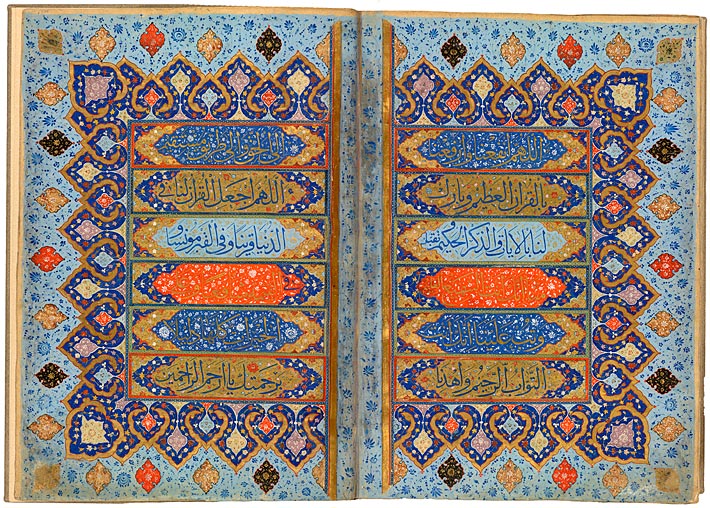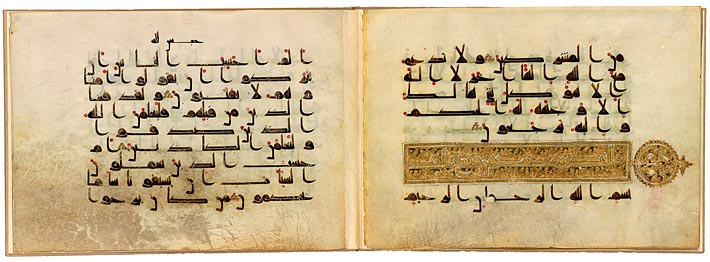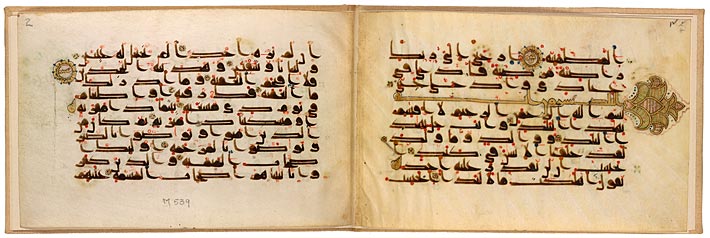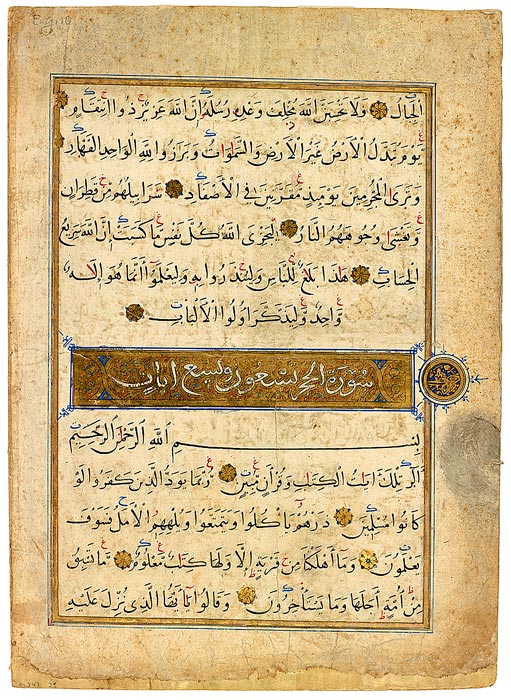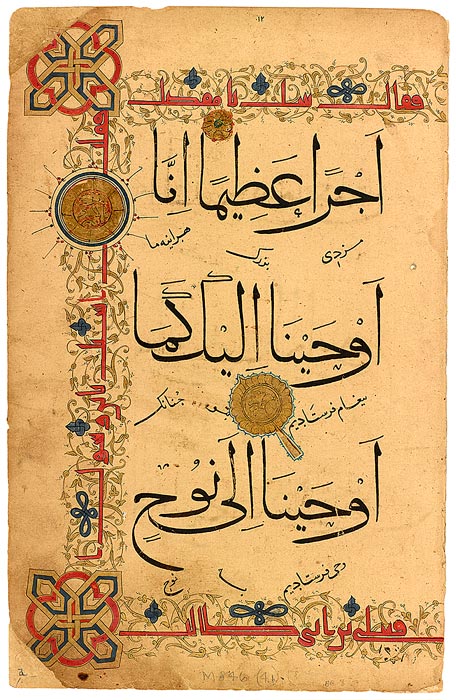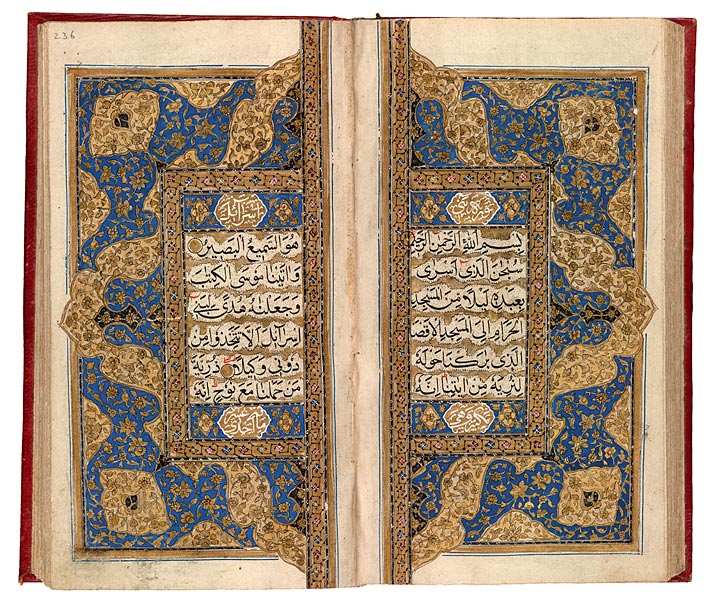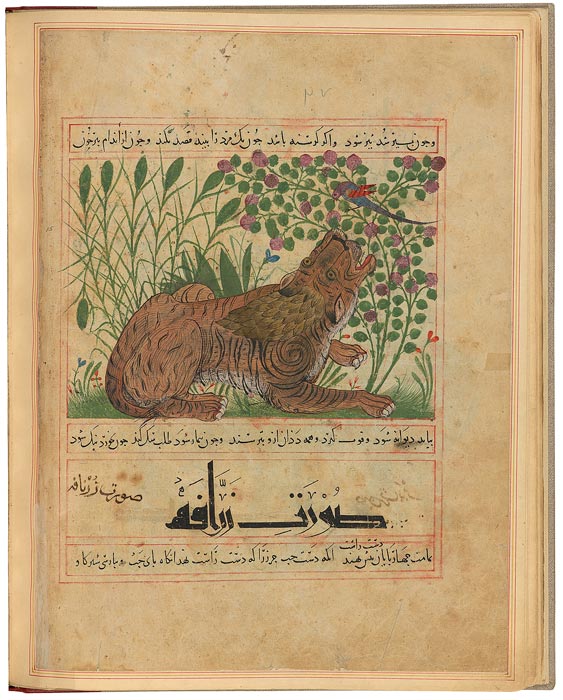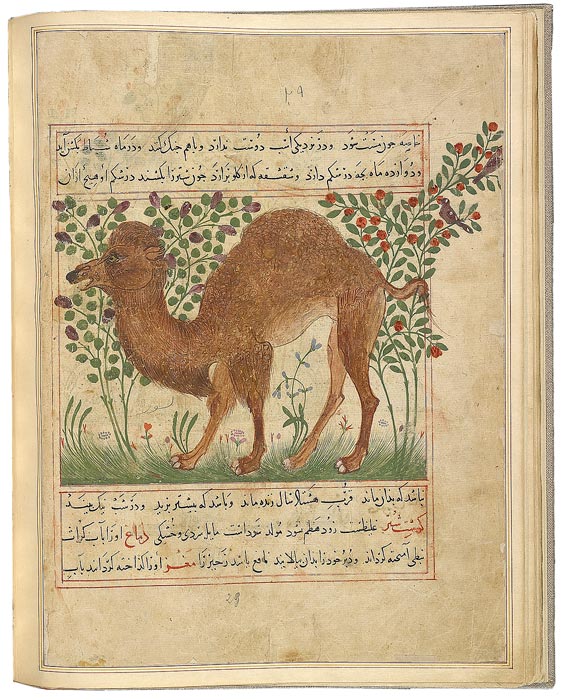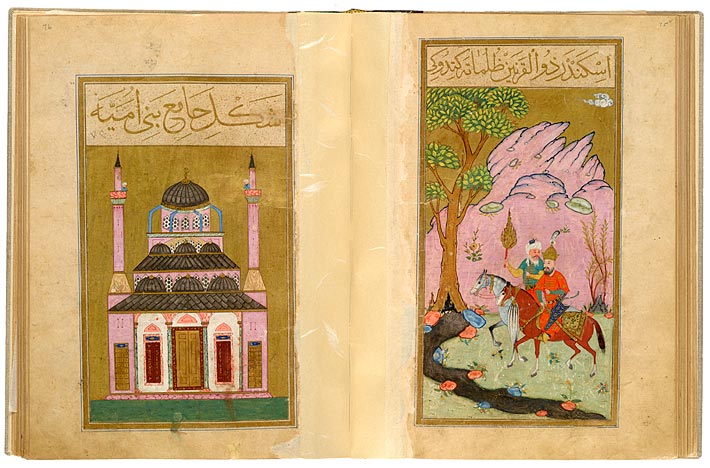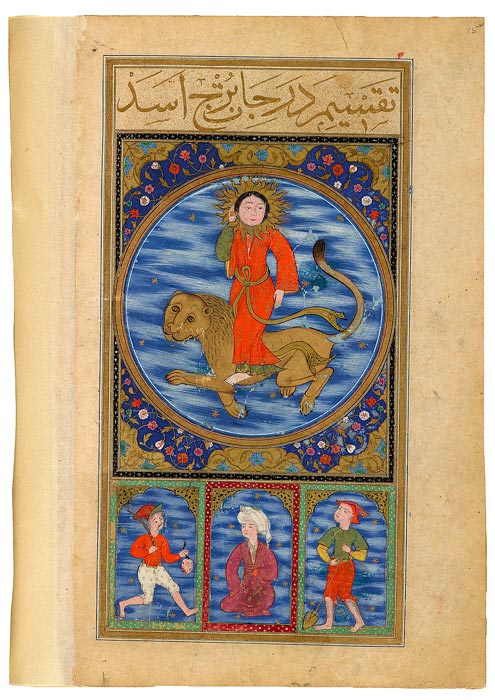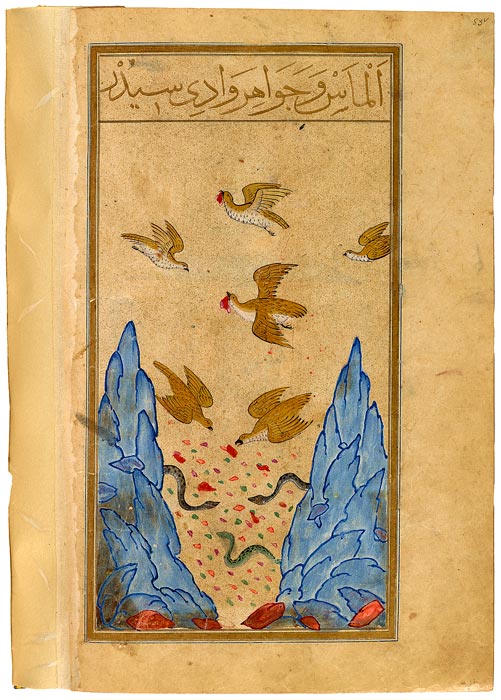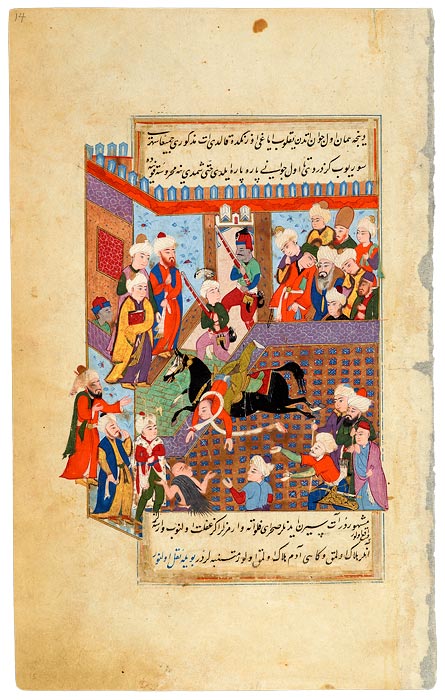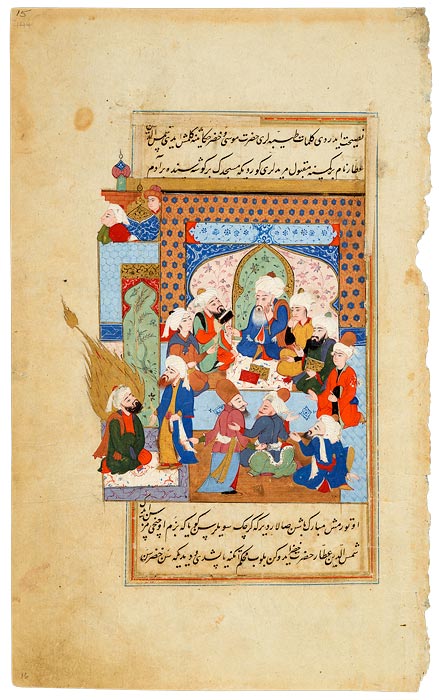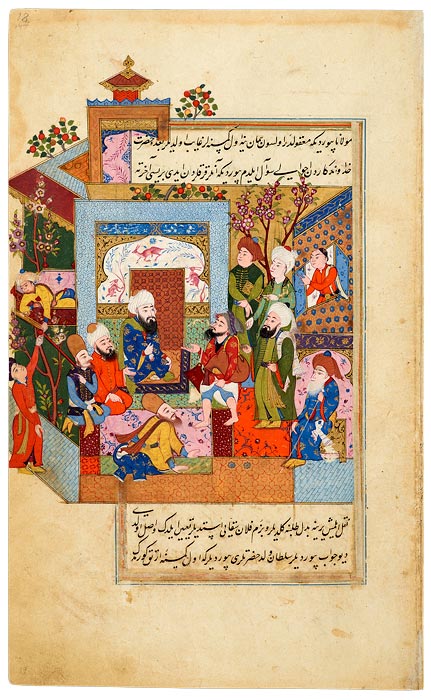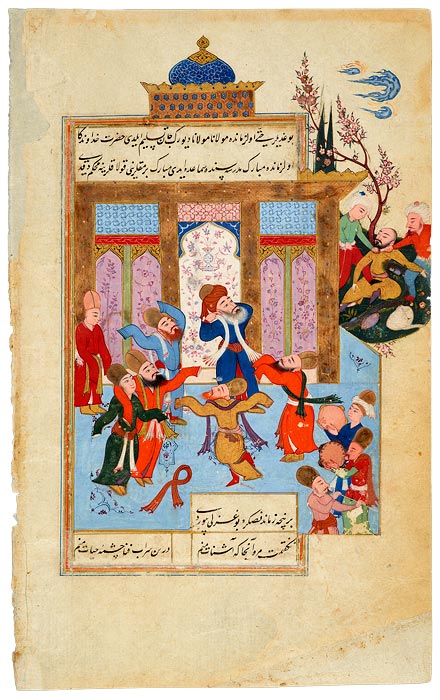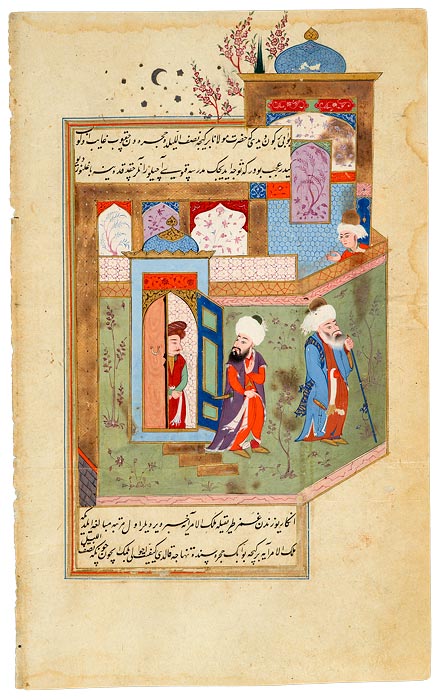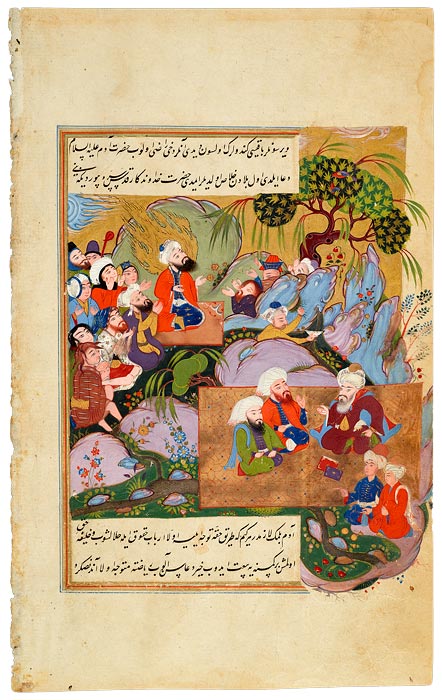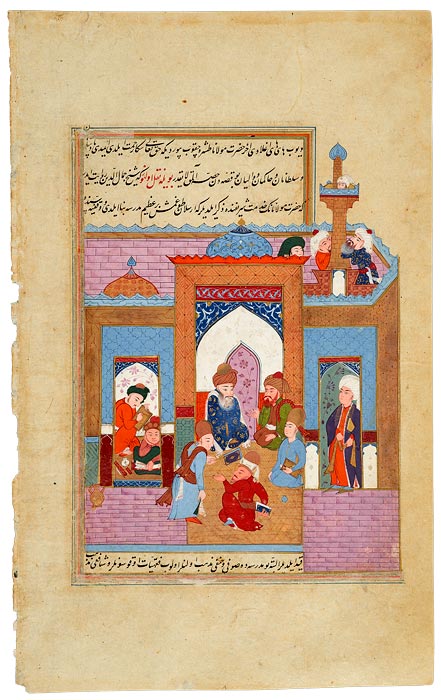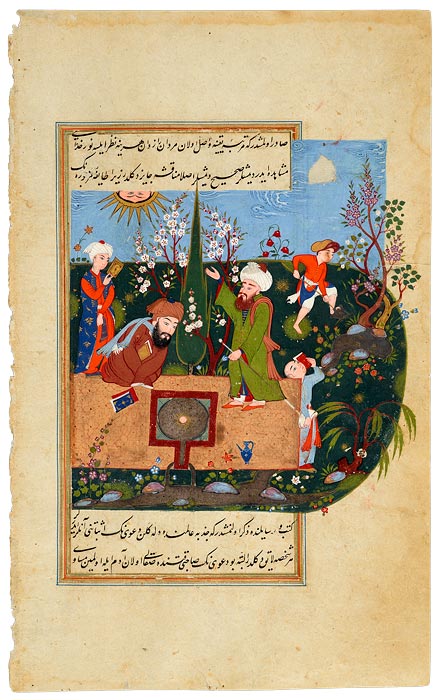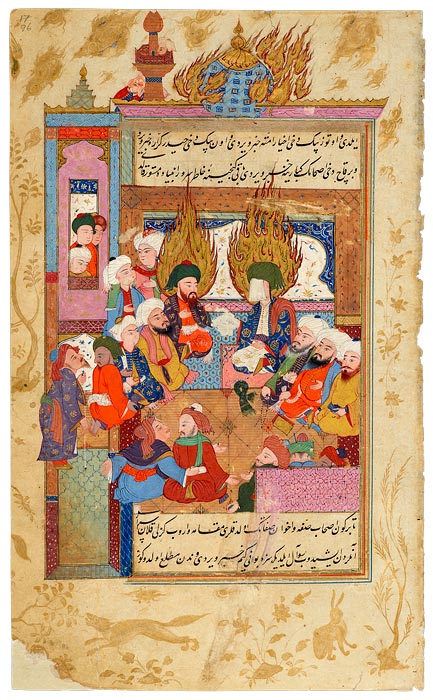Treasures of Islamic Manuscript Painting from the Morgan
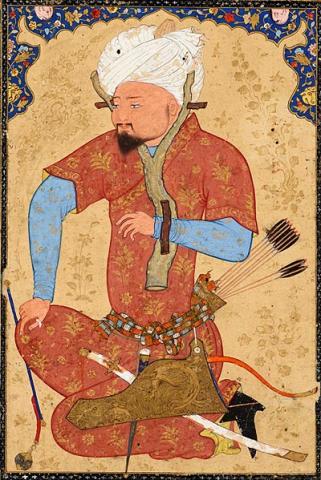
Introduction
Although the Morgan is well known for its collection of medieval and Renaissance manuscripts, it also holds important Islamic manuscripts full of extraordinary paintings. Since Islam refers to both the religious faith and civilization of Muslims, this online exhibition includes both religious and secular texts. Just as the Qur˒an is central to Islamic life, it is also the centerpiece of this presentation, followed by manuscript pages that illustrate works of science, biography, history, and poetry. Included are such important manuscripts as the Manāfi˓-i hayavān (The Benefits of Animals)—one of the finest surviving Persian examples—and the richest illustrated life of the beloved poet Rūmī (1207–1273). Also featured are pages from the Mughal and Persian albums that Pierpont Morgan acquired in 1911 from Sir Charles Hercules Read, Keeper of British and Medieval Antiquities at the British Museum, and miniatures illustrating the work of great Persian poets.
To learn more about the art and culture of the Islamic world visit The Metropolitan Museum of Art's new Galleries for the Art of the Arab Lands, Turkey, Iran, Central Asia, and Later South Asia.
We are indebted to Barbara Schmitz for the research published in her invaluable 1997 catalogue Islamic and Indian Manuscript Paintings in the Pierpont Morgan Library, which also includes contributions by Pratapaditya Pal, Wheeler M. Thackston, and William M. Voelkle.
This online exhibition was created in association with the exhibition Treasures of Islamic Manuscript Painting from the Morgan, on view 21 October 2011 through 29 January 2012, organized by William Voelkle, curator and head of the Department of Medieval and Renaissance Manuscripts. The exhibition is supported in part by a generous grant from the Hagop Kevorkian Fund and by the Janine Luke and Melvin R. Seiden Fund for Exhibitions and Publications.
An Uzbek Prisoner
Leaf from the Read Persian Album. Probably Herat (Afghanistan), ca. 1600.
Purchased by Pierpont Morgan, 1911.; MS M.386.2.
Overview
The Qur˒an, the Holy Book of Islam
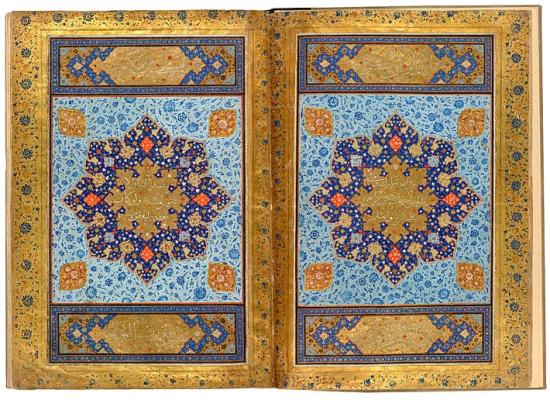
The Jerrāḥ Pasha Qur˒an
Qur˒an, in Arabic.
Purchased by Pierpont Morgan, before 1913
This gigantic Qur˒an (19 x 13 1/2 inches) was made in Shiraz about 1580. In 1719–20 it was given by Sultan Aḥmad III to the mosque of Jerrāḥ Pasha in Dikili Tash in Istanbul. The opening pages express the majesty and magnificence of the Qur˒an. Within the facing sunbursts are inscribed the words from sura 17.88: God, blessed and exalted is he, said, say, if mankind and the jinn collaborated to produce the likes of this Qur˒an, they will not produce its like even if they assist one another. The jinn were pre-Adam angels cast down with Iblīs (Satan). Within the four cartouches are the words from sura 56.77–9: It is the noble Qur˒an, in a Book well guarded, which none shall touch but those who are clean.
The Qur˒an, the Holy Book of Islam
From a monumental volume used in an Istanbul mosque to a miniature Persian version that served as a talisman, this section features examples of illuminated pages from the holy book of Islam. The Qur˒an (to recite) represents the codification of the words of God that were revealed and transmitted through the angel Gabriel to the prophet Muḥammad (ca. 570–632) over a period of twenty-three years. The visions began in 610 in a cave on Mount Hira near Mecca, his birthplace, and continued after his 622 flight to Medina, until his death. His flight—the Hijra—marks the beginning of the Islamic calendar.
The revelations were arranged into 114 suras (chapters), each named after its theme. The first and shortest ones, at the end of the book, from the Meccan period, establish Muḥammad as the final prophet in a line of monotheists, including Abraham and Jesus. The longest suras, placed at the beginning, are Medinan and deal more with social and political issues.
For centuries, Qur˒ans were written in Arabic, the language of transmission. After Muḥammad's death, his cousin ˓Alī and others compiled the revelations into a text. About twenty years later, under Uthman, the third caliph (644–656) succeeding Muḥammad, a standard version of the Qur˒an —essentially the one used today—was produced. Thereafter Islam (which means "surrender to God") spread from the Arabian Peninsula throughout the Middle East, to northern Africa and southern Spain, and eventually the world.
Jerrāḥ Pasha Qur˒an fols. 2v–3r
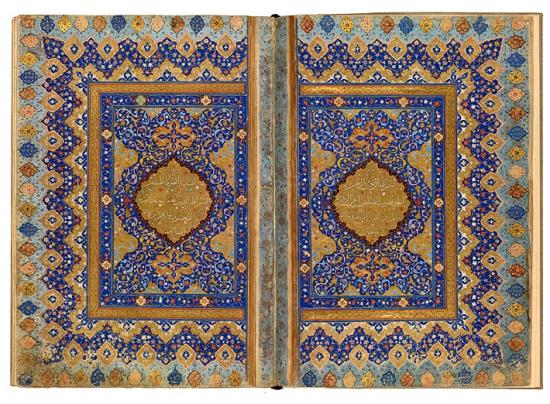
The First Sura of the Jerrāḥ Pasha Qur˒an
Qur˒an, in Arabic
Purchased by Pierpont Morgan, before 1913
This is the second pair of richly decorated facing pages in the Jerrāḥ Pasha Qur˒an, made in Shiraz about 1580. It marks the beginning of the Qur˒an itself, starting with sura 1 (al-Fātiḥa, or "The Opening Chapter"). The five lines of text on each page are enclosed within a gold-lobed medallion. They are written in raiḥān (sweet basil) script, which was much favored by poets, for its very name evoked its fragrance. Muḥammad Aṣlaḥ, an eighteenth-century poet, even wrote that real gardens would envy the raiḥān twig "lifting its head from the bismillah (call to piety)." The first line contains the title of the sura, followed by the call to piety, the bismillah: In the name of God, the Merciful, the Compassionate. The sura is continued on the left page. Each sura (except the ninth) begins with the bismillah. This double-opening, and the three others in the manuscript, closely resemble the work of the Ottoman master gilder Muḥammad ibn Tāj al-Dīn Ḥaidar (d. 1588).
The Qur˒an, the Holy Book of Islam
From a monumental volume used in an Istanbul mosque to a miniature Persian version that served as a talisman, this section features examples of illuminated pages from the holy book of Islam. The Qur˒an (to recite) represents the codification of the words of God that were revealed and transmitted through the angel Gabriel to the prophet Muḥammad (ca. 570–632) over a period of twenty-three years. The visions began in 610 in a cave on Mount Hira near Mecca, his birthplace, and continued after his 622 flight to Medina, until his death. His flight—the Hijra—marks the beginning of the Islamic calendar.
The revelations were arranged into 114 suras (chapters), each named after its theme. The first and shortest ones, at the end of the book, from the Meccan period, establish Muḥammad as the final prophet in a line of monotheists, including Abraham and Jesus. The longest suras, placed at the beginning, are Medinan and deal more with social and political issues.
For centuries, Qur˒ans were written in Arabic, the language of transmission. After Muḥammad's death, his cousin ˓Alī and others compiled the revelations into a text. About twenty years later, under Uthman, the third caliph (644–656) succeeding Muḥammad, a standard version of the Qur˒an —essentially the one used today—was produced. Thereafter Islam (which means "surrender to God") spread from the Arabian Peninsula throughout the Middle East, to northern Africa and southern Spain, and eventually the world.
Jerrāḥ Pasha Qur˒an fols. 274v–275r
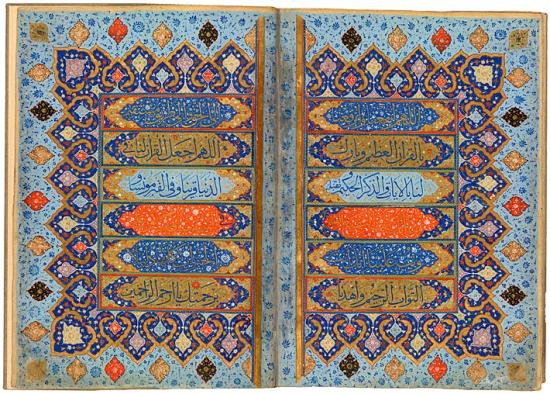
Closing Prayer in the Jerrāḥ Pasha Qur˒an
Qur˒an, in Arabic
Purchased by Pierpont Morgan, before 1913
This is the first of two pairs of elaborately ornamental facing pages that appear at the end of the Jerrāḥ Pasha Qur˒an, made in Shiraz about 1580. It enshrines a prayer written in twelve lines: Oh God, profit us and raise us through the magnificent Qur˒an, and bless us and accept the verses [we read] and the wise repetition [we make]... Turn toward us, for You are the Merciful One Who accepts the penitent, and guide us to the truth and to a straight path. Oh God, make for us the Qur˒an a constant companion in this world, a consoler to the grave, and... a guide for all good works, through Your mercy, oh Most Merciful.
The Qur˒an, the Holy Book of Islam
From a monumental volume used in an Istanbul mosque to a miniature Persian version that served as a talisman, this section features examples of illuminated pages from the holy book of Islam. The Qur˒an (to recite) represents the codification of the words of God that were revealed and transmitted through the angel Gabriel to the prophet Muḥammad (ca. 570–632) over a period of twenty-three years. The visions began in 610 in a cave on Mount Hira near Mecca, his birthplace, and continued after his 622 flight to Medina, until his death. His flight—the Hijra—marks the beginning of the Islamic calendar.
The revelations were arranged into 114 suras (chapters), each named after its theme. The first and shortest ones, at the end of the book, from the Meccan period, establish Muḥammad as the final prophet in a line of monotheists, including Abraham and Jesus. The longest suras, placed at the beginning, are Medinan and deal more with social and political issues.
For centuries, Qur˒ans were written in Arabic, the language of transmission. After Muḥammad's death, his cousin ˓Alī and others compiled the revelations into a text. About twenty years later, under Uthman, the third caliph (644–656) succeeding Muḥammad, a standard version of the Qur˒an —essentially the one used today—was produced. Thereafter Islam (which means "surrender to God") spread from the Arabian Peninsula throughout the Middle East, to northern Africa and southern Spain, and eventually the world.
Jerrāḥ Pasha Qur˒an fols. 275v–276r
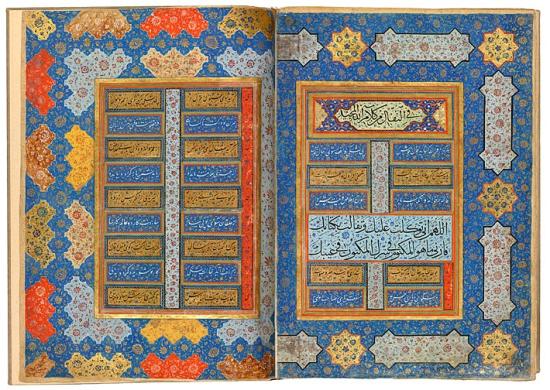
Auguries from the Jerrāḥ Pasha Qur˒an
Qur˒an, in Arabic
Purchased by Pierpont Morgan, before 1913
The second pair of decorated facing pages at the end of the Jerrāḥ Pasha Qur˒an contains texts relating to the taking of auguries from the Qur˒an, with an interpretation for each letter of the alphabet. There is a break in the sequence, indicating a missing folio. The headings are in muḥaqqaq script and the lines of poetry are in nasta˓līq script. According to tradition, muḥaqqaq, meaning "accurate", or "well-organized," was the first script to be regularized.
The Qur˒an, the Holy Book of Islam
From a monumental volume used in an Istanbul mosque to a miniature Persian version that served as a talisman, this section features examples of illuminated pages from the holy book of Islam. The Qur˒an (to recite) represents the codification of the words of God that were revealed and transmitted through the angel Gabriel to the prophet Muḥammad (ca. 570–632) over a period of twenty-three years. The visions began in 610 in a cave on Mount Hira near Mecca, his birthplace, and continued after his 622 flight to Medina, until his death. His flight—the Hijra—marks the beginning of the Islamic calendar.
The revelations were arranged into 114 suras (chapters), each named after its theme. The first and shortest ones, at the end of the book, from the Meccan period, establish Muḥammad as the final prophet in a line of monotheists, including Abraham and Jesus. The longest suras, placed at the beginning, are Medinan and deal more with social and political issues.
For centuries, Qur˒ans were written in Arabic, the language of transmission. After Muḥammad's death, his cousin ˓Alī and others compiled the revelations into a text. About twenty years later, under Uthman, the third caliph (644–656) succeeding Muḥammad, a standard version of the Qur˒an —essentially the one used today—was produced. Thereafter Islam (which means "surrender to God") spread from the Arabian Peninsula throughout the Middle East, to northern Africa and southern Spain, and eventually the world.
Jerrāḥ Pasha Qur˒an fol. 276v
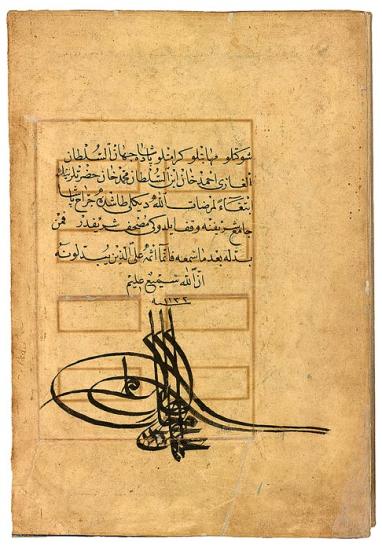
Presentation Page in the Jerrāḥ Pasha Qur˒an
Qur˒an, in Arabic
Purchased by Pierpont Morgan, before 1913
The last page of this Qur˒an contains a lengthy inscription stating that this copy was a pious gift to the holy mosque of Jerrāḥ Pasha in Dikili Tash in Istanbul in the time of "his exalted personage, the imperial, majestic, generous, padishah of the world, the victorious Sultan Aḥmad Khān, son of Sultan Muḥammad Khān, in the year of the Hijra 1131 (1719–20), may God be well pleased [with him]." Beneath the inscription is the magnificent tughra (official signature) of Aḥmad III.
The Qur˒an, the Holy Book of Islam
From a monumental volume used in an Istanbul mosque to a miniature Persian version that served as a talisman, this section features examples of illuminated pages from the holy book of Islam. The Qur˒an (to recite) represents the codification of the words of God that were revealed and transmitted through the angel Gabriel to the prophet Muḥammad (ca. 570–632) over a period of twenty-three years. The visions began in 610 in a cave on Mount Hira near Mecca, his birthplace, and continued after his 622 flight to Medina, until his death. His flight—the Hijra—marks the beginning of the Islamic calendar.
The revelations were arranged into 114 suras (chapters), each named after its theme. The first and shortest ones, at the end of the book, from the Meccan period, establish Muḥammad as the final prophet in a line of monotheists, including Abraham and Jesus. The longest suras, placed at the beginning, are Medinan and deal more with social and political issues.
For centuries, Qur˒ans were written in Arabic, the language of transmission. After Muḥammad's death, his cousin ˓Alī and others compiled the revelations into a text. About twenty years later, under Uthman, the third caliph (644–656) succeeding Muḥammad, a standard version of the Qur˒an —essentially the one used today—was produced. Thereafter Islam (which means "surrender to God") spread from the Arabian Peninsula throughout the Middle East, to northern Africa and southern Spain, and eventually the world.
Miniature Qur˒an and Banner Box
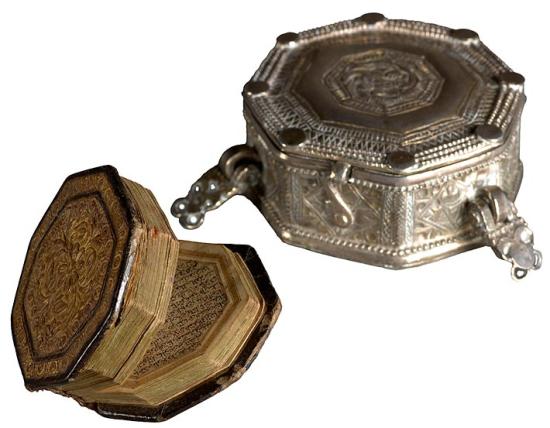
Miniature Qur˒an and Banner Box
Qur˒an, in Arabic
Bequest of Julia Wightman, 1994
Such miniature Qur˒ans are called sancak, after the standard-bearers (sancakdār) who attached them to military flags, where they served as talismans. Travelers also wore them as good-luck charms. This seventeenth-century octagonal example from Persia, which is about an inch and a half tall, is bound on one side and has sixteen lines of text per page. The silver banner box is nineteenth century.
The Qur˒an, the Holy Book of Islam
From a monumental volume used in an Istanbul mosque to a miniature Persian version that served as a talisman, this section features examples of illuminated pages from the holy book of Islam. The Qur˒an (to recite) represents the codification of the words of God that were revealed and transmitted through the angel Gabriel to the prophet Muḥammad (ca. 570–632) over a period of twenty-three years. The visions began in 610 in a cave on Mount Hira near Mecca, his birthplace, and continued after his 622 flight to Medina, until his death. His flight—the Hijra—marks the beginning of the Islamic calendar.
The revelations were arranged into 114 suras (chapters), each named after its theme. The first and shortest ones, at the end of the book, from the Meccan period, establish Muḥammad as the final prophet in a line of monotheists, including Abraham and Jesus. The longest suras, placed at the beginning, are Medinan and deal more with social and political issues.
For centuries, Qur˒ans were written in Arabic, the language of transmission. After Muḥammad's death, his cousin ˓Alī and others compiled the revelations into a text. About twenty years later, under Uthman, the third caliph (644–656) succeeding Muḥammad, a standard version of the Qur˒an —essentially the one used today—was produced. Thereafter Islam (which means "surrender to God") spread from the Arabian Peninsula throughout the Middle East, to northern Africa and southern Spain, and eventually the world.
Early Tenth-Century Qur˒an
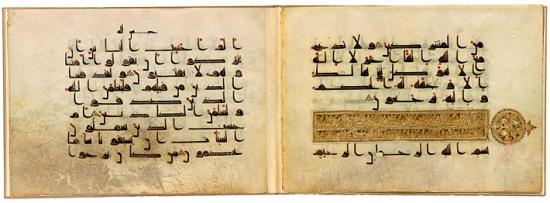
Fragment from an Early Tenth-Century Qur˒an
Qur˒an fragment, in Arabic
Purchased by J. P. Morgan, Jr., 1915
Although the earliest vellum Qur˒ans (late seventh to eighth centuries) were vertical in format, those of the ninth to eleventh centuries were oblong, perhaps inspired by the Kufic script, and featured oblong panels inscribed with Qur˒anic verses. Other folios from this manuscript are preserved in the Chester Beatty Library, Dublin, the Topkapi Palace Museum, Istanbul, and elsewhere, one stating that ˓Abd al-Mun˓im Ibn Aḥmad donated the Qur˒an to the Great Mosque of Damascus during July 911. The Morgan fragment contains suras 27 to 29. Shown here is the heading for sura 29 (al-˓Ankabūt, or "The Spider"), which is written in gold. The name is derived from those who, taking protectors other than Allah, are likened to spiders who build flimsy homes. The diacriticals consist of short diagonal lines, and red dots indicate vocalizations. Pyramids of six gold discs mark the ends of ayat (verses).
The Qur˒an, the Holy Book of Islam
From a monumental volume used in an Istanbul mosque to a miniature Persian version that served as a talisman, this section features examples of illuminated pages from the holy book of Islam. The Qur˒an (to recite) represents the codification of the words of God that were revealed and transmitted through the angel Gabriel to the prophet Muḥammad (ca. 570–632) over a period of twenty-three years. The visions began in 610 in a cave on Mount Hira near Mecca, his birthplace, and continued after his 622 flight to Medina, until his death. His flight—the Hijra—marks the beginning of the Islamic calendar.
The revelations were arranged into 114 suras (chapters), each named after its theme. The first and shortest ones, at the end of the book, from the Meccan period, establish Muḥammad as the final prophet in a line of monotheists, including Abraham and Jesus. The longest suras, placed at the beginning, are Medinan and deal more with social and political issues.
For centuries, Qur˒ans were written in Arabic, the language of transmission. After Muḥammad's death, his cousin ˓Alī and others compiled the revelations into a text. About twenty years later, under Uthman, the third caliph (644–656) succeeding Muḥammad, a standard version of the Qur˒an —essentially the one used today—was produced. Thereafter Islam (which means "surrender to God") spread from the Arabian Peninsula throughout the Middle East, to northern Africa and southern Spain, and eventually the world.
Tenth-Century Qur˒an

Fragment from a Tenth-Century Qur˒an
Qur˒an fragment, in Arabic
Purchased by J. P. Morgan, 1922
Qur˒ans could be in one or multiple volumes, sometimes as many as thirty, in which each volume contained a thirtieth of the text, called a juz˒. The division was especially popular because of the thirty-day holy month of Ramadan, when the entire Qur˒an could be read at the pace of a volume each day. The present fragment, however, was part of a smaller set, as two bands of illumination mark the end of juz˒ 21, which falls at sura 33.31 (al-Aḥzāb, or "The Confederates"). Voweling and diacritics are mostly in red. The gold rosette at the left marks the end of a tenth verse.
The Qur˒an, the Holy Book of Islam
From a monumental volume used in an Istanbul mosque to a miniature Persian version that served as a talisman, this section features examples of illuminated pages from the holy book of Islam. The Qur˒an (to recite) represents the codification of the words of God that were revealed and transmitted through the angel Gabriel to the prophet Muḥammad (ca. 570–632) over a period of twenty-three years. The visions began in 610 in a cave on Mount Hira near Mecca, his birthplace, and continued after his 622 flight to Medina, until his death. His flight—the Hijra—marks the beginning of the Islamic calendar.
The revelations were arranged into 114 suras (chapters), each named after its theme. The first and shortest ones, at the end of the book, from the Meccan period, establish Muḥammad as the final prophet in a line of monotheists, including Abraham and Jesus. The longest suras, placed at the beginning, are Medinan and deal more with social and political issues.
For centuries, Qur˒ans were written in Arabic, the language of transmission. After Muḥammad's death, his cousin ˓Alī and others compiled the revelations into a text. About twenty years later, under Uthman, the third caliph (644–656) succeeding Muḥammad, a standard version of the Qur˒an —essentially the one used today—was produced. Thereafter Islam (which means "surrender to God") spread from the Arabian Peninsula throughout the Middle East, to northern Africa and southern Spain, and eventually the world.
Tenth-Century Qur˒an
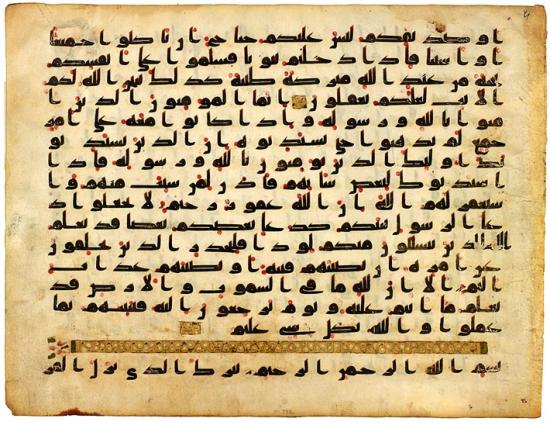
Folio from a Tenth-Century Qur˒an
Qur˒an leaf, in Arabic
Gift of Belle da Costa Greene, 1941
The text is written in Kufic, named after al-Kufah, the Iraqi town where the script supposedly originated. Red dots mark vowels, and each tenth verse is marked by a small, gold rectangle. On this leaf a thin gold band indicates the end of sura 24 (al-Nūr, or "Light") and the beginning of sura 25 (al-Furqān, or "The Criterion"). The Criterion is Allah's great gift to humanity, allowing it to judge between right and wrong. Each sura (except the ninth) begins with a call to piety, the bismillah, In the name of God, the Merciful, the Compassionate.
The Qur˒an, the Holy Book of Islam
From a monumental volume used in an Istanbul mosque to a miniature Persian version that served as a talisman, this section features examples of illuminated pages from the holy book of Islam. The Qur˒an (to recite) represents the codification of the words of God that were revealed and transmitted through the angel Gabriel to the prophet Muḥammad (ca. 570–632) over a period of twenty-three years. The visions began in 610 in a cave on Mount Hira near Mecca, his birthplace, and continued after his 622 flight to Medina, until his death. His flight—the Hijra—marks the beginning of the Islamic calendar.
The revelations were arranged into 114 suras (chapters), each named after its theme. The first and shortest ones, at the end of the book, from the Meccan period, establish Muḥammad as the final prophet in a line of monotheists, including Abraham and Jesus. The longest suras, placed at the beginning, are Medinan and deal more with social and political issues.
For centuries, Qur˒ans were written in Arabic, the language of transmission. After Muḥammad's death, his cousin ˓Alī and others compiled the revelations into a text. About twenty years later, under Uthman, the third caliph (644–656) succeeding Muḥammad, a standard version of the Qur˒an —essentially the one used today—was produced. Thereafter Islam (which means "surrender to God") spread from the Arabian Peninsula throughout the Middle East, to northern Africa and southern Spain, and eventually the world.
Tenth-Century Qur˒an
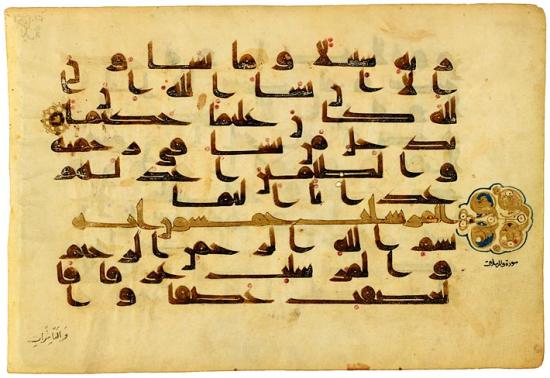
Page from an Oblong Tenth-Century Qur˒an
Qur˒an leaf, in Arabic
Bequest of Belle da Costa Greene, 1950
This is a typical vellum page from an oblong Qur˒an. The script is Kufic, and the red dots indicate vocalization. Every fifth verse is followed by a gold Arabic letter hā˒ (h, which has the numerical value of five; appears on the recto), and every tenth verse by a gold rosette. The heading to sura 77 (al-Mursalāt, or "Those Sent Forth") contains the first line of the sura in gold Kufic script and terminates in a palmette. The name of the sura is written, in cursive script, below the palmette.
The Qur˒an, the Holy Book of Islam
From a monumental volume used in an Istanbul mosque to a miniature Persian version that served as a talisman, this section features examples of illuminated pages from the holy book of Islam. The Qur˒an (to recite) represents the codification of the words of God that were revealed and transmitted through the angel Gabriel to the prophet Muḥammad (ca. 570–632) over a period of twenty-three years. The visions began in 610 in a cave on Mount Hira near Mecca, his birthplace, and continued after his 622 flight to Medina, until his death. His flight—the Hijra—marks the beginning of the Islamic calendar.
The revelations were arranged into 114 suras (chapters), each named after its theme. The first and shortest ones, at the end of the book, from the Meccan period, establish Muḥammad as the final prophet in a line of monotheists, including Abraham and Jesus. The longest suras, placed at the beginning, are Medinan and deal more with social and political issues.
For centuries, Qur˒ans were written in Arabic, the language of transmission. After Muḥammad's death, his cousin ˓Alī and others compiled the revelations into a text. About twenty years later, under Uthman, the third caliph (644–656) succeeding Muḥammad, a standard version of the Qur˒an —essentially the one used today—was produced. Thereafter Islam (which means "surrender to God") spread from the Arabian Peninsula throughout the Middle East, to northern Africa and southern Spain, and eventually the world.
Eleventh-Century Qur˒an
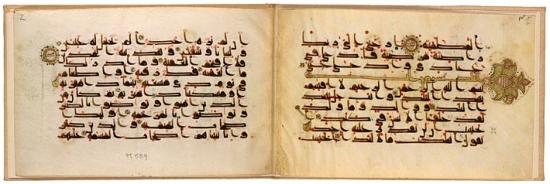
Two Folios from an Eleventh-Century Qur˒an
Qur˒an fragment, in Arabic
Purchased by J. P. Morgan, Jr., 1915
During Muḥammad's lifetime, Islam spread from Mecca and Medina, covering the entire Arabian Peninsula. From there, the new religion expanded throughout the Near East, northern Africa, and southern Spain. Other leaves from this Qur˒an are preserved in the Chester Beatty Library, Dublin, and in the Museum of Turkish and Islamic Art, Istanbul. Written in Kufic, every fifth verse is followed by a gold letter hā˒ (which has a numerical value of five), and every tenth verse by a gold disc with the cumulative number of verses. The color scheme of the palmette projecting from the heading for sura 90 (al-Balad, or "The City"), a combination of wine red and green with gold and blue, is typical for the western Islamic world, suggesting an origin in northern Africa or southern Spain.
The Qur˒an, the Holy Book of Islam
From a monumental volume used in an Istanbul mosque to a miniature Persian version that served as a talisman, this section features examples of illuminated pages from the holy book of Islam. The Qur˒an (to recite) represents the codification of the words of God that were revealed and transmitted through the angel Gabriel to the prophet Muḥammad (ca. 570–632) over a period of twenty-three years. The visions began in 610 in a cave on Mount Hira near Mecca, his birthplace, and continued after his 622 flight to Medina, until his death. His flight—the Hijra—marks the beginning of the Islamic calendar.
The revelations were arranged into 114 suras (chapters), each named after its theme. The first and shortest ones, at the end of the book, from the Meccan period, establish Muḥammad as the final prophet in a line of monotheists, including Abraham and Jesus. The longest suras, placed at the beginning, are Medinan and deal more with social and political issues.
For centuries, Qur˒ans were written in Arabic, the language of transmission. After Muḥammad's death, his cousin ˓Alī and others compiled the revelations into a text. About twenty years later, under Uthman, the third caliph (644–656) succeeding Muḥammad, a standard version of the Qur˒an —essentially the one used today—was produced. Thereafter Islam (which means "surrender to God") spread from the Arabian Peninsula throughout the Middle East, to northern Africa and southern Spain, and eventually the world.
Maghribi Qur˒an
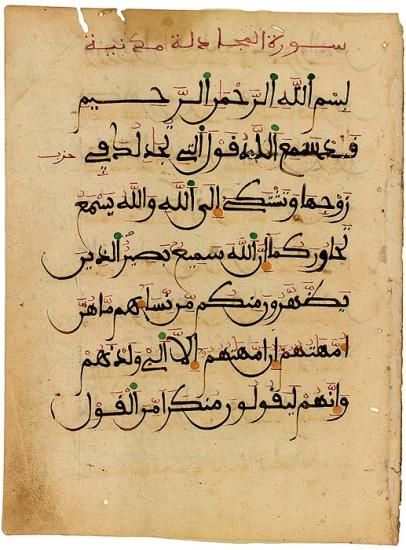
Folio from a Maghribi Qur˒an
Leaf from a Qur˒an, in Arabic
Gift of Mr. and Mrs. Milton Freudenheim in memory of Otto F. Ege, 1985
Qur˒ans produced in the Maghrib (northwestern Africa and Spain) were written in a distinct script—Maghribi—named after the area where it was used. This example, from Morocco, is written in a dark brown ink. Voweling and the sura title are in mauve, yellow dots indicate diacriticals, and green dots appear only above initial alifs (a's). The text is the beginning of sura 58 (al-Mujādila, or "She Who Pleaded"). An early paper example, it is in a vertical format and dates from the twelfth to fourteenth centuries.
The Qur˒an, the Holy Book of Islam
From a monumental volume used in an Istanbul mosque to a miniature Persian version that served as a talisman, this section features examples of illuminated pages from the holy book of Islam. The Qur˒an (to recite) represents the codification of the words of God that were revealed and transmitted through the angel Gabriel to the prophet Muḥammad (ca. 570–632) over a period of twenty-three years. The visions began in 610 in a cave on Mount Hira near Mecca, his birthplace, and continued after his 622 flight to Medina, until his death. His flight—the Hijra—marks the beginning of the Islamic calendar.
The revelations were arranged into 114 suras (chapters), each named after its theme. The first and shortest ones, at the end of the book, from the Meccan period, establish Muḥammad as the final prophet in a line of monotheists, including Abraham and Jesus. The longest suras, placed at the beginning, are Medinan and deal more with social and political issues.
For centuries, Qur˒ans were written in Arabic, the language of transmission. After Muḥammad's death, his cousin ˓Alī and others compiled the revelations into a text. About twenty years later, under Uthman, the third caliph (644–656) succeeding Muḥammad, a standard version of the Qur˒an —essentially the one used today—was produced. Thereafter Islam (which means "surrender to God") spread from the Arabian Peninsula throughout the Middle East, to northern Africa and southern Spain, and eventually the world.
Mamluk Qur˒an
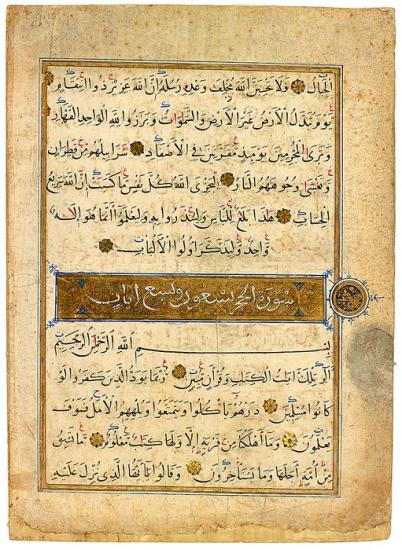
Bifolio from a Mamluk Qur˒an
Bifolio from a Qur˒an, in Arabic
Bequest of Belle da Costa Greene, 1950
With the increased use of paper and the adoption of more upright scripts, the oblong format of the early vellum Qur˒ans gave way to a vertical one. On this page a large heading in white, cursive script marks the beginning of sura 15 (al-Ḥijr, or "The Rocky Tract").The heading is followed by the usual bismillah (call to piety), and the sura text begins on the next line. The sura is in naskh script with vocalizations and diacriticals in black. There are reading marks in red and blue, and rosettes mark the ends of verses.
The Qur˒an, the Holy Book of Islam
From a monumental volume used in an Istanbul mosque to a miniature Persian version that served as a talisman, this section features examples of illuminated pages from the holy book of Islam. The Qur˒an (to recite) represents the codification of the words of God that were revealed and transmitted through the angel Gabriel to the prophet Muḥammad (ca. 570–632) over a period of twenty-three years. The visions began in 610 in a cave on Mount Hira near Mecca, his birthplace, and continued after his 622 flight to Medina, until his death. His flight—the Hijra—marks the beginning of the Islamic calendar.
The revelations were arranged into 114 suras (chapters), each named after its theme. The first and shortest ones, at the end of the book, from the Meccan period, establish Muḥammad as the final prophet in a line of monotheists, including Abraham and Jesus. The longest suras, placed at the beginning, are Medinan and deal more with social and political issues.
For centuries, Qur˒ans were written in Arabic, the language of transmission. After Muḥammad's death, his cousin ˓Alī and others compiled the revelations into a text. About twenty years later, under Uthman, the third caliph (644–656) succeeding Muḥammad, a standard version of the Qur˒an —essentially the one used today—was produced. Thereafter Islam (which means "surrender to God") spread from the Arabian Peninsula throughout the Middle East, to northern Africa and southern Spain, and eventually the world.
Qur˒an Leaf
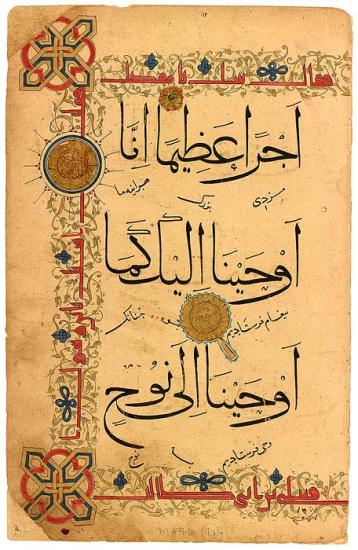
Qur˒an Leaf with Interlinear Persian Translation
Qur˒an leaf, in Arabic and Persian
Bequest of Belle da Costa Greene, 1950
In this unusual leaf, verses 162–63 of sura 4 (al-Nisā˒, or "Woman") are written in a thuluth-muḥaqqaq script, while an interlinear Persian translation, in a small, cursive script, is written diagonally beneath the lines. Of special interest are the red Kufic inscriptions in the border, a Shi˓ite hadith (a saying of Muḥammad), which suggests the danger of independent Qur˒anic interpretation: A question was asked about the son of the Messenger [of God] and ˓Alī Ibn Abī ṭālib said, Woe unto you, O Qatāda, if you interpret the Qur˒an by yourself. The purpose of the central gold medallion is unknown. Other leaves from the manuscript are in the Chester Beatty Library, Dublin, and in the Freer Gallery, Washington, D.C.
The Qur˒an, the Holy Book of Islam
From a monumental volume used in an Istanbul mosque to a miniature Persian version that served as a talisman, this section features examples of illuminated pages from the holy book of Islam. The Qur˒an (to recite) represents the codification of the words of God that were revealed and transmitted through the angel Gabriel to the prophet Muḥammad (ca. 570–632) over a period of twenty-three years. The visions began in 610 in a cave on Mount Hira near Mecca, his birthplace, and continued after his 622 flight to Medina, until his death. His flight—the Hijra—marks the beginning of the Islamic calendar.
The revelations were arranged into 114 suras (chapters), each named after its theme. The first and shortest ones, at the end of the book, from the Meccan period, establish Muḥammad as the final prophet in a line of monotheists, including Abraham and Jesus. The longest suras, placed at the beginning, are Medinan and deal more with social and political issues.
For centuries, Qur˒ans were written in Arabic, the language of transmission. After Muḥammad's death, his cousin ˓Alī and others compiled the revelations into a text. About twenty years later, under Uthman, the third caliph (644–656) succeeding Muḥammad, a standard version of the Qur˒an —essentially the one used today—was produced. Thereafter Islam (which means "surrender to God") spread from the Arabian Peninsula throughout the Middle East, to northern Africa and southern Spain, and eventually the world.
Washing Before Prayer
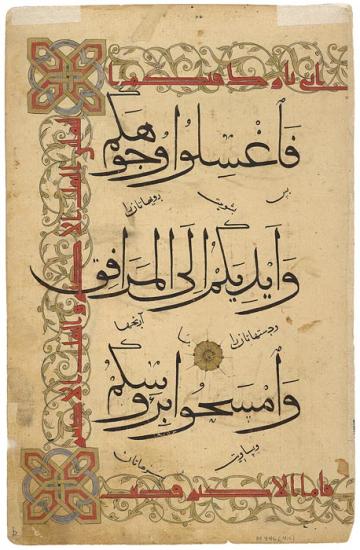
Washing Before Prayer
Qur˒an leaf, in Arabic and Persian
Bequest of Belle da Costa Greene, 1950
Although the Morgan has two leaves from this Qur˒an (see also MS M.846.4a), they are not consecutive, and thus their borders do not match. This page includes verse 6 of sura 5 (al-Mā˒ida, or "The Table"), urging the washing of faces, hands, and arms up to the elbow before praying. The silver Kufic inscription, a Shi˓ite hadith (a saying of Muḥammad), says that the words of ˓Alī and the succeeding imams have the same authority for Shi˓ites as those of the Prophet for Sunni Musliims: "I am going to leave you two valuables, the greater valuable and the lesser valuable. The greater is the book of my god, and the minor is my family and the people of my house [i.e., the twelve Shi˓ite imams]. If you preserve me through them you will never go astray so long as..."
(the text on this page breaks off here).
The Qur˒an, the Holy Book of Islam
From a monumental volume used in an Istanbul mosque to a miniature Persian version that served as a talisman, this section features examples of illuminated pages from the holy book of Islam. The Qur˒an (to recite) represents the codification of the words of God that were revealed and transmitted through the angel Gabriel to the prophet Muḥammad (ca. 570–632) over a period of twenty-three years. The visions began in 610 in a cave on Mount Hira near Mecca, his birthplace, and continued after his 622 flight to Medina, until his death. His flight—the Hijra—marks the beginning of the Islamic calendar.
The revelations were arranged into 114 suras (chapters), each named after its theme. The first and shortest ones, at the end of the book, from the Meccan period, establish Muḥammad as the final prophet in a line of monotheists, including Abraham and Jesus. The longest suras, placed at the beginning, are Medinan and deal more with social and political issues.
For centuries, Qur˒ans were written in Arabic, the language of transmission. After Muḥammad's death, his cousin ˓Alī and others compiled the revelations into a text. About twenty years later, under Uthman, the third caliph (644–656) succeeding Muḥammad, a standard version of the Qur˒an —essentially the one used today—was produced. Thereafter Islam (which means "surrender to God") spread from the Arabian Peninsula throughout the Middle East, to northern Africa and southern Spain, and eventually the world.
Qur˒an from Kashmir
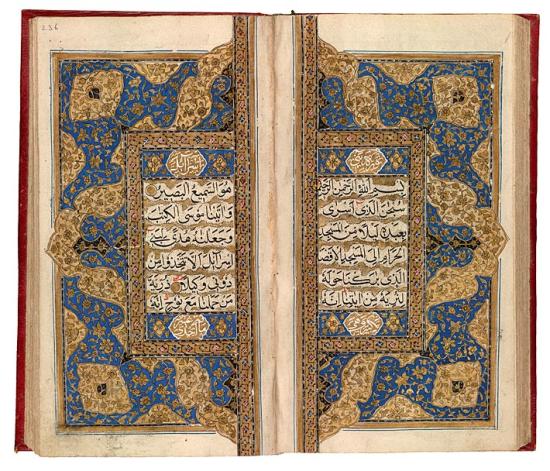
Qur˒an from Kashmir
Qur˒an, in Arabic
Gift of the Trustees of the William S. Glazier Collection, 1984
Qur˒ans were written by hand well into the nineteenth century, and many copies were produced about 1800, when Kashmir was still under Muslim rule. They differ from contemporary Turkish Qur˒ans, which usually provide a date and name of the scribe. The type of decoration found on this double-page sarlauḥ represents typical Kashmiri work of about 1800. This Qur˒an has been divided into sevenths (manzil), one to be read each day of the week, much like the Psalter. Here the double-page sarlauḥ marks the beginning of the fourth division, suras 17 (Bani Isrā-il or "The Israelites") to 25 (al-Furqān or "The Criterion"). The script is naskh, the sura headings are in white, and gold dots follow verses.
The Qur˒an, the Holy Book of Islam
From a monumental volume used in an Istanbul mosque to a miniature Persian version that served as a talisman, this section features examples of illuminated pages from the holy book of Islam. The Qur˒an (to recite) represents the codification of the words of God that were revealed and transmitted through the angel Gabriel to the prophet Muḥammad (ca. 570–632) over a period of twenty-three years. The visions began in 610 in a cave on Mount Hira near Mecca, his birthplace, and continued after his 622 flight to Medina, until his death. His flight—the Hijra—marks the beginning of the Islamic calendar.
The revelations were arranged into 114 suras (chapters), each named after its theme. The first and shortest ones, at the end of the book, from the Meccan period, establish Muḥammad as the final prophet in a line of monotheists, including Abraham and Jesus. The longest suras, placed at the beginning, are Medinan and deal more with social and political issues.
For centuries, Qur˒ans were written in Arabic, the language of transmission. After Muḥammad's death, his cousin ˓Alī and others compiled the revelations into a text. About twenty years later, under Uthman, the third caliph (644–656) succeeding Muḥammad, a standard version of the Qur˒an —essentially the one used today—was produced. Thereafter Islam (which means "surrender to God") spread from the Arabian Peninsula throughout the Middle East, to northern Africa and southern Spain, and eventually the world.
Turkish Qur˒an

Turkish Qur˒an by Pashāzāde
Qur˒an, in Arabic
Purchased by Morgan before 1913; bequest of Belle da Costa Greene, 1950
Unlike late Kashmiri Qur˒ans, those made in Turkey are often fully documented, providing not only a date but the name of the scribe and often that of his teacher. According to the colophon, the manuscript was written in 1832–33 by ˓Alī al-Rusdī al-Asbārtavī, known as Pashāzāde, a student of al-Ḥājj Ḥāfīz Mustafa Ḥelvī, known as Helvajizāde. This sarlauḥ marks the opening of the Qur˒an, with sura 1 (al-Fātiḥa, or "The Opening.") on the right, and sura 2 (al-Baqarah, or "The Heifer") on the left. The text is written in naskh script, and the end of each verse is marked by a rosette. Sura headings, in the cartouches, are written in a white, cursive script.
The Qur˒an, the Holy Book of Islam
From a monumental volume used in an Istanbul mosque to a miniature Persian version that served as a talisman, this section features examples of illuminated pages from the holy book of Islam. The Qur˒an (to recite) represents the codification of the words of God that were revealed and transmitted through the angel Gabriel to the prophet Muḥammad (ca. 570–632) over a period of twenty-three years. The visions began in 610 in a cave on Mount Hira near Mecca, his birthplace, and continued after his 622 flight to Medina, until his death. His flight—the Hijra—marks the beginning of the Islamic calendar.
The revelations were arranged into 114 suras (chapters), each named after its theme. The first and shortest ones, at the end of the book, from the Meccan period, establish Muḥammad as the final prophet in a line of monotheists, including Abraham and Jesus. The longest suras, placed at the beginning, are Medinan and deal more with social and political issues.
For centuries, Qur˒ans were written in Arabic, the language of transmission. After Muḥammad's death, his cousin ˓Alī and others compiled the revelations into a text. About twenty years later, under Uthman, the third caliph (644–656) succeeding Muḥammad, a standard version of the Qur˒an —essentially the one used today—was produced. Thereafter Islam (which means "surrender to God") spread from the Arabian Peninsula throughout the Middle East, to northern Africa and southern Spain, and eventually the world.
Persian Qur˒anic Leaf
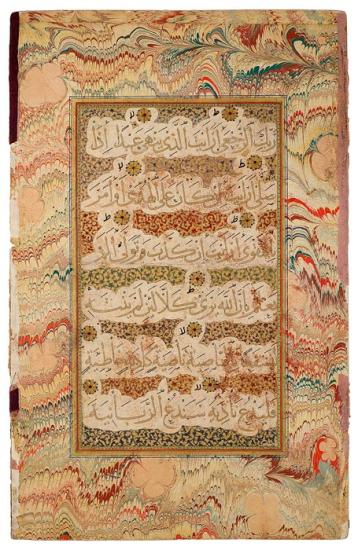
Qur˒anic Leaf from the Read Persian Album
From the Read Persian Album
Purchased by Pierpont Morgan, 1911
Sometimes beautifully written and framed Qur˒anic passages were preserved in albums. This magnificent leaf originally must have faced a page that began with Muḥammad's first revelation (610), sura 96.1—5 (Iqraa, or "Read!" or "Proclaim"), also known as al-˓Alaq ("The Clot of Congealed Blood"), as the present leaf contains verses 8–18. The names come from the verses: Read! (or Proclaim) in the name of your Lord and Cherisher, Who created—created man, out of a [mere] clot of congealed blood. . . .Proclaim . . . He Who taught [the use] of the pen. The six lines of muḥaqqaq script contain ten short ayat (verses), each ending with a gold rosette. Marbling (abri, or "clouds," in Persian) was known in Persia by the sixteenth century, when named abri masters are documented.
The Qur˒an, the Holy Book of Islam
From a monumental volume used in an Istanbul mosque to a miniature Persian version that served as a talisman, this section features examples of illuminated pages from the holy book of Islam. The Qur˒an (to recite) represents the codification of the words of God that were revealed and transmitted through the angel Gabriel to the prophet Muḥammad (ca. 570–632) over a period of twenty-three years. The visions began in 610 in a cave on Mount Hira near Mecca, his birthplace, and continued after his 622 flight to Medina, until his death. His flight—the Hijra—marks the beginning of the Islamic calendar.
The revelations were arranged into 114 suras (chapters), each named after its theme. The first and shortest ones, at the end of the book, from the Meccan period, establish Muḥammad as the final prophet in a line of monotheists, including Abraham and Jesus. The longest suras, placed at the beginning, are Medinan and deal more with social and political issues.
For centuries, Qur˒ans were written in Arabic, the language of transmission. After Muḥammad's death, his cousin ˓Alī and others compiled the revelations into a text. About twenty years later, under Uthman, the third caliph (644–656) succeeding Muḥammad, a standard version of the Qur˒an —essentially the one used today—was produced. Thereafter Islam (which means "surrender to God") spread from the Arabian Peninsula throughout the Middle East, to northern Africa and southern Spain, and eventually the world.
Natural History and Astrology
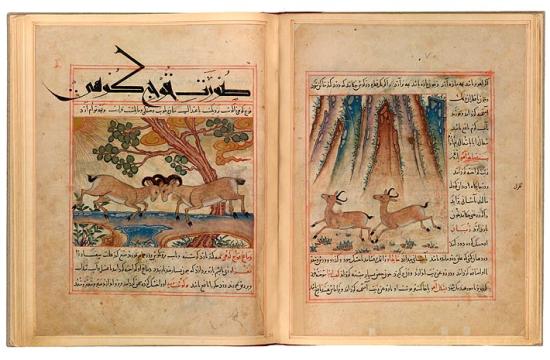
Two Gazelles and Two Mountain Rams
Manāfi˓-i ḥayavān (The Benefits of Animals), in Persian, for Shams al-Dīn Ibn Ẓiyā˒ al-Dīn al-Zūshkī
Purchased by Pierpont Morgan, 1912
Manāfi˓-i ḥayavān (The Benefits of Animals) ranked among the ten greatest Persian manuscripts, dates from the reign of Ghazan Khan (1295–1304), the Mongol ruler who ordered a Persian translation of the book. The Mongol invasion, culminating in the conquest of Baghdad, brought a new, Chinese naturalist style to Persian art. The text discusses the nature and medicinal properties of humans, animals, birds, reptiles, fish, and insects. On the right, two gazelles run in front of a steep, rocky mountainside, kicking up dust (derived from a misunderstood misty landscape model), while on the left two mountain rams fight on a fanciful Chinese-style bridge composed of colored rocks, with gold clouds in the sky.
The manuscript was made at Maragha (south of Tabriz), a center of learning. It was there that Hulagu Khan (r. 1217-1265) built the famous observatory for Nasīr al-Dīn al-Ṭusī, the famous schlar and astronomer.
Natural History and Astrology
The miniatures presented here derive primarily from two extraordinary Islamic manuscripts that depict the natural world and the heavens. The first, Manāfi˓-i hayavān (The Benefits of Animals), is considered one of the ten greatest surviving Persian manuscripts. It dates from the reign of Ghazan Khan (1295–1304), the Mongol ruler who ordered a Persian translation of the book, and concerns the nature and medicinal properties of humans, animals, birds, reptiles, fish, and insects. The other, Matāli˓ al-sa˓āda wa manābi˓ al-siyāda (The Ascension of Propitious Stars and Sources of Sovereign), was commissioned by Sultan Murād III (r. 1574–95), an Ottoman ruler deeply interested in astronomy, cosmology, demonology, poetry, and mysticism.
Two Elephants
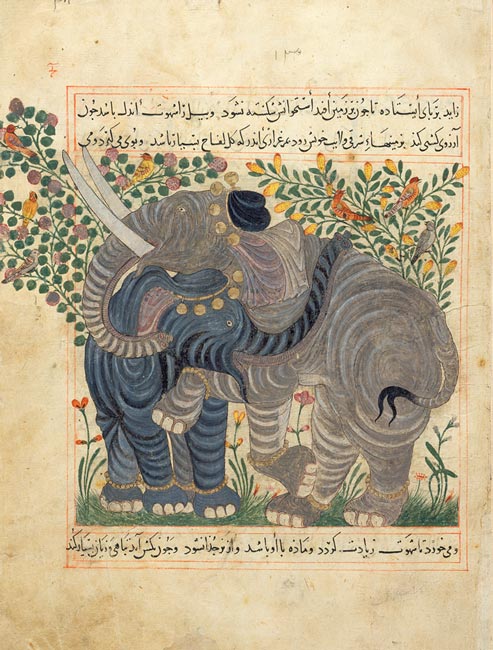
Two Elephants
Manāfi˓-i ḥayavān (The Benefits of Animals), in Persian, for Shams al-Dīn Ibn Ẓiyā˒ al-Dīn al-Zūshkī
Purchased by Pierpont Morgan, 1912
The two interlocking and rather affectionate elephants shown here make up one of the finest of the forty-four large illustrations in the manuscript Manāfi˓-i ḥayavān (The Benefits of Animals). They are royal elephants, as seen from their caps and the bells on their feet. The text describes both the habits and medicinal derivatives of the animal. Among the former, for example, it is stated that the tongue of the elephant is upside down, for if it were not, it could speak, and that the elephant was called "barrus on account of its voice, whence the voice is called baritone." Among the latter—and these have not been tested by the Morgan—are suggestions that elephant broth is good for colds and asthma, that elephant dung (taken with or without honey) prevents conception, and that one dram of ivory filings will bring about conception.
Tiger
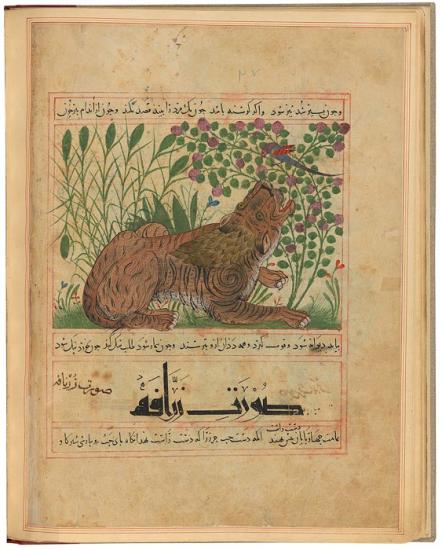
Tiger
Manāfi˓-i ḥayavān (The Benefits of Animals), in Persian, for Shams al-Dīn Ibn Ẓiyā˒ al-Dīn al-Zūshkī
Purchased by Pierpont Morgan, 1912
This illustration appears in the great Persian manuscript Manāfi˓-i ḥayavān (The Benefits of Animals). The recumbent lion raises its head, appearing to converse with the bird in the flowering bush above. The text mentions no medical derivatives of the tiger. Under the reeds are traces of a sketch, in red, of a camel facing left, indicating that the paper was reused.
Natural History and Astrology
The miniatures presented here derive primarily from two extraordinary Islamic manuscripts that depict the natural world and the heavens. The first, Manāfi˓-i hayavān (The Benefits of Animals), is considered one of the ten greatest surviving Persian manuscripts. It dates from the reign of Ghazan Khan (1295–1304), the Mongol ruler who ordered a Persian translation of the book, and concerns the nature and medicinal properties of humans, animals, birds, reptiles, fish, and insects. The other, Matāli˓ al-sa˓āda wa manābi˓ al-siyāda (The Ascension of Propitious Stars and Sources of Sovereign), was commissioned by Sultan Murād III (r. 1574–95), an Ottoman ruler deeply interested in astronomy, cosmology, demonology, poetry, and mysticism.
Camel
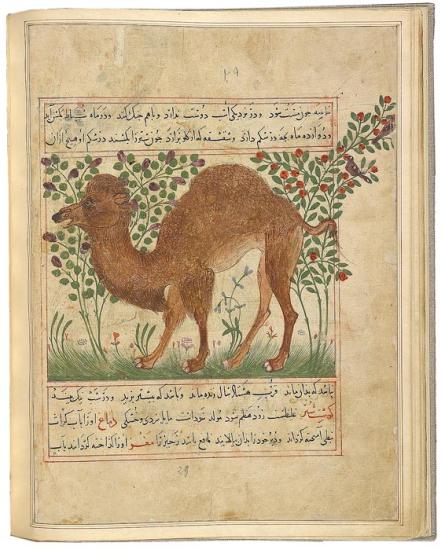
Camel
Manāfi˓-i ḥayavān (The Benefits of Animals), in Persian, for Shams al-Dīn Ibn Ẓiyā˒ al-Dīn al-Zūshkī
Purchased by Pierpont Morgan, 1912
This illustration appears in the great Persian manuscript Manāfi˓-i ḥayavān (The Benefits of Animals). The camel's forelegs are too short, suggesting that the artist's model was too large to fit the available space, and its head has a strange pompadour of hair, perhaps to compensate for the short legs. According to the text the camel is revengeful and thus has a good memory. They conceive in February, have a twelve-month gestation period, and hate the company of horses, as they always fight. Different parts of the camel were used medicinally. Its hump, for example, is good for dysentary; melted and mixed with chive juice it relieves the pain caused by piles.
Natural History and Astrology
The miniatures presented here derive primarily from two extraordinary Islamic manuscripts that depict the natural world and the heavens. The first, Manāfi˓-i hayavān (The Benefits of Animals), is considered one of the ten greatest surviving Persian manuscripts. It dates from the reign of Ghazan Khan (1295–1304), the Mongol ruler who ordered a Persian translation of the book, and concerns the nature and medicinal properties of humans, animals, birds, reptiles, fish, and insects. The other, Matāli˓ al-sa˓āda wa manābi˓ al-siyāda (The Ascension of Propitious Stars and Sources of Sovereign), was commissioned by Sultan Murād III (r. 1574–95), an Ottoman ruler deeply interested in astronomy, cosmology, demonology, poetry, and mysticism.
Iskandar and Khiżr
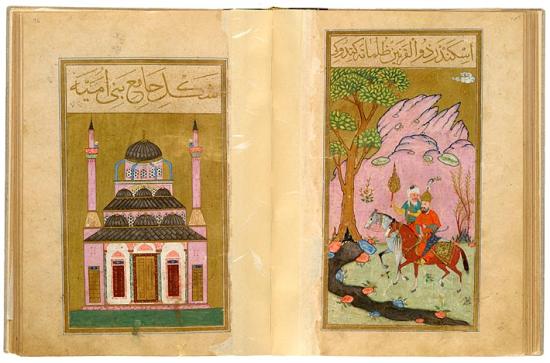
Iskandar and Khiżr Seek the Water of Eternal Life and the Mosque of the Bani Umayya
Maṭāli˓ al-sa˓āda wa manābi˓ al-siyāda (The Ascension of Propitious Stars and Sources of Sovereign), in Turkish
Illuminated by Vali Jan for ˓Āyisha Sulṭān (d.1604), the daughter of Sultan Murād III
Purchased in 1935
This book, made for ˓Āyisha Sulṭān (the daughter of Sultān Murad III), , contains texts relating to astrology, wonders of the world, talismans, and divination. These two miniatures illustrate the second section. Here Iskandar (Alexander the Great) and Khiżr (the green one) enter the Land of Darkness in search of the Fountain of Life. Khiżr, holding a torch, glances at Iskandar. Although the mosque on the left is identified as the ancient mosque of the Umayyads (ca. 650–751) in Damascus, the artist depicted a typical sixteenth-century Ottoman mosque. A twin manuscript painted by ˓Osmān in Paris (BnF, Suppl. turc 242) was made for Fāṭima Sulṭān, another daughter of the Ottoman ruler/bibliophile Murād III (r. 1574–1595) who commissioned the translation.
Natural History and Astrology
The miniatures presented here derive primarily from two extraordinary Islamic manuscripts that depict the natural world and the heavens. The first, Manāfi˓-i hayavān (The Benefits of Animals), is considered one of the ten greatest surviving Persian manuscripts. It dates from the reign of Ghazan Khan (1295–1304), the Mongol ruler who ordered a Persian translation of the book, and concerns the nature and medicinal properties of humans, animals, birds, reptiles, fish, and insects. The other, Matāli˓ al-sa˓āda wa manābi˓ al-siyāda (The Ascension of Propitious Stars and Sources of Sovereign), was commissioned by Sultan Murād III (r. 1574–95), an Ottoman ruler deeply interested in astronomy, cosmology, demonology, poetry, and mysticism.
Sultan MurĀd III
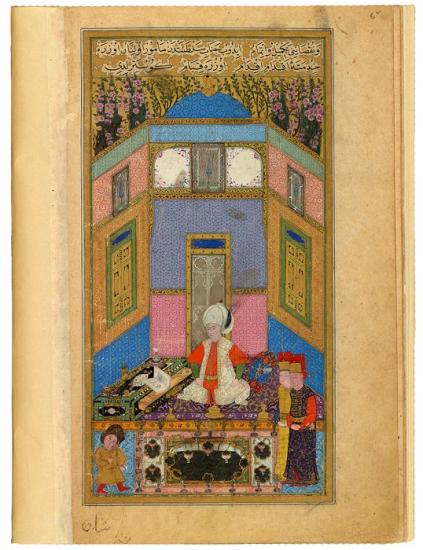
Sultan MurĀd III in his Library
Maṭāli˓ al-sa˓āda wa manābi˓ al-siyāda (The Ascension of Propitious Stars and Sources of Sovereign), in Turkish
Illuminated by Vali Jan for ˓Āyisha Sulṭān (d.1604), the daughter of Sultan Murād III
Purchased in 1935
Murād III (r. 1574–95), the son of Selim II (r, 1566–74) and grandson of Süleyman the Magnificent (r. 1520–66), ushered in a golden age of Ottoman painting, commissioning illustrated manuscripts of historical, literary, and scientific texts, many made in Istanbul's imperial scriptorium. He also ordered that texts be translated into Turkish.
Here Murād III actually admires the very manuscript for which this is the opening miniature—-the Maṭāli˓ al-sa˓āda, made for his daughter ˓Āyisha Sulṭān.; He is examining the section of the manuscript depicting zodiacal signs and the three planets associated with their decades. The face of the sultan, alas, has been altered, perhaps by a later owner, as he should have been depicted with a beard, as he is in the closely related miniature in Paris. The book is supported by the open drawer of a luxurious portable desk of ebony and ivory, on top of which are various implements, including an hourglass and a western clock. Murād is attended by two janisarries wearing their elite and distinctive headgear, and a dwarf.
Murād was interested in astronomy, cosmology, demonology, poetry, and mysticism and ordered a Turkish translation (1590) of Aflākī's life of Rūmī, Persia's greatest poet and mystic. Murād wrote poetry, and in 1584 built the kitchen and dervish cells of the Mevlevī convent in Konya, where he had gone with Selim during the siege of 1559 (see MS M.466, fol. 131r). As sultan, Murād never left Istanbul but took full advantage of the imperial harem. By the time of his death at age forty-nine he had fathered one hundred and two children and left seven pregnant concubines; sixty-two died during his lifetime, and nineteen sons were murdered by Mehmed III when he ascended the throne.
Natural History and Astrology
The miniatures presented here derive primarily from two extraordinary Islamic manuscripts that depict the natural world and the heavens. The first, Manāfi˓-i hayavān (The Benefits of Animals), is considered one of the ten greatest surviving Persian manuscripts. It dates from the reign of Ghazan Khan (1295–1304), the Mongol ruler who ordered a Persian translation of the book, and concerns the nature and medicinal properties of humans, animals, birds, reptiles, fish, and insects. The other, Matāli˓ al-sa˓āda wa manābi˓ al-siyāda (The Ascension of Propitious Stars and Sources of Sovereign), was commissioned by Sultan Murād III (r. 1574–95), an Ottoman ruler deeply interested in astronomy, cosmology, demonology, poetry, and mysticism.
Leo Ridden by a Personification of the Sun
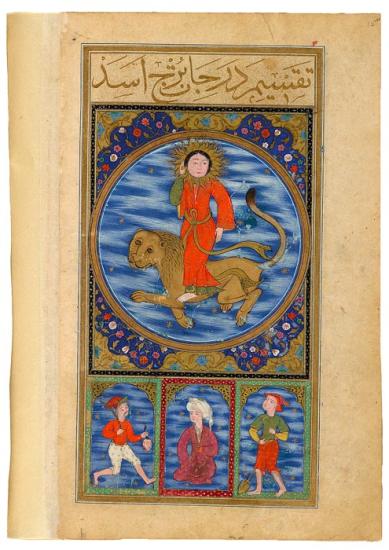
Leo Ridden by a Personification of the Sun
Maṭāli˓ al-sa˓āda wa manābi˓ al-siyāda (The Ascension of Propitious Stars and Sources of Sovereign), in Turkish
Illuminated by Vali Jan for ˓Āyisha Sulṭān (d.1604), the daughter of Sultan Murād III
Purchased in 1935
This astrological illustration is one of twelve in the manuscript that depict the zodiacal signs and the three planets associated with their decades. Leo, the lion, ridden by a personification of the sun, is depicted within the roundel. The lords of the decades are shown in the arcades below: Saturn using a spade, Jupiter holding a book, and Mars holding a mace and severed head.
Natural History and Astrology
The miniatures presented here derive primarily from two extraordinary Islamic manuscripts that depict the natural world and the heavens. The first, Manāfi˓-i hayavān (The Benefits of Animals), is considered one of the ten greatest surviving Persian manuscripts. It dates from the reign of Ghazan Khan (1295–1304), the Mongol ruler who ordered a Persian translation of the book, and concerns the nature and medicinal properties of humans, animals, birds, reptiles, fish, and insects. The other, Matāli˓ al-sa˓āda wa manābi˓ al-siyāda (The Ascension of Propitious Stars and Sources of Sovereign), was commissioned by Sultan Murād III (r. 1574–95), an Ottoman ruler deeply interested in astronomy, cosmology, demonology, poetry, and mysticism.
The Valley of Diamonds and Jewels
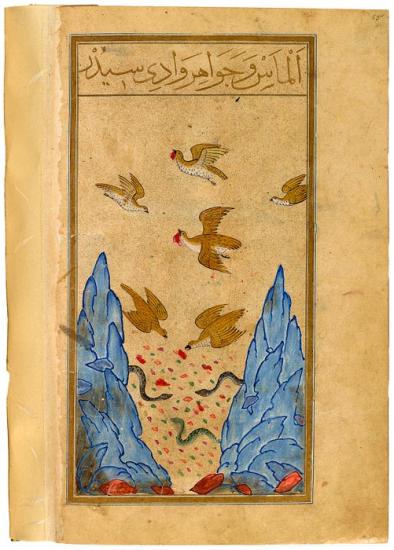
The Valley of Diamonds and Jewels
Maṭāli˓ al-sa˓āda wa manābi˓ al-siyāda (The Ascension of Propitious Stars and Sources of Sovereign), in Turkish
Illuminated by Vali Jan for ˓Āyisha Sulṭān (d.1604), the daughter of Sultan Murād III
Purchased in 1935
In this illustration from a sixteenth-century Turkish manuscript commissioned by Sultan Murād III, the deep rocky valley was filled with diamonds and jewels, and Iskandar (Alexander the Great) was asked how they could be safely obtained, as they were protected by terrible creatures, here represented as poisonous snakes. His solution was to throw raw meat into the valley, to which the gems would stick. The birds would then swoop down into the valley, carry off the gem-laden meat in their talons, and take it to the top, planning to eat the meat there. The birds would then be scared away, and the gems separated from the meat.
Natural History and Astrology
The miniatures presented here derive primarily from two extraordinary Islamic manuscripts that depict the natural world and the heavens. The first, Manāfi˓-i hayavān (The Benefits of Animals), is considered one of the ten greatest surviving Persian manuscripts. It dates from the reign of Ghazan Khan (1295–1304), the Mongol ruler who ordered a Persian translation of the book, and concerns the nature and medicinal properties of humans, animals, birds, reptiles, fish, and insects. The other, Matāli˓ al-sa˓āda wa manābi˓ al-siyāda (The Ascension of Propitious Stars and Sources of Sovereign), was commissioned by Sultan Murād III (r. 1574–95), an Ottoman ruler deeply interested in astronomy, cosmology, demonology, poetry, and mysticism.
Sleeping Man

A Sleeping Man is Oppressed by a Nightmare
Maṭāli˓ al-sa˓āda wa manābi˓ al-siyāda (The Ascension of Propitious Stars and Sources of Sovereign), in Turkish
Illuminated by Vali Jan for ˓Āyisha Sulṭān (d.1604), the daughter of Sultan Murād III
Purchased in 1935
According to the title above the painting, this jinn (a pre-Adam angel cast down with Iblīs, or Satan) is called Kabus, which can literally be translated as Nightmare. Jinns are invisible and were created by God, but are half-men and half-animals, and can behave well or badly. They can inflict illness and other ailments, so deserve protective talismans (the gold emblems). Here Kabus, wearing trousers and gold anklets, and accompanied by two horned attendants, swoops down on the man, hoping to ruin his sleep. This illustration appears in a sixteenth-century Turkish manuscript commissioned by Sultan Murād III.
Natural History and Astrology
The miniatures presented here derive primarily from two extraordinary Islamic manuscripts that depict the natural world and the heavens. The first, Manāfi˓-i hayavān (The Benefits of Animals), is considered one of the ten greatest surviving Persian manuscripts. It dates from the reign of Ghazan Khan (1295–1304), the Mongol ruler who ordered a Persian translation of the book, and concerns the nature and medicinal properties of humans, animals, birds, reptiles, fish, and insects. The other, Matāli˓ al-sa˓āda wa manābi˓ al-siyāda (The Ascension of Propitious Stars and Sources of Sovereign), was commissioned by Sultan Murād III (r. 1574–95), an Ottoman ruler deeply interested in astronomy, cosmology, demonology, poetry, and mysticism.
ʻAbd al-Muṭṭalib
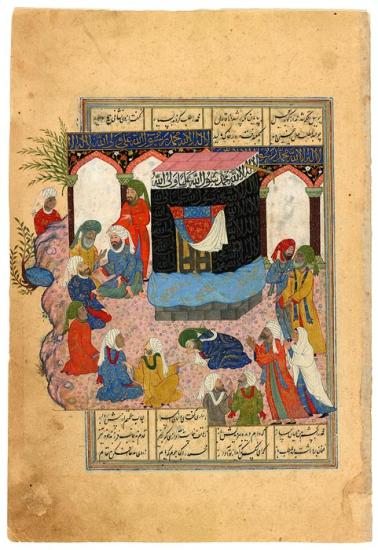
ʻAbd al-Muṭṭalib, Grandfather of the Prophet Muḥammad, Kneels Before the Kabba in Mecca
Leaf from the Chester Beatty Āsār al-muẓaffar (A Life of Muḥammad)
Gift of the Trustees of the William S. Glazier Collection, 1984
The Kaaba (The Cube), the most sacred site in Islam, was, according to the Qur˒an, built by the prophet Abraham and Ismael, his son. Regardless of their location, Muslims always face the Kaaba during prayer. Since Muḥammad's father died nearly six months before his birth, he was brought up for two years with his paternal grandfather, ˓Abd al-Muṭṭalib, who died when Muḥammad was eight. His uncle, Abū ṭālib, custodian of the Kaaba, then looked after him. Here the Kaaba is covered with a black cloth (kiswa) decorated with the shahada (declaration of faith: There is no god but Allah, Muḥammad is the messenger of Allah) and ˓Alī is the friend of God. Before Muḥammad, there were 360 idols in the Kaaba. In another miniature in the Chester Beatty manuscript, he orders their destruction. The style of miniature, the circular composition, and the subject matter anticipate the Baghdad school of painting that flourished from about 1585 to 1605, and of which the Morgan life of Rūmī (MS M. 466) is a masterpiece.
Natural History and Astrology
The miniatures presented here derive primarily from two extraordinary Islamic manuscripts that depict the natural world and the heavens. The first, Manāfi˓-i hayavān (The Benefits of Animals), is considered one of the ten greatest surviving Persian manuscripts. It dates from the reign of Ghazan Khan (1295–1304), the Mongol ruler who ordered a Persian translation of the book, and concerns the nature and medicinal properties of humans, animals, birds, reptiles, fish, and insects. The other, Matāli˓ al-sa˓āda wa manābi˓ al-siyāda (The Ascension of Propitious Stars and Sources of Sovereign), was commissioned by Sultan Murād III (r. 1574–95), an Ottoman ruler deeply interested in astronomy, cosmology, demonology, poetry, and mysticism.
Rūmī, Persian Mystic And Poet
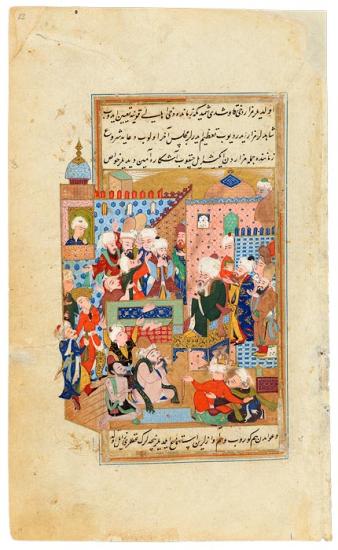
Rūmī's Father Gives a Sermon in the Qāni˓ī Cemetery of Konya
Tarjuma-i Thawāqib-i manāqib (A Translation of Stars of the Legend), in Turkish
The translation was ordered in 1590 by Sultan Murād III (r. 1574–95) from the Persian abridgement of Aflākī.
Purchased by Pierpont Morgan, 1911
Rūmī's father, Bahā˒ al-Dīn (d. 1231), a revered scholar and a man of great sanctity, reportedly worked many miracles in Konya. Seljuk Sultan ˓Āla˒ al-Dīn Kaiqubād I (r. 1219–1237) once ordered him to give a sermon in Konya's cemetery that proved to be so moving that the dead came out of their graves. At another point, shown here, pairs of hands emerge from the graves, their owners proclaiming, "Amen." The incident is not included in the original Persian text; it was added by the Turkish translator. Bahā˒ al-Dīn, dressed in green, sits on a tall gold chair; in the front is a dark-skinned dervish with burn marks (showing ardor for the beloved) and two men, seen from the back, embracing. Some figures wear the distinctive tall, honey-colored, felt hats of the Mevlevī order.
This miniature is part of a sixteenth-century manuscript account of the life and miracles of the Persian poet and mystic known as Rūmī. It is a Turkish translation of an abridged version of the original fourteenth-century Persian account by the dervish known as Aflākī.
Rūmī, Persian Mystic And Poet
The sixteenth-century miniatures presented here concern the life and miracles of Jalāl al-Dīn Rūmī, called Mē vlāna (Our Master), the most famous member of the Mevlevī order and Persia's greatest Sufi mystic and poet. He was born in Balkh in 1207, but his family emigrated after his father foresaw the Mongol conquest. They eventually resettled in Konya, Turkey, then the capital of Anatolian Rūm (thus Rūmī), where the poet died on 17 December 1273.
Several Persian accounts of Rūmī's life have been written, the first by his son, Sultan Walad. The third, laden with moralizing miracle stories, was ordered by Rūmī's grandson Ulu ˓Ārif Chelebi. It was written by the dervish Shams al-Dīn Aḥmad, called Aflākī (d. 1360). Aflākī also incorporated verses from Rūmī's works, notably his six-volume Masnavī (a poetical form of rhyming couplets) and the Dīvān-i-Shams al-Dīn Tabrīzī, named after Shams of Tabriz, the mystic who changed Rūmī's life and transformed him into a poet when they met in 1244.
In 1590—three and a half centuries after Aflākī wrote his life of Rūmī—the Ottoman sultan Mūrad III ordered a Turkish translation of a 1540 abridged version of Aflākī's text entitled Tarjuma-i Thawāqib-i manāqib (Stars of the Legend). The translator was Darvīsh Mahmud Mesnevī Khān of Konya. Two illustrated copies of the Murād translation, both made in Baghdad, survive. One, dated 1599, is held by Topkapi Palace, Istanbul, and has twenty-two miniatures. The other, richer manuscript is held by the Morgan. It dates to the 1590s and includes twenty-nine miniatures. They are all featured here, along with two folios from other collections that are believed to have once been part of the Morgan manuscript.
Seljuk Sultan's Courtier
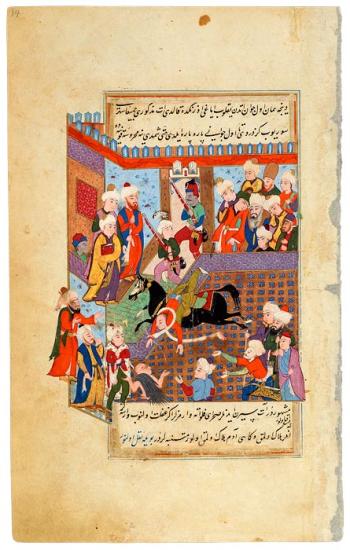
The Seljuk Sultan's Courtier Disturbs Rūmī's Visit to his Father's Grave
Tarjuma-i Thawāqib-i manāqib (A Translation of Stars of the Legend), in Turkish
The translation was ordered in 1590 by Sultan Murād III (r. 1574–95) from the Persian abridgement of Aflākī.
Purchased by Pierpont Morgan, 1911
While meditating near his father's tomb, Rūmī is disturbed when the sultan's courtier, Valad-i Fakhr al-Dīn Shādid, in princely attire, rides his black horse through the cemetery. Rūmī strongly reproves the rider, who then loses control of his horse, falls to the ground, and is injured. Rūmī, with a gray beard, is at the upper right, surrounded by students. Two men with guns guard the entrance to the walled city in the background. The cemetery itself is located outside the city walls, as was the custom.
This miniature is part of a sixteenth-century manuscript account of the life and miracles of the Persian poet and mystic known as Rūmī. It is a Turkish translation of an abridged version of the original fourteenth-century Persian account by the dervish known as Aflākī.
Rūmī, Persian Mystic And Poet
The sixteenth-century miniatures presented here concern the life and miracles of Jalāl al-Dīn Rūmī, called Mē vlāna (Our Master), the most famous member of the Mevlevī order and Persia's greatest Sufi mystic and poet. He was born in Balkh in 1207, but his family emigrated after his father foresaw the Mongol conquest. They eventually resettled in Konya, Turkey, then the capital of Anatolian Rūm (thus Rūmī), where the poet died on 17 December 1273.
Several Persian accounts of Rūmī's life have been written, the first by his son, Sultan Walad. The third, laden with moralizing miracle stories, was ordered by Rūmī's grandson Ulu ˓Ārif Chelebi. It was written by the dervish Shams al-Dīn Aḥmad, called Aflākī (d. 1360). Aflākī also incorporated verses from Rūmī's works, notably his six-volume Masnavī (a poetical form of rhyming couplets) and the Dīvān-i-Shams al-Dīn Tabrīzī, named after Shams of Tabriz, the mystic who changed Rūmī's life and transformed him into a poet when they met in 1244.
In 1590—three and a half centuries after Aflākī wrote his life of Rūmī—the Ottoman sultan Mūrad III ordered a Turkish translation of a 1540 abridged version of Aflākī's text entitled Tarjuma-i Thawāqib-i manāqib (Stars of the Legend). The translator was Darvīsh Mahmud Mesnevī Khān of Konya. Two illustrated copies of the Murād translation, both made in Baghdad, survive. One, dated 1599, is held by Topkapi Palace, Istanbul, and has twenty-two miniatures. The other, richer manuscript is held by the Morgan. It dates to the 1590s and includes twenty-nine miniatures. They are all featured here, along with two folios from other collections that are believed to have once been part of the Morgan manuscript.
Sermon by Rūmī
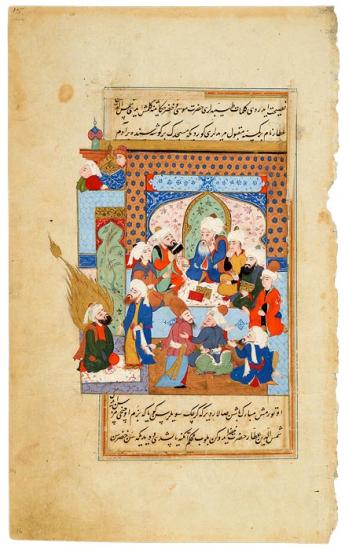
Khiżr Attends a Sermon by Rūmī
Tarjuma-i Thawāqib-i manāqib (A Translation of Stars of the Legend), in Turkish
The translation was ordered in 1590 by Sultan Murād III (r. 1574–95) from the Persian abridgement of Aflākī.
Purchased by Pierpont Morgan, 1911
According to the accompanying text, Rūmī, seated in the center, is explaining the stories of the prophets Khiżr and Mūsā (Moses) to his followers. Shams al-Din, a druggist, notices that Khiżr, dressed in his traditional green and adorned with the flaming halo designating a prophet, is sitting near a door of the mosque. When the druggist grabs Khiżr's robe in order to make a request, Khiżr tells him that he, like the other prophets, should seek guidance from Rūmī. Thought to be a contemporary of Moses, Khiżr is especially dear to the Sufis, who regard him as the initiator of those who walk the mystical path.
This miniature is part of a sixteenth-century manuscript account of the life and miracles of the Persian poet and mystic known as Rūmī. It is a Turkish translation of an abridged version of the original fourteenth-century Persian account by the dervish known as Aflākī.
Rūmī, Persian Mystic And Poet
The sixteenth-century miniatures presented here concern the life and miracles of Jalāl al-Dīn Rūmī, called Mē vlāna (Our Master), the most famous member of the Mevlevī order and Persia's greatest Sufi mystic and poet. He was born in Balkh in 1207, but his family emigrated after his father foresaw the Mongol conquest. They eventually resettled in Konya, Turkey, then the capital of Anatolian Rūm (thus Rūmī), where the poet died on 17 December 1273.
Several Persian accounts of Rūmī's life have been written, the first by his son, Sultan Walad. The third, laden with moralizing miracle stories, was ordered by Rūmī's grandson Ulu ˓Ārif Chelebi. It was written by the dervish Shams al-Dīn Aḥmad, called Aflākī (d. 1360). Aflākī also incorporated verses from Rūmī's works, notably his six-volume Masnavī (a poetical form of rhyming couplets) and the Dīvān-i-Shams al-Dīn Tabrīzī, named after Shams of Tabriz, the mystic who changed Rūmī's life and transformed him into a poet when they met in 1244.
In 1590—three and a half centuries after Aflākī wrote his life of Rūmī—the Ottoman sultan Mūrad III ordered a Turkish translation of a 1540 abridged version of Aflākī's text entitled Tarjuma-i Thawāqib-i manāqib (Stars of the Legend). The translator was Darvīsh Mahmud Mesnevī Khān of Konya. Two illustrated copies of the Murād translation, both made in Baghdad, survive. One, dated 1599, is held by Topkapi Palace, Istanbul, and has twenty-two miniatures. The other, richer manuscript is held by the Morgan. It dates to the 1590s and includes twenty-nine miniatures. They are all featured here, along with two folios from other collections that are believed to have once been part of the Morgan manuscript.
Three Saints
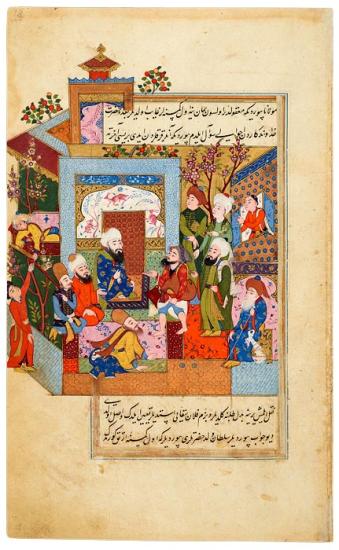
Three Saints Ask Rūmī for Permission to Take the Water Carrier of the Mevlevī Order with Them
Tarjuma-i Thawāqib-i manāqib (A Translation of Stars of the Legend), in Turkish
The translation was ordered in 1590 by Sultan Murād III (r. 1574–95) from the Persian abridgement of Aflākī.
Purchased by Pierpont Morgan, 1911
According to the story, not found in Aflākī's original Persian text but added by the Turkish translator, a delegation of three saints, all dressed in green, have come to visit Rūmī. They represent the forty saints that live in every generation, who, when one dies, choose a substitute. Here they ask Rūmī if they can take the water carrier of the Mevlevī order with them. The three saints stand behind the water carrier, who holds the large bag made of animal skin. Some genre scenes, as the doorkeeper at the right, and a youth offering an apple to a second youth on a balcony are not called for by the accompanying text, but are the kind of pictorial enrichments typical of the Baghdad school.
This miniature is part of a sixteenth-century manuscript account of the life and miracles of the Persian poet and mystic known as Rūmī. It is a Turkish translation of an abridged version of the original fourteenth-century Persian account by the dervish known as Aflākī.
Rūmī, Persian Mystic And Poet
The sixteenth-century miniatures presented here concern the life and miracles of Jalāl al-Dīn Rūmī, called Mē vlāna (Our Master), the most famous member of the Mevlevī order and Persia's greatest Sufi mystic and poet. He was born in Balkh in 1207, but his family emigrated after his father foresaw the Mongol conquest. They eventually resettled in Konya, Turkey, then the capital of Anatolian Rūm (thus Rūmī), where the poet died on 17 December 1273.
Several Persian accounts of Rūmī's life have been written, the first by his son, Sultan Walad. The third, laden with moralizing miracle stories, was ordered by Rūmī's grandson Ulu ˓Ārif Chelebi. It was written by the dervish Shams al-Dīn Aḥmad, called Aflākī (d. 1360). Aflākī also incorporated verses from Rūmī's works, notably his six-volume Masnavī (a poetical form of rhyming couplets) and the Dīvān-i-Shams al-Dīn Tabrīzī, named after Shams of Tabriz, the mystic who changed Rūmī's life and transformed him into a poet when they met in 1244.
In 1590—three and a half centuries after Aflākī wrote his life of Rūmī—the Ottoman sultan Mūrad III ordered a Turkish translation of a 1540 abridged version of Aflākī's text entitled Tarjuma-i Thawāqib-i manāqib (Stars of the Legend). The translator was Darvīsh Mahmud Mesnevī Khān of Konya. Two illustrated copies of the Murād translation, both made in Baghdad, survive. One, dated 1599, is held by Topkapi Palace, Istanbul, and has twenty-two miniatures. The other, richer manuscript is held by the Morgan. It dates to the 1590s and includes twenty-nine miniatures. They are all featured here, along with two folios from other collections that are believed to have once been part of the Morgan manuscript.
RūMī Stops His Ears
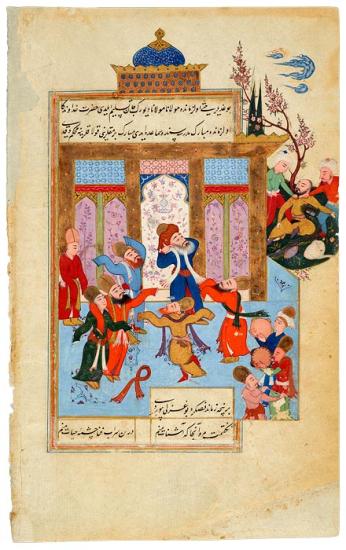
Participating in Samā˓, RūMī Stops His Ears Against the Cries of the Seljuq Sultan Rukn Al-Dīn Qlich
Tarjuma-i Thawāqib-i manāqib (A Translation of Stars of the Legend), in Turkish
The translation was ordered in 1590 by Sultan Murād III (r. 1574–95) from the Persian abridgement of Aflākī.
Purchased by Pierpont Morgan, 1911
According to the accompanying text, the Seljuq sultan Rukn al-Dīn Qilich Arslan IV (r. 1248–65) chose a questionable spiritual guide over Rūmī. Some days later he is strangled by some of his emirs. At the moment of the murder, Rūmī, participating in a mystical dance ceremony (samā˓), places his forefingers in his ears, leading a prayer for the dead. Rūmī later explained that the sultan had pleaded for his help, but he did not want to hear him, saying that a man's fate could not be changed. While the dervishes dance to the music of the flute and the tambourines, the noose is tightened around the sultan's neck.
This miniature is part of a sixteenth-century manuscript account of the life and miracles of the Persian poet and mystic known as Rūmī. It is a Turkish translation of an abridged version of the original fourteenth-century Persian account by the dervish known as Aflākī.
Rūmī, Persian Mystic And Poet
The sixteenth-century miniatures presented here concern the life and miracles of Jalāl al-Dīn Rūmī, called Mē vlāna (Our Master), the most famous member of the Mevlevī order and Persia's greatest Sufi mystic and poet. He was born in Balkh in 1207, but his family emigrated after his father foresaw the Mongol conquest. They eventually resettled in Konya, Turkey, then the capital of Anatolian Rūm (thus Rūmī), where the poet died on 17 December 1273.
Several Persian accounts of Rūmī's life have been written, the first by his son, Sultan Walad. The third, laden with moralizing miracle stories, was ordered by Rūmī's grandson Ulu ˓Ārif Chelebi. It was written by the dervish Shams al-Dīn Aḥmad, called Aflākī (d. 1360). Aflākī also incorporated verses from Rūmī's works, notably his six-volume Masnavī (a poetical form of rhyming couplets) and the Dīvān-i-Shams al-Dīn Tabrīzī, named after Shams of Tabriz, the mystic who changed Rūmī's life and transformed him into a poet when they met in 1244.
In 1590—three and a half centuries after Aflākī wrote his life of Rūmī—the Ottoman sultan Mūrad III ordered a Turkish translation of a 1540 abridged version of Aflākī's text entitled Tarjuma-i Thawāqib-i manāqib (Stars of the Legend). The translator was Darvīsh Mahmud Mesnevī Khān of Konya. Two illustrated copies of the Murād translation, both made in Baghdad, survive. One, dated 1599, is held by Topkapi Palace, Istanbul, and has twenty-two miniatures. The other, richer manuscript is held by the Morgan. It dates to the 1590s and includes twenty-nine miniatures. They are all featured here, along with two folios from other collections that are believed to have once been part of the Morgan manuscript.
Rūmī Summons Ḥamza
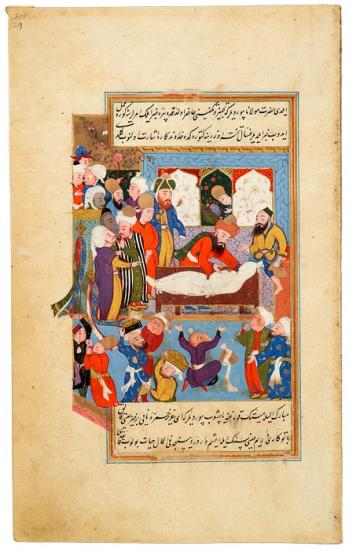
Rūmī Summons Ḥamza, the Famous Flute Player, Back to Life
Tarjuma-i Thawāqib-i manāqib (A Translation of Stars of the Legend), in Turkish
The translation was ordered in 1590 by Sultan Murād III (r. 1574–95) from the Persian abridgement of Aflākī.
Purchased by Pierpont Morgan, 1911
Ḥamza, the best flutist of the order, has just died. Rūmī raises the head of his corpse and miraculously restores him to life, saying, "My dear friend Ḥamza, arise!" Ḥamza then replies, "Lo, here I am!" takes up his flute, and sustains a religious festival for three days and nights. About one hundred Greeks witness the event and are converted to Islam. When Rūmī leaves, life departs from Ḥamza as well. In the left foreground, two youths hold religious standards, two men carry Qur˒an chests on their heads, and a dervish's felt hat and scarf have toppled to the ground.
This miniature is part of a sixteenth-century manuscript account of the life and miracles of the Persian poet and mystic known as Rūmī. It is a Turkish translation of an abridged version of the original fourteenth-century Persian account by the dervish known as Aflākī.
Rūmī, Persian Mystic And Poet
The sixteenth-century miniatures presented here concern the life and miracles of Jalāl al-Dīn Rūmī, called Mē vlāna (Our Master), the most famous member of the Mevlevī order and Persia's greatest Sufi mystic and poet. He was born in Balkh in 1207, but his family emigrated after his father foresaw the Mongol conquest. They eventually resettled in Konya, Turkey, then the capital of Anatolian Rūm (thus Rūmī), where the poet died on 17 December 1273.
Several Persian accounts of Rūmī's life have been written, the first by his son, Sultan Walad. The third, laden with moralizing miracle stories, was ordered by Rūmī's grandson Ulu ˓Ārif Chelebi. It was written by the dervish Shams al-Dīn Aḥmad, called Aflākī (d. 1360). Aflākī also incorporated verses from Rūmī's works, notably his six-volume Masnavī (a poetical form of rhyming couplets) and the Dīvān-i-Shams al-Dīn Tabrīzī, named after Shams of Tabriz, the mystic who changed Rūmī's life and transformed him into a poet when they met in 1244.
In 1590—three and a half centuries after Aflākī wrote his life of Rūmī—the Ottoman sultan Mūrad III ordered a Turkish translation of a 1540 abridged version of Aflākī's text entitled Tarjuma-i Thawāqib-i manāqib (Stars of the Legend). The translator was Darvīsh Mahmud Mesnevī Khān of Konya. Two illustrated copies of the Murād translation, both made in Baghdad, survive. One, dated 1599, is held by Topkapi Palace, Istanbul, and has twenty-two miniatures. The other, richer manuscript is held by the Morgan. It dates to the 1590s and includes twenty-nine miniatures. They are all featured here, along with two folios from other collections that are believed to have once been part of the Morgan manuscript.
ḤalĀwiyya Madrasa
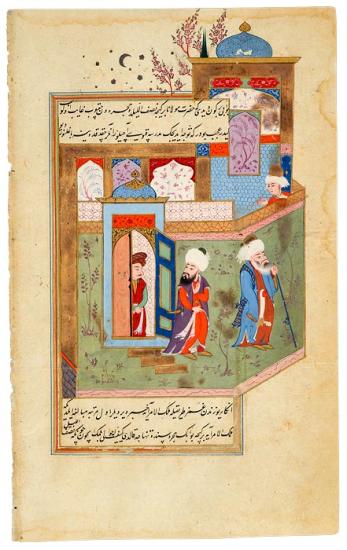
Rūmī Leaves the ḤalĀwiyya Madrasa at Aleppo at Midnight Followed by his Teac;her KamĀl Al-Din Ibn Cadīm, Ruler of Aleppo
Tarjuma-i Thawāqib-i manāqib (A Translation of Stars of the Legend), in Turkish
The translation was ordered in 1590 by Sultan Murād II (r. 1574–95) from the Persian abridgement of Aflākī.
Purchased by Pierpont Morgan, 1911
According to the accompanying text, some were jealous of the privilege Rūmī enjoyed at the school, complaining to the ruler of Aleppo that he often left his cell at midnight for some unknown, possibly immoral, purpose. One night, after the gates miraculously open, as shown here, the teacher decides to follow Rūmī, urging the gatekeeper not to alert him. He tracked him to the Khalīl al-Raḥman (Abraham) Mosque in Hebron, 350 miles away, where he saw Rūmī greeted by angels in green raiment. According to Aflākī (the author of the text from which this translation derives), it was the site of the tomb of Abraham, the spot where Nimrod threw Abraham into the fire. The teacher became disoriented, was discovered near death, recovered, and became a disciple of Rūmī.
This miniature is part of a sixteenth-century manuscript account of the life and miracles of the Persian poet and mystic known as Rūmī. It is a Turkish translation of an abridged version of the original fourteenth-century Persian account by the dervish known as Aflākī.
Rūmī, Persian Mystic And Poet
The sixteenth-century miniatures presented here concern the life and miracles of Jalāl al-Dīn Rūmī, called Mē vlāna (Our Master), the most famous member of the Mevlevī order and Persia's greatest Sufi mystic and poet. He was born in Balkh in 1207, but his family emigrated after his father foresaw the Mongol conquest. They eventually resettled in Konya, Turkey, then the capital of Anatolian Rūm (thus Rūmī), where the poet died on 17 December 1273.
Several Persian accounts of Rūmī's life have been written, the first by his son, Sultan Walad. The third, laden with moralizing miracle stories, was ordered by Rūmī's grandson Ulu ˓Ārif Chelebi. It was written by the dervish Shams al-Dīn Aḥmad, called Aflākī (d. 1360). Aflākī also incorporated verses from Rūmī's works, notably his six-volume Masnavī (a poetical form of rhyming couplets) and the Dīvān-i-Shams al-Dīn Tabrīzī, named after Shams of Tabriz, the mystic who changed Rūmī's life and transformed him into a poet when they met in 1244.
In 1590—three and a half centuries after Aflākī wrote his life of Rūmī—the Ottoman sultan Mūrad III ordered a Turkish translation of a 1540 abridged version of Aflākī's text entitled Tarjuma-i Thawāqib-i manāqib (Stars of the Legend). The translator was Darvīsh Mahmud Mesnevī Khān of Konya. Two illustrated copies of the Murād translation, both made in Baghdad, survive. One, dated 1599, is held by Topkapi Palace, Istanbul, and has twenty-two miniatures. The other, richer manuscript is held by the Morgan. It dates to the 1590s and includes twenty-nine miniatures. They are all featured here, along with two folios from other collections that are believed to have once been part of the Morgan manuscript.
Religious Dispute Between Rūmī
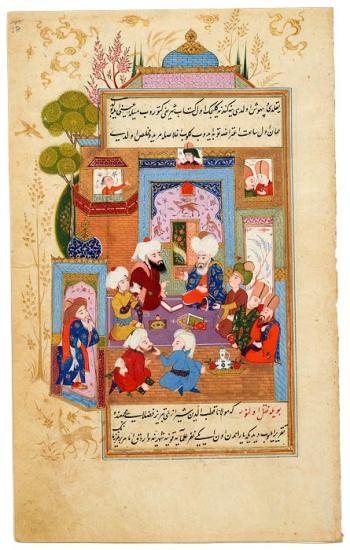
Religious Dispute Between Rūmī and the QaḌi SirĀj Al-Dīn Ormavī
Tarjuma-i Thawāqib-i manāqib (A Translation of Stars of the Legend), in Turkish
The translation was ordered in 1590 by Sultan Murād III (r. 1574–95) from the Persian abridgement of Aflākī.
Purchased by Pierpont Morgan, 1911
The discussion takes place in a Sufi madrasa, to judge by the old doorkeeper at the left, who wears the Mevlevī hat and leans on the traditional long staff. Rūmī, in a gold-patterned blue robe, faces the qaḍi (a judge of Islamic law), in a brown robe. The judge had rejected a certain fatwa (legal opinion) by Rūmī, but when the latter provided an exact textual reference, the judge fainted, later quoted it, and became a follower. In the foreground, a seated youth pulls the beard of the older man seated next to him.
This miniature is part of a sixteenth-century manuscript account of the life and miracles of the Persian poet and mystic known as Rūmī. It is a Turkish translation of an abridged version of the original fourteenth-century Persian account by the dervish known as Aflākī.
Rūmī, Persian Mystic And Poet
The sixteenth-century miniatures presented here concern the life and miracles of Jalāl al-Dīn Rūmī, called Mē vlāna (Our Master), the most famous member of the Mevlevī order and Persia's greatest Sufi mystic and poet. He was born in Balkh in 1207, but his family emigrated after his father foresaw the Mongol conquest. They eventually resettled in Konya, Turkey, then the capital of Anatolian Rūm (thus Rūmī), where the poet died on 17 December 1273.
Several Persian accounts of Rūmī's life have been written, the first by his son, Sultan Walad. The third, laden with moralizing miracle stories, was ordered by Rūmī's grandson Ulu ˓Ārif Chelebi. It was written by the dervish Shams al-Dīn Aḥmad, called Aflākī (d. 1360). Aflākī also incorporated verses from Rūmī's works, notably his six-volume Masnavī (a poetical form of rhyming couplets) and the Dīvān-i-Shams al-Dīn Tabrīzī, named after Shams of Tabriz, the mystic who changed Rūmī's life and transformed him into a poet when they met in 1244.
In 1590—three and a half centuries after Aflākī wrote his life of Rūmī—the Ottoman sultan Mūrad III ordered a Turkish translation of a 1540 abridged version of Aflākī's text entitled Tarjuma-i Thawāqib-i manāqib (Stars of the Legend). The translator was Darvīsh Mahmud Mesnevī Khān of Konya. Two illustrated copies of the Murād translation, both made in Baghdad, survive. One, dated 1599, is held by Topkapi Palace, Istanbul, and has twenty-two miniatures. The other, richer manuscript is held by the Morgan. It dates to the 1590s and includes twenty-nine miniatures. They are all featured here, along with two folios from other collections that are believed to have once been part of the Morgan manuscript.
A Young Merchant and Rūmī
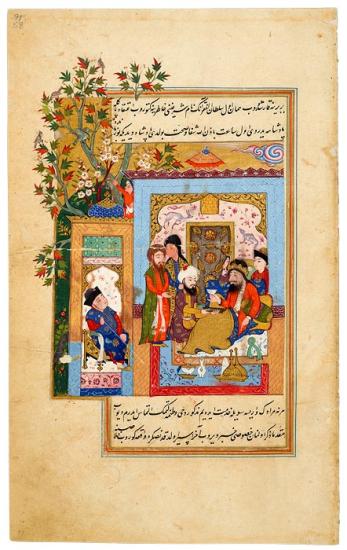
A Young Merchant and Rūmī Follower Cures the Gravely Ill Frankish King in Eqypt
Tarjuma-i Thawāqib-i manāqib (A Translation of Stars of the Legend), in Turkish
The translation was ordered in 1590 by Sultan Murād III (r. 1574–95) from the Persian abridgement of Aflākī.
Purchased by Pierpont Morgan, 1911
According to the story, the young merchant went to Egypt against the advice of Rūmī, where he was captured and imprisoned by the crusaders. Though a prisoner, he was able, with Rūmī's intercession, to heal the ailing leader of the Franks. Thereafter the merchant was freed and the entire Frankish household was converted to Islam. In the miniature the ailing Frank takes the cup offered by the physician. The king is surrounded by his household, including the woman peeking at the consultation from behind the curtained doorway. In the foreground are various containers and a conical loaf of sugar.
This miniature is part of a sixteenth-century manuscript account of the life and miracles of the Persian poet and mystic known as Rūmī. It is a Turkish translation of an abridged version of the original fourteenth-century Persian account by the dervish known as Aflākī.
Rūmī, Persian Mystic And Poet
The sixteenth-century miniatures presented here concern the life and miracles of Jalāl al-Dīn Rūmī, called Mē vlāna (Our Master), the most famous member of the Mevlevī order and Persia's greatest Sufi mystic and poet. He was born in Balkh in 1207, but his family emigrated after his father foresaw the Mongol conquest. They eventually resettled in Konya, Turkey, then the capital of Anatolian Rūm (thus Rūmī), where the poet died on 17 December 1273.
Several Persian accounts of Rūmī's life have been written, the first by his son, Sultan Walad. The third, laden with moralizing miracle stories, was ordered by Rūmī's grandson Ulu ˓Ārif Chelebi. It was written by the dervish Shams al-Dīn Aḥmad, called Aflākī (d. 1360). Aflākī also incorporated verses from Rūmī's works, notably his six-volume Masnavī (a poetical form of rhyming couplets) and the Dīvān-i-Shams al-Dīn Tabrīzī, named after Shams of Tabriz, the mystic who changed Rūmī's life and transformed him into a poet when they met in 1244.
In 1590—three and a half centuries after Aflākī wrote his life of Rūmī—the Ottoman sultan Mūrad III ordered a Turkish translation of a 1540 abridged version of Aflākī's text entitled Tarjuma-i Thawāqib-i manāqib (Stars of the Legend). The translator was Darvīsh Mahmud Mesnevī Khān of Konya. Two illustrated copies of the Murād translation, both made in Baghdad, survive. One, dated 1599, is held by Topkapi Palace, Istanbul, and has twenty-two miniatures. The other, richer manuscript is held by the Morgan. It dates to the 1590s and includes twenty-nine miniatures. They are all featured here, along with two folios from other collections that are believed to have once been part of the Morgan manuscript.
Water Monster
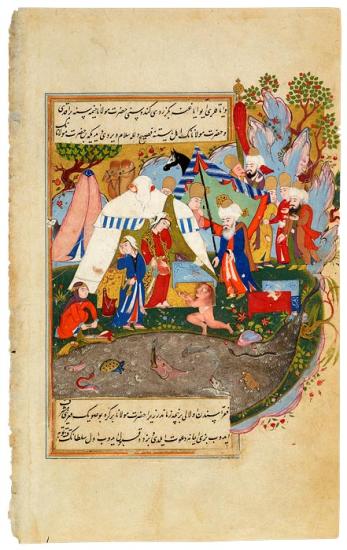
A Water Monster Begs Rūmī's Wife to Intercede for Him
Tarjuma-i Thawāqib-i manāqib (A Translation of Stars of the Legend), in Turkish
The translation was ordered in 1590 by Sultan Murād III (r. 1574–95) from the Persian abridgement of Aflākī.
Purchased by Pierpont Morgan, 1911
On their way to the bath of Ilghin, outside Konya, Rūmī and his party camp by a river inhabited by [S]u Essā, "the lord of the water." Every year the monster drowns a person or animal from the neighboring community. After Rūmī jumped in the river to meet him, [S]u Essā wanted to change his ways. Not considering it proper to present himself to Rūmī, he asked Kerā Khātūn, Rūmī's second wife, to intercede on his behalf. The strategy worked: Rūmī forgave the monster, who then brought precious pearls to his wife.
Here Rūmī's wife, regarded as a second Virgin Mary on account of her purity, modestly hides her face as her husband approaches. The lake is teeming with life; the artist indicated the far side of the lake by drawing the landscape upside down.
Rūmī, Persian Mystic And Poet
The sixteenth-century miniatures presented here concern the life and miracles of Jalāl al-Dīn Rūmī, called Mē vlāna (Our Master), the most famous member of the Mevlevī order and Persia's greatest Sufi mystic and poet. He was born in Balkh in 1207, but his family emigrated after his father foresaw the Mongol conquest. They eventually resettled in Konya, Turkey, then the capital of Anatolian Rūm (thus Rūmī), where the poet died on 17 December 1273.
Several Persian accounts of Rūmī's life have been written, the first by his son, Sultan Walad. The third, laden with moralizing miracle stories, was ordered by Rūmī's grandson Ulu ˓Ārif Chelebi. It was written by the dervish Shams al-Dīn Aḥmad, called Aflākī (d. 1360). Aflākī also incorporated verses from Rūmī's works, notably his six-volume Masnavī (a poetical form of rhyming couplets) and the Dīvān-i-Shams al-Dīn Tabrīzī, named after Shams of Tabriz, the mystic who changed Rūmī's life and transformed him into a poet when they met in 1244.
In 1590—three and a half centuries after Aflākī wrote his life of Rūmī—the Ottoman sultan Mūrad III ordered a Turkish translation of a 1540 abridged version of Aflākī's text entitled Tarjuma-i Thawāqib-i manāqib (Stars of the Legend). The translator was Darvīsh Mahmud Mesnevī Khān of Konya. Two illustrated copies of the Murād translation, both made in Baghdad, survive. One, dated 1599, is held by Topkapi Palace, Istanbul, and has twenty-two miniatures. The other, richer manuscript is held by the Morgan. It dates to the 1590s and includes twenty-nine miniatures. They are all featured here, along with two folios from other collections that are believed to have once been part of the Morgan manuscript.
Dogs in a Market
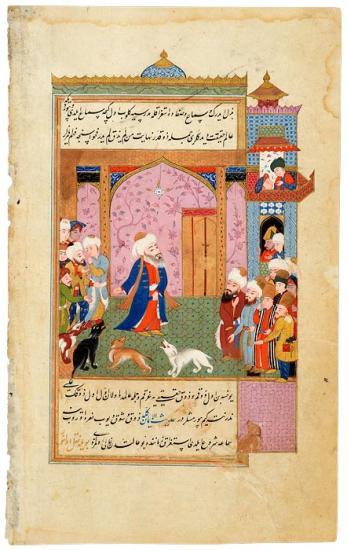
Dogs in a Market Listen to Rūmī, Who Praises their Understanding and Attention
Tarjuma-i Thawāqib-i manāqib (A Translation of Stars of the Legend), in Turkish
The translation was ordered in 1590 by Sultan Murād III (r. 1574–95) from the Persian abridgement of Aflākī.
Purchased by Pierpont Morgan, 1911
Several dogs in the foreground listen to a speech by Rūmī, who, pointing to the dogs, addresses a crowd in a courtyard. While dogs were generally not highly esteemed, Rūmī praises their understanding and attention, calling them "relatives of the dog of the Seven Sleepers" and reciting a distich (two-line verse) about love and paradise. Unlike the Christian story of the "Seven Sleepers of Ephesus," who were walled up in a cave, the version in the Qur˒an (sura 18: 9–6) includes a faithful dog that kept watch at the entrance while the youths slept. Seeking refuge from persecution by Decius, seven Christian youths hid in a cave, where they fell asleep. The emperor then sealed the cave. When it was opened several centuries later, the youths awoke, thinking only a night had passed.
This miniature is part of a sixteenth-century manuscript account of the life and miracles of the Persian poet and mystic known as Rūmī. It is a Turkish translation of an abridged version of the original fourteenth-century Persian account by the dervish known as Aflākī.
Rūmī, Persian Mystic And Poet
The sixteenth-century miniatures presented here concern the life and miracles of Jalāl al-Dīn Rūmī, called Mē vlāna (Our Master), the most famous member of the Mevlevī order and Persia's greatest Sufi mystic and poet. He was born in Balkh in 1207, but his family emigrated after his father foresaw the Mongol conquest. They eventually resettled in Konya, Turkey, then the capital of Anatolian Rūm (thus Rūmī), where the poet died on 17 December 1273.
Several Persian accounts of Rūmī's life have been written, the first by his son, Sultan Walad. The third, laden with moralizing miracle stories, was ordered by Rūmī's grandson Ulu ˓Ārif Chelebi. It was written by the dervish Shams al-Dīn Aḥmad, called Aflākī (d. 1360). Aflākī also incorporated verses from Rūmī's works, notably his six-volume Masnavī (a poetical form of rhyming couplets) and the Dīvān-i-Shams al-Dīn Tabrīzī, named after Shams of Tabriz, the mystic who changed Rūmī's life and transformed him into a poet when they met in 1244.
In 1590—three and a half centuries after Aflākī wrote his life of Rūmī—the Ottoman sultan Mūrad III ordered a Turkish translation of a 1540 abridged version of Aflākī's text entitled Tarjuma-i Thawāqib-i manāqib (Stars of the Legend). The translator was Darvīsh Mahmud Mesnevī Khān of Konya. Two illustrated copies of the Murād translation, both made in Baghdad, survive. One, dated 1599, is held by Topkapi Palace, Istanbul, and has twenty-two miniatures. The other, richer manuscript is held by the Morgan. It dates to the 1590s and includes twenty-nine miniatures. They are all featured here, along with two folios from other collections that are believed to have once been part of the Morgan manuscript.
Story of Seth
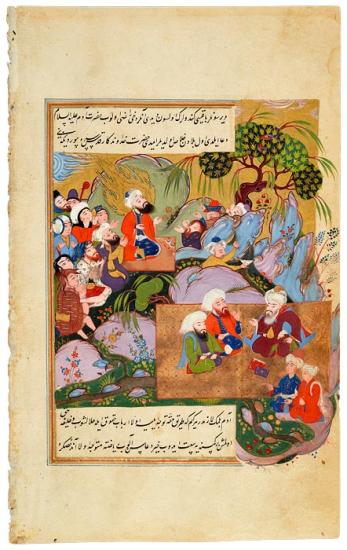
Rūmī Tells His Disciples the Story of Seth
Tarjuma-i Thawāqib-i manāqib (A Translation of Stars of the Legend), in Turkish
The translation was ordered in 1590 by Sultan Murād III (r. 1574–95) from the Persian abridgement of Aflākī.
Purchased by Pierpont Morgan, 1911
Seated on a tan mat, Rūmī tells his disciples about Seth, the spiritual heir of Adam who was regarded as a prophet. Seth's envious brothers, mocking him, were punished by God with drought and poverty, whereas Seth was taught weaving and sewing to earn a living. After the brothers realized their error, they sought forgiveness from Seth, who then prayed to God for rain. Here, Seth, with a flaming halo, sits at the upper left. A blue cloud emerges, saving the crops of the brothers, who may be the figures dressed in animals skins at the far left. A youth in the center collects water from a spring. For Rūmī, the moral is that all should follow the prophets and saints, and rulers should care for their subjects.
This miniature is part of a sixteenth-century manuscript account of the life and miracles of the Persian poet and mystic known as Rūmī. It is a Turkish translation of an abridged version of the original fourteenth-century Persian account by the dervish known as Aflākī.
Rūmī, Persian Mystic And Poet
The sixteenth-century miniatures presented here concern the life and miracles of Jalāl al-Dīn Rūmī, called Mē vlāna (Our Master), the most famous member of the Mevlevī order and Persia's greatest Sufi mystic and poet. He was born in Balkh in 1207, but his family emigrated after his father foresaw the Mongol conquest. They eventually resettled in Konya, Turkey, then the capital of Anatolian Rūm (thus Rūmī), where the poet died on 17 December 1273.
Several Persian accounts of Rūmī's life have been written, the first by his son, Sultan Walad. The third, laden with moralizing miracle stories, was ordered by Rūmī's grandson Ulu ˓Ārif Chelebi. It was written by the dervish Shams al-Dīn Aḥmad, called Aflākī (d. 1360). Aflākī also incorporated verses from Rūmī's works, notably his six-volume Masnavī (a poetical form of rhyming couplets) and the Dīvān-i-Shams al-Dīn Tabrīzī, named after Shams of Tabriz, the mystic who changed Rūmī's life and transformed him into a poet when they met in 1244.
In 1590—three and a half centuries after Aflākī wrote his life of Rūmī—the Ottoman sultan Mūrad III ordered a Turkish translation of a 1540 abridged version of Aflākī's text entitled Tarjuma-i Thawāqib-i manāqib (Stars of the Legend). The translator was Darvīsh Mahmud Mesnevī Khān of Konya. Two illustrated copies of the Murād translation, both made in Baghdad, survive. One, dated 1599, is held by Topkapi Palace, Istanbul, and has twenty-two miniatures. The other, richer manuscript is held by the Morgan. It dates to the 1590s and includes twenty-nine miniatures. They are all featured here, along with two folios from other collections that are believed to have once been part of the Morgan manuscript.
Construction of a Theological School

A Man Tells Rūmī About the Construction of a Theological School
Tarjuma-i Thawāqib-i manāqib (A Translation of Stars of the Legend), in Turkish
The translation was ordered in 1590 by Sultan Murād III (r. 1574–95) from the Persian abridgement of Aflākī.
Purchased by Pierpont Morgan, 1911
Rūmī, wearing the tall felt hat of his order, and a red bearded man are seated in the schoolroom of a madrasa (school). Behind them is a mihrab niche, found in the wall of mosques, which indicates the direction of prayer. In front of them, and in a smaller room on the left, students converse and study. On the minaret two men, their hands to their ears, give the call to prayer. The richly clad youth in the doorway may be the patron of the building, possibly the young Ḥasan Pasha, son of the Grand Vizier Soqollu Muḥammad Pasha and governor of Baghdad (r. 1598–1602), the patron of several Baghdad school manuscripts.
This miniature is part of a sixteenth-century manuscript account of the life and miracles of the Persian poet and mystic known as Rūmī. It is a Turkish translation of an abridged version of the original fourteenth-century Persian account by the dervish known as Aflākī.
Rūmī, Persian Mystic And Poet
The sixteenth-century miniatures presented here concern the life and miracles of Jalāl al-Dīn Rūmī, called Mē vlāna (Our Master), the most famous member of the Mevlevī order and Persia's greatest Sufi mystic and poet. He was born in Balkh in 1207, but his family emigrated after his father foresaw the Mongol conquest. They eventually resettled in Konya, Turkey, then the capital of Anatolian Rūm (thus Rūmī), where the poet died on 17 December 1273.
Several Persian accounts of Rūmī's life have been written, the first by his son, Sultan Walad. The third, laden with moralizing miracle stories, was ordered by Rūmī's grandson Ulu ˓Ārif Chelebi. It was written by the dervish Shams al-Dīn Aḥmad, called Aflākī (d. 1360). Aflākī also incorporated verses from Rūmī's works, notably his six-volume Masnavī (a poetical form of rhyming couplets) and the Dīvān-i-Shams al-Dīn Tabrīzī, named after Shams of Tabriz, the mystic who changed Rūmī's life and transformed him into a poet when they met in 1244.
In 1590—three and a half centuries after Aflākī wrote his life of Rūmī—the Ottoman sultan Mūrad III ordered a Turkish translation of a 1540 abridged version of Aflākī's text entitled Tarjuma-i Thawāqib-i manāqib (Stars of the Legend). The translator was Darvīsh Mahmud Mesnevī Khān of Konya. Two illustrated copies of the Murād translation, both made in Baghdad, survive. One, dated 1599, is held by Topkapi Palace, Istanbul, and has twenty-two miniatures. The other, richer manuscript is held by the Morgan. It dates to the 1590s and includes twenty-nine miniatures. They are all featured here, along with two folios from other collections that are believed to have once been part of the Morgan manuscript.
Mystical Scene
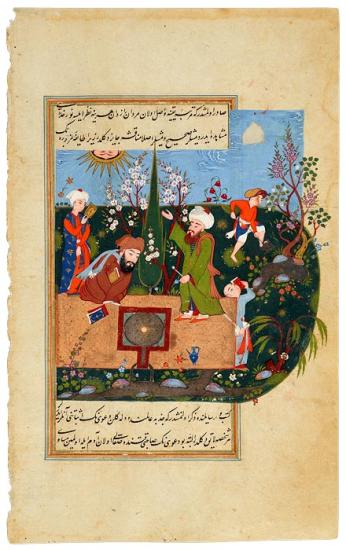
Mystical Scene with Shams Al-Dīn Tabrīzī and the Reflection of Sun in a Pool
Tarjuma-i Thawāqib-i manāqib (A Translation of Stars of the Legend), in Turkish
The translation was ordered in 1590 by Sultan Murād III (r. 1574–95) from the Persian abridgement of Aflākī.
Purchased by Pierpont Morgan, 1911
Shams of Tabriz was a wandering Sufi mystic and Rūmī's spiritual instructor. Their encounter and friendship provided a transforming experience that forever changed Rūmī's life. His disappearance led to Rūmī's Dīvān, written in his memory: The face of Shams al-Dīn, Tabriz's glory, is the sun, in whose track the cloud-like hearts are moving.
Shams means "Sun," and he was certainly Rūmī's sun. Here, Shams, in a brown cloak, sees the reflection of the sun in the center of a small pool, while Rūmī points to the upside-down face of the sun itself. For Shams, the pool is a symbol of paradise. The entwining cypress and blossoming fruit tree is a metaphor for the love between Rūmī and Shams.
This miniature is part of a sixteenth-century manuscript account of the life and miracles of the Persian poet and mystic known as Rūmī. It is a Turkish translation of an abridged version of the original fourteenth-century Persian account by the dervish known as Aflākī.
Rūmī, Persian Mystic And Poet
The sixteenth-century miniatures presented here concern the life and miracles of Jalāl al-Dīn Rūmī, called Mē vlāna (Our Master), the most famous member of the Mevlevī order and Persia's greatest Sufi mystic and poet. He was born in Balkh in 1207, but his family emigrated after his father foresaw the Mongol conquest. They eventually resettled in Konya, Turkey, then the capital of Anatolian Rūm (thus Rūmī), where the poet died on 17 December 1273.
Several Persian accounts of Rūmī's life have been written, the first by his son, Sultan Walad. The third, laden with moralizing miracle stories, was ordered by Rūmī's grandson Ulu ˓Ārif Chelebi. It was written by the dervish Shams al-Dīn Aḥmad, called Aflākī (d. 1360). Aflākī also incorporated verses from Rūmī's works, notably his six-volume Masnavī (a poetical form of rhyming couplets) and the Dīvān-i-Shams al-Dīn Tabrīzī, named after Shams of Tabriz, the mystic who changed Rūmī's life and transformed him into a poet when they met in 1244.
In 1590—three and a half centuries after Aflākī wrote his life of Rūmī—the Ottoman sultan Mūrad III ordered a Turkish translation of a 1540 abridged version of Aflākī's text entitled Tarjuma-i Thawāqib-i manāqib (Stars of the Legend). The translator was Darvīsh Mahmud Mesnevī Khān of Konya. Two illustrated copies of the Murād translation, both made in Baghdad, survive. One, dated 1599, is held by Topkapi Palace, Istanbul, and has twenty-two miniatures. The other, richer manuscript is held by the Morgan. It dates to the 1590s and includes twenty-nine miniatures. They are all featured here, along with two folios from other collections that are believed to have once been part of the Morgan manuscript.
Day in the Hot Baths
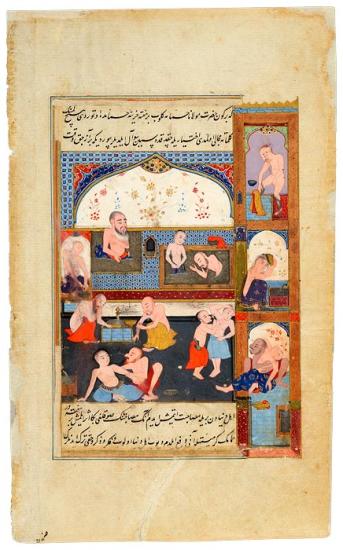
Rūmī Spends a Day in the Hot Baths of a Ḥammam
Tarjuma-i Thawāqib-i manāqib (A Translation of Stars of the Legend), in Turkish
The translation was ordered in 1590 by Sultan Murād III (r. 1574–95) from the Persian abridgement of Aflākī.
Purchased by Pierpont Morgan, 1911
Bathing was a traditional pastime for Sufis, and for Rūmī, in various stories and poems, the bath served as a metaphor for spiritual purification. Many scenes, therefore, were set within bathhouses. Here Rūmī sits by himself in one of the two pools set within the arched recess to cure a cold caused by "contact with the vain people." Elsewhere, and with a certain amount of humor, various bathhouse activities are depicted.
This miniature is part of a sixteenth-century manuscript account of the life and miracles of the Persian poet and mystic known as Rūmī. It is a Turkish translation of an abridged version of the original fourteenth-century Persian account by the dervish known as Aflākī.
Rūmī, Persian Mystic And Poet
The sixteenth-century miniatures presented here concern the life and miracles of Jalāl al-Dīn Rūmī, called Mē vlāna (Our Master), the most famous member of the Mevlevī order and Persia's greatest Sufi mystic and poet. He was born in Balkh in 1207, but his family emigrated after his father foresaw the Mongol conquest. They eventually resettled in Konya, Turkey, then the capital of Anatolian Rūm (thus Rūmī), where the poet died on 17 December 1273.
Several Persian accounts of Rūmī's life have been written, the first by his son, Sultan Walad. The third, laden with moralizing miracle stories, was ordered by Rūmī's grandson Ulu ˓Ārif Chelebi. It was written by the dervish Shams al-Dīn Aḥmad, called Aflākī (d. 1360). Aflākī also incorporated verses from Rūmī's works, notably his six-volume Masnavī (a poetical form of rhyming couplets) and the Dīvān-i-Shams al-Dīn Tabrīzī, named after Shams of Tabriz, the mystic who changed Rūmī's life and transformed him into a poet when they met in 1244.
In 1590—three and a half centuries after Aflākī wrote his life of Rūmī—the Ottoman sultan Mūrad III ordered a Turkish translation of a 1540 abridged version of Aflākī's text entitled Tarjuma-i Thawāqib-i manāqib (Stars of the Legend). The translator was Darvīsh Mahmud Mesnevī Khān of Konya. Two illustrated copies of the Murād translation, both made in Baghdad, survive. One, dated 1599, is held by Topkapi Palace, Istanbul, and has twenty-two miniatures. The other, richer manuscript is held by the Morgan. It dates to the 1590s and includes twenty-nine miniatures. They are all featured here, along with two folios from other collections that are believed to have once been part of the Morgan manuscript.
Prophet Muḥammad Reveals to Calī
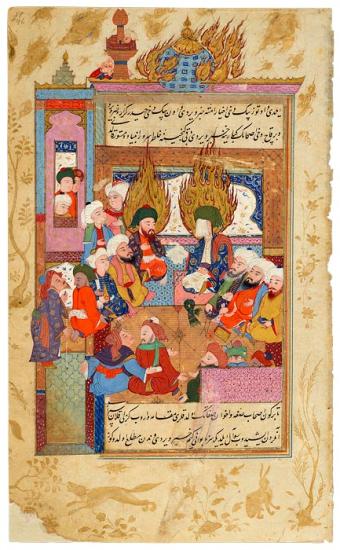
The Prophet Muḥammad Reveals to Calī Secrets Revealed to Him During the Miscrāj (Night Ride to Heaven)
Tarjuma-i Thawāqib-i manāqib (A Translation of Stars of the Legend), in Turkish
The translation was ordered in 1590 by Sultan Murād III (r. 1574–95) from the Persian abridgement of Aflākī.
Purchased by Pierpont Morgan, 1911
Muḥammad, his face veiled, reveals some of the secrets of creation to ˓Alī, his cousin and son-in-law. Both have halos of golden flames, and flames surround the dome of the mosque, signifying a holy event. Ten thousand of the hundred thousand secrets were revealed to ˓Alī alone. Having difficulty keeping them, he shouted them into a well, but a youth made a flute from the tree that grew from the reed in the well, and people came from all over to hear him play. Muḥammad requested to hear the youth perform, declaring that his notes "were the interpretation of the holy mysteries he had confided to ˓Alī." The flute was used ever since as part of the Mevlevī ritual dance (samā˓). Rūmī clearly borrowed the story of the barber who shouted the secret of King Midas's donkey ears into a hole over which reeds grew, the winds whispering the secret to all.
This miniature is part of a sixteenth-century manuscript account of the life and miracles of the Persian poet and mystic known as Rūmī. It is a Turkish translation of an abridged version of the original fourteenth-century Persian account by the dervish known as Aflākī.
Rūmī, Persian Mystic And Poet
The sixteenth-century miniatures presented here concern the life and miracles of Jalāl al-Dīn Rūmī, called Mē vlāna (Our Master), the most famous member of the Mevlevī order and Persia's greatest Sufi mystic and poet. He was born in Balkh in 1207, but his family emigrated after his father foresaw the Mongol conquest. They eventually resettled in Konya, Turkey, then the capital of Anatolian Rūm (thus Rūmī), where the poet died on 17 December 1273.
Several Persian accounts of Rūmī's life have been written, the first by his son, Sultan Walad. The third, laden with moralizing miracle stories, was ordered by Rūmī's grandson Ulu ˓Ārif Chelebi. It was written by the dervish Shams al-Dīn Aḥmad, called Aflākī (d. 1360). Aflākī also incorporated verses from Rūmī's works, notably his six-volume Masnavī (a poetical form of rhyming couplets) and the Dīvān-i-Shams al-Dīn Tabrīzī, named after Shams of Tabriz, the mystic who changed Rūmī's life and transformed him into a poet when they met in 1244.
In 1590—three and a half centuries after Aflākī wrote his life of Rūmī—the Ottoman sultan Mūrad III ordered a Turkish translation of a 1540 abridged version of Aflākī's text entitled Tarjuma-i Thawāqib-i manāqib (Stars of the Legend). The translator was Darvīsh Mahmud Mesnevī Khān of Konya. Two illustrated copies of the Murād translation, both made in Baghdad, survive. One, dated 1599, is held by Topkapi Palace, Istanbul, and has twenty-two miniatures. The other, richer manuscript is held by the Morgan. It dates to the 1590s and includes twenty-nine miniatures. They are all featured here, along with two folios from other collections that are believed to have once been part of the Morgan manuscript.
Execution of Husain Ibn Mansur Al-hallaj
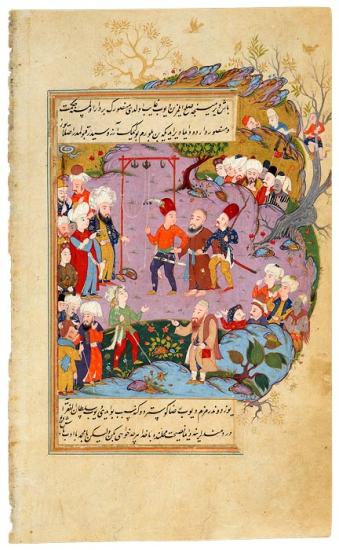
Execution of Ḥusain Ibn Manṣūr Al-ḥallāj Outside the Gates of Baghdad in 922
Tarjuma-i Thawāqib-i manāqib (A Translation of Stars of the Legend), in Turkish
The translation was ordered in 1590 by Sultan Murād III (r. 1574–95) from the Persian abridgement of Aflākī.
Purchased by Pierpont Morgan, 1911
Al-Ḥallāj (858–922), an early Sufi mystic, was condemned for heresy on account of the ecstatic utterances of "I am the Truth," or "I am God." The real reason had to do with political and religious rivalries among the Muslim orthodoxy and Sufis. The dervish in the foreground points to the group on the left, the ulama (religious, as opposed to spiritual, authorities), perhaps implicating them. Rūmī, however, said that al-Ḥallāj was executed because he questioned Muḥammad's judgment in not mediating for non-Muslins during his mi˓rāj (night ride to heaven). Al-Ḥallāj, in brown robes, is led to the gallows by two men wearing the tall red hats of executioners. In the text he asks for Muḥammad's pardon, who grants it in exchange for his head. Before the gallows Al-Ḥallāj said, "I know who asked for my head and I accept it." The Sufi spin, however, suggests that the gallows represent good tidings, promising the union that only death can achieve.
This miniature is part of a sixteenth-century manuscript account of the life and miracles of the Persian poet and mystic known as Rūmī. It is a Turkish translation of an abridged version of the original fourteenth-century Persian account by the dervish known as Aflākī.
Rūmī, Persian Mystic And Poet
The sixteenth-century miniatures presented here concern the life and miracles of Jalāl al-Dīn Rūmī, called Mē vlāna (Our Master), the most famous member of the Mevlevī order and Persia's greatest Sufi mystic and poet. He was born in Balkh in 1207, but his family emigrated after his father foresaw the Mongol conquest. They eventually resettled in Konya, Turkey, then the capital of Anatolian Rūm (thus Rūmī), where the poet died on 17 December 1273.
Several Persian accounts of Rūmī's life have been written, the first by his son, Sultan Walad. The third, laden with moralizing miracle stories, was ordered by Rūmī's grandson Ulu ˓Ārif Chelebi. It was written by the dervish Shams al-Dīn Aḥmad, called Aflākī (d. 1360). Aflākī also incorporated verses from Rūmī's works, notably his six-volume Masnavī (a poetical form of rhyming couplets) and the Dīvān-i-Shams al-Dīn Tabrīzī, named after Shams of Tabriz, the mystic who changed Rūmī's life and transformed him into a poet when they met in 1244.
In 1590—three and a half centuries after Aflākī wrote his life of Rūmī—the Ottoman sultan Mūrad III ordered a Turkish translation of a 1540 abridged version of Aflākī's text entitled Tarjuma-i Thawāqib-i manāqib (Stars of the Legend). The translator was Darvīsh Mahmud Mesnevī Khān of Konya. Two illustrated copies of the Murād translation, both made in Baghdad, survive. One, dated 1599, is held by Topkapi Palace, Istanbul, and has twenty-two miniatures. The other, richer manuscript is held by the Morgan. It dates to the 1590s and includes twenty-nine miniatures. They are all featured here, along with two folios from other collections that are believed to have once been part of the Morgan manuscript.
An Escaped Bull Seeks Refuge at Rumi's Feet
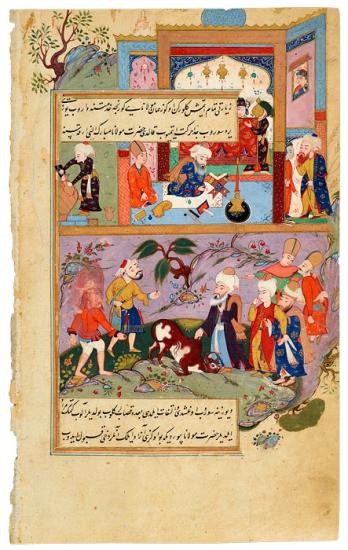
An Escaped Bull Seeks Refuge at Rūmī's Feet
arjuma-i Thawāqib-i manāqib (A Translation of Stars of the Legend), in Turkish
The translation was ordered in 1590 by Sultan Murād III (r. 1574–95) from the Persian abridgement of Aflākī.
Purchased by Pierpont Morgan, 1911
At the top, Rūmī, in the mausoleum of his father, Bahā˒ al-Dīn, reads from a Qur˒an on a wooden stand. The tomb itself is covered in red cloth. In the scene below, a butcher pursues an escaped bull that has sought refuge at the feet of Rūmī, who, along with four students, has just left his father's tomb. Since the bull asked for Rūmī's protection, he asked the butchers to set it free; they comply, and the bull was never seen again. The moral of the story is that those who follow and take refuge with men of God will escape the butchers or demons of hell.
This miniature is part of a sixteenth-century manuscript account of the life and miracles of the Persian poet and mystic known as Rūmī. It is a Turkish translation of an abridged version of the original fourteenth-century Persian account by the dervish known as Aflākī.
Rūmī, Persian Mystic And Poet
The sixteenth-century miniatures presented here concern the life and miracles of Jalāl al-Dīn Rūmī, called Mē vlāna (Our Master), the most famous member of the Mevlevī order and Persia's greatest Sufi mystic and poet. He was born in Balkh in 1207, but his family emigrated after his father foresaw the Mongol conquest. They eventually resettled in Konya, Turkey, then the capital of Anatolian Rūm (thus Rūmī), where the poet died on 17 December 1273.
Several Persian accounts of Rūmī's life have been written, the first by his son, Sultan Walad. The third, laden with moralizing miracle stories, was ordered by Rūmī's grandson Ulu ˓Ārif Chelebi. It was written by the dervish Shams al-Dīn Aḥmad, called Aflākī (d. 1360). Aflākī also incorporated verses from Rūmī's works, notably his six-volume Masnavī (a poetical form of rhyming couplets) and the Dīvān-i-Shams al-Dīn Tabrīzī, named after Shams of Tabriz, the mystic who changed Rūmī's life and transformed him into a poet when they met in 1244.
In 1590—three and a half centuries after Aflākī wrote his life of Rūmī—the Ottoman sultan Mūrad III ordered a Turkish translation of a 1540 abridged version of Aflākī's text entitled Tarjuma-i Thawāqib-i manāqib (Stars of the Legend). The translator was Darvīsh Mahmud Mesnevī Khān of Konya. Two illustrated copies of the Murād translation, both made in Baghdad, survive. One, dated 1599, is held by Topkapi Palace, Istanbul, and has twenty-two miniatures. The other, richer manuscript is held by the Morgan. It dates to the 1590s and includes twenty-nine miniatures. They are all featured here, along with two folios from other collections that are believed to have once been part of the Morgan manuscript.
How to Curb an Appetite
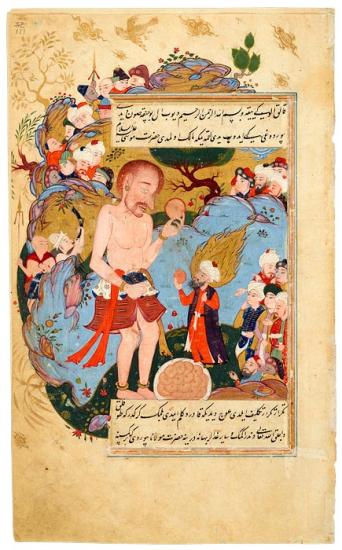
Mūsā (Moses) Tells the Giant Cüj Ibn Canāq How to Curb an Appetite
Tarjuma-i Thawāqib-i manāqib (A Translation of Stars of the Legend), in Turkish
The translation was ordered in 1590 by Sultan Murād III (r. 1574–95) from the Persian abridgement of Aflākī.
Purchased by Pierpont Morgan, 1911
Some highly unusual scenes are depicted in the manuscript, including an encounter between Mūsā and the giant ˓üj (King Og of the Old Testament), whose daily appetite for bread could not be satisfied, even by the output of seventy bakers. One day, upon seeing ˓üj unsatisfied after eating the bread, Mūsā proposes a way for him to be satisfied by only seven mouthfuls. He suggests that before eating, ˓üj should wash his hands and recite the bismillah (In the name of God, the Merciful, the Compassionate) and then take the bowl. But ˓üj is unable to consume even seven mouthfuls. Mūsā then says, "Know that satiety comes from God. Bread is just a pretext."
This miniature is part of a sixteenth-century manuscript account of the life and miracles of the Persian poet and mystic known as Rūmī. It is a Turkish translation of an abridged version of the original fourteenth-century Persian account by the dervish known as Aflākī.
Rūmī, Persian Mystic And Poet
The sixteenth-century miniatures presented here concern the life and miracles of Jalāl al-Dīn Rūmī, called Mē vlāna (Our Master), the most famous member of the Mevlevī order and Persia's greatest Sufi mystic and poet. He was born in Balkh in 1207, but his family emigrated after his father foresaw the Mongol conquest. They eventually resettled in Konya, Turkey, then the capital of Anatolian Rūm (thus Rūmī), where the poet died on 17 December 1273.
Several Persian accounts of Rūmī's life have been written, the first by his son, Sultan Walad. The third, laden with moralizing miracle stories, was ordered by Rūmī's grandson Ulu ˓Ārif Chelebi. It was written by the dervish Shams al-Dīn Aḥmad, called Aflākī (d. 1360). Aflākī also incorporated verses from Rūmī's works, notably his six-volume Masnavī (a poetical form of rhyming couplets) and the Dīvān-i-Shams al-Dīn Tabrīzī, named after Shams of Tabriz, the mystic who changed Rūmī's life and transformed him into a poet when they met in 1244.
In 1590—three and a half centuries after Aflākī wrote his life of Rūmī—the Ottoman sultan Mūrad III ordered a Turkish translation of a 1540 abridged version of Aflākī's text entitled Tarjuma-i Thawāqib-i manāqib (Stars of the Legend). The translator was Darvīsh Mahmud Mesnevī Khān of Konya. Two illustrated copies of the Murād translation, both made in Baghdad, survive. One, dated 1599, is held by Topkapi Palace, Istanbul, and has twenty-two miniatures. The other, richer manuscript is held by the Morgan. It dates to the 1590s and includes twenty-nine miniatures. They are all featured here, along with two folios from other collections that are believed to have once been part of the Morgan manuscript.
A Physician Bleeds a King
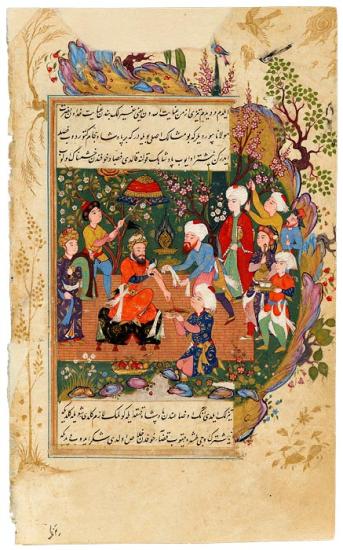
A Physician Bleeds a King
Tarjuma-i Thawāqib-i manāqib (A Translation of Stars of the Legend), in Turkish
The translation was ordered in 1590 by Sultan Murād III (r. 1574–95) from the Persian abridgement of Aflākī.
Purchased by Pierpont Morgan
Bloodletting is an old medical procedure that was once commonly practiced. (George Washington, suffering from acute laryngitis, was bled profusely before his death on 14 December 1799.) Here, in an outdoor garden setting, the court physician lets the blood of his king, which is collected in a golden basin held by a kneeling youth. In the background, between the king and the doctor, an incense burner emits black smoke. (Rūmī, on one occasion, to prove that man lives through God's will alone, and not by blood, had his blood completely drained, went to a hot bath, and performed the samā˓.
This miniature is part of a sixteenth-century manuscript account of the life and miracles of the Persian poet and mystic known as Rūmī. It is a Turkish translation of an abridged version of the original fourteenth-century Persian account by the dervish known as Aflākī.
Rūmī, Persian Mystic And Poet
The sixteenth-century miniatures presented here concern the life and miracles of Jalāl al-Dīn Rūmī, called Mē vlāna (Our Master), the most famous member of the Mevlevī order and Persia's greatest Sufi mystic and poet. He was born in Balkh in 1207, but his family emigrated after his father foresaw the Mongol conquest. They eventually resettled in Konya, Turkey, then the capital of Anatolian Rūm (thus Rūmī), where the poet died on 17 December 1273.
Several Persian accounts of Rūmī's life have been written, the first by his son, Sultan Walad. The third, laden with moralizing miracle stories, was ordered by Rūmī's grandson Ulu ˓Ārif Chelebi. It was written by the dervish Shams al-Dīn Aḥmad, called Aflākī (d. 1360). Aflākī also incorporated verses from Rūmī's works, notably his six-volume Masnavī (a poetical form of rhyming couplets) and the Dīvān-i-Shams al-Dīn Tabrīzī, named after Shams of Tabriz, the mystic who changed Rūmī's life and transformed him into a poet when they met in 1244.
In 1590—three and a half centuries after Aflākī wrote his life of Rūmī—the Ottoman sultan Mūrad III ordered a Turkish translation of a 1540 abridged version of Aflākī's text entitled Tarjuma-i Thawāqib-i manāqib (Stars of the Legend). The translator was Darvīsh Mahmud Mesnevī Khān of Konya. Two illustrated copies of the Murād translation, both made in Baghdad, survive. One, dated 1599, is held by Topkapi Palace, Istanbul, and has twenty-two miniatures. The other, richer manuscript is held by the Morgan. It dates to the 1590s and includes twenty-nine miniatures. They are all featured here, along with two folios from other collections that are believed to have once been part of the Morgan manuscript.
Rumi Meets with His Followers for the Last Time
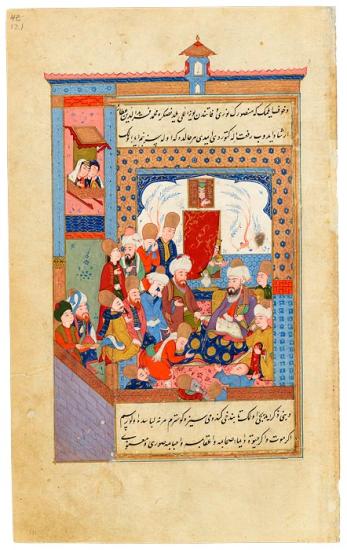
Rūmī Meets with His Followers for the Last Time
Tarjuma-i Thawāqib-i manāqib (A Translation of Stars of the Legend), in Turkish
The translation was ordered in 1590 by Sultan Murād III (r. 1574–95) from the Persian abridgement of Aflākī.
Purchased by Pierpont Morgan, 1911
From his deathbed, his legs covered with a quilt, Rūmī addresses his followers for the last time. Some of the disciples are visibly overcome with grief, while women watch from a distance—one, behind a curtain, about to bring food. He assures them that, as he has guided in life, after his death he will send blessings and will always belong to them, shedding the light of heavenly inspiration on them. "The best of mankind is he who benefits man," he says, and "the best of speech is that which is short and to the purpose." In addition to the followers, an extremely handsome young man appears. It was ˓Azra˒īl (Gabriel), the angel of death, who has been sent by the Exalted One. Rūmī welcomes him, saying, "Draw closer... and do what you have been ordered." On 17 December 1273, as the sun went down, Rūmī died.
This miniature is part of a sixteenth-century manuscript account of the life and miracles of the Persian poet and mystic known as Rūmī. It is a Turkish translation of an abridged version of the original fourteenth-century Persian account by the dervish known as Aflākī.
Rūmī, Persian Mystic And Poet
The sixteenth-century miniatures presented here concern the life and miracles of Jalāl al-Dīn Rūmī, called Mē vlāna (Our Master), the most famous member of the Mevlevī order and Persia's greatest Sufi mystic and poet. He was born in Balkh in 1207, but his family emigrated after his father foresaw the Mongol conquest. They eventually resettled in Konya, Turkey, then the capital of Anatolian Rūm (thus Rūmī), where the poet died on 17 December 1273.
Several Persian accounts of Rūmī's life have been written, the first by his son, Sultan Walad. The third, laden with moralizing miracle stories, was ordered by Rūmī's grandson Ulu ˓Ārif Chelebi. It was written by the dervish Shams al-Dīn Aḥmad, called Aflākī (d. 1360). Aflākī also incorporated verses from Rūmī's works, notably his six-volume Masnavī (a poetical form of rhyming couplets) and the Dīvān-i-Shams al-Dīn Tabrīzī, named after Shams of Tabriz, the mystic who changed Rūmī's life and transformed him into a poet when they met in 1244.
In 1590—three and a half centuries after Aflākī wrote his life of Rūmī—the Ottoman sultan Mūrad III ordered a Turkish translation of a 1540 abridged version of Aflākī's text entitled Tarjuma-i Thawāqib-i manāqib (Stars of the Legend). The translator was Darvīsh Mahmud Mesnevī Khān of Konya. Two illustrated copies of the Murād translation, both made in Baghdad, survive. One, dated 1599, is held by Topkapi Palace, Istanbul, and has twenty-two miniatures. The other, richer manuscript is held by the Morgan. It dates to the 1590s and includes twenty-nine miniatures. They are all featured here, along with two folios from other collections that are believed to have once been part of the Morgan manuscript.
The Funeral of Jalal Al-Din Rumi
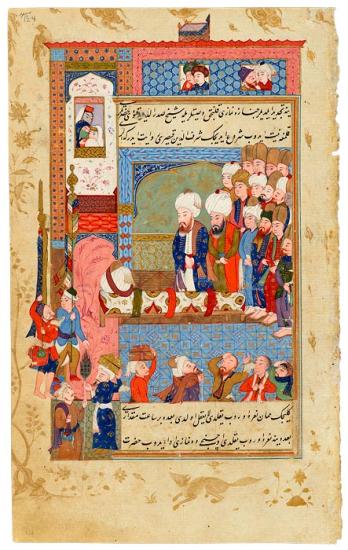
The Funeral of Jalāl Al-Dīn Rūmī
Tarjuma-i Thawāqib-i manāqib (A Translation of Stars of the Legend), in Turkish
The translation was ordered in 1590 by Sultan Murād III (r. 1574–95) from the Persian abridgement of Aflākī.
Purchased by Pierpont Morgan, 1911
Rūmī's body, in a white shroud patterned with red and gold medallions and tiny flowers, has been strapped to a bier for transport to the cemetery. His turban and Mevlevī hat are also on the bier. The procession is about to begin, complete with standard-bearers, a portable incense burner, and book boxes containing Qur˒ans. According to the accompanying text, Rūmī was so revered that the mourners were of all creeds and nations, including Jews and Christians, who explained that from him they had learned more about their own scriptures, finding in him the "signs of and qualities of a prophet and a saint."
This miniature is part of a sixteenth-century manuscript account of the life and miracles of the Persian poet and mystic known as Rūmī. It is a Turkish translation of an abridged version of the original fourteenth-century Persian account by the dervish known as Aflākī.
Rūmī, Persian Mystic And Poet
The sixteenth-century miniatures presented here concern the life and miracles of Jalāl al-Dīn Rūmī, called Mē vlāna (Our Master), the most famous member of the Mevlevī order and Persia's greatest Sufi mystic and poet. He was born in Balkh in 1207, but his family emigrated after his father foresaw the Mongol conquest. They eventually resettled in Konya, Turkey, then the capital of Anatolian Rūm (thus Rūmī), where the poet died on 17 December 1273.
Several Persian accounts of Rūmī's life have been written, the first by his son, Sultan Walad. The third, laden with moralizing miracle stories, was ordered by Rūmī's grandson Ulu ˓Ārif Chelebi. It was written by the dervish Shams al-Dīn Aḥmad, called Aflākī (d. 1360). Aflākī also incorporated verses from Rūmī's works, notably his six-volume Masnavī (a poetical form of rhyming couplets) and the Dīvān-i-Shams al-Dīn Tabrīzī, named after Shams of Tabriz, the mystic who changed Rūmī's life and transformed him into a poet when they met in 1244.
In 1590—three and a half centuries after Aflākī wrote his life of Rūmī—the Ottoman sultan Mūrad III ordered a Turkish translation of a 1540 abridged version of Aflākī's text entitled Tarjuma-i Thawāqib-i manāqib (Stars of the Legend). The translator was Darvīsh Mahmud Mesnevī Khān of Konya. Two illustrated copies of the Murād translation, both made in Baghdad, survive. One, dated 1599, is held by Topkapi Palace, Istanbul, and has twenty-two miniatures. The other, richer manuscript is held by the Morgan. It dates to the 1590s and includes twenty-nine miniatures. They are all featured here, along with two folios from other collections that are believed to have once been part of the Morgan manuscript.
Konya, Besieged
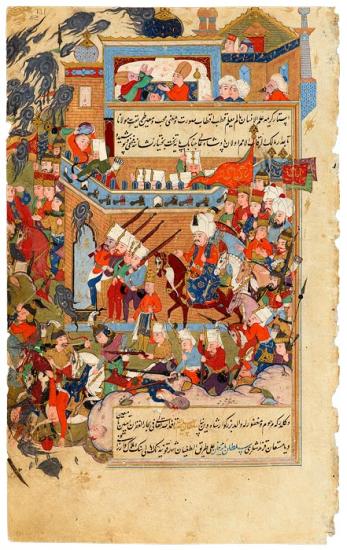
Konya, Besieged During a Fight for the Throne of Sultan Sūleyman's Two Sons, is Protected by Clouds of Salt
Tarjuma-i Thawāqib-i manāqib (A Translation of Stars of the Legend), in Turkish
The translation was ordered in 1590 by Sultan Murād III (r. 1574–95) from the Persian abridgement of Aflākī.
Purchased by Pierpont Morgan, 1911
This scene depicts a miracle that occurs during a 1559 battle between Princes Selim and Beyazid, the two sons of Sūleyman (r. 1520–66) who were vying for the throne. During the battle, the city of Konya is miraculously protected by clouds of salt that emanate from the green-domed tomb of Rūmī and rain down on Prince Beyazid's soldiers, causing them to flee. Here the victorious Selim rides on horseback, while members of the Mevlevī order offer prayers in a room at the top. Beyazid sought refuge with the Safavids, but in 1561 Selim paid to have him strangled, paving his own way to the throne (r. 1566–1574).
This miniature appears in a manuscript of a sixteenth-century Turkish translation of a fourteenth-century life of Rūmī. Since the siege depicted here took place in 1559—many years after the original text was written—this story must have been added by the translator Darvīsh Maḥmūd.
Rūmī, Persian Mystic And Poet
The sixteenth-century miniatures presented here concern the life and miracles of Jalāl al-Dīn Rūmī, called Mē vlāna (Our Master), the most famous member of the Mevlevī order and Persia's greatest Sufi mystic and poet. He was born in Balkh in 1207, but his family emigrated after his father foresaw the Mongol conquest. They eventually resettled in Konya, Turkey, then the capital of Anatolian Rūm (thus Rūmī), where the poet died on 17 December 1273.
Several Persian accounts of Rūmī's life have been written, the first by his son, Sultan Walad. The third, laden with moralizing miracle stories, was ordered by Rūmī's grandson Ulu ˓Ārif Chelebi. It was written by the dervish Shams al-Dīn Aḥmad, called Aflākī (d. 1360). Aflākī also incorporated verses from Rūmī's works, notably his six-volume Masnavī (a poetical form of rhyming couplets) and the Dīvān-i-Shams al-Dīn Tabrīzī, named after Shams of Tabriz, the mystic who changed Rūmī's life and transformed him into a poet when they met in 1244.
In 1590—three and a half centuries after Aflākī wrote his life of Rūmī—the Ottoman sultan Mūrad III ordered a Turkish translation of a 1540 abridged version of Aflākī's text entitled Tarjuma-i Thawāqib-i manāqib (Stars of the Legend). The translator was Darvīsh Mahmud Mesnevī Khān of Konya. Two illustrated copies of the Murād translation, both made in Baghdad, survive. One, dated 1599, is held by Topkapi Palace, Istanbul, and has twenty-two miniatures. The other, richer manuscript is held by the Morgan. It dates to the 1590s and includes twenty-nine miniatures. They are all featured here, along with two folios from other collections that are believed to have once been part of the Morgan manuscript.
Iblis (Satan) Leads Umar

Iblīs (Satan) Leads Umar, the Second Caliph, into a Mosque Containing One Man at Prayer, the Other Sleeping, Saying He Would Destroy the Man Who Prays Because He is in the Ecstasy of the love of God while the Sleeping Man is Only In Oblivion
Tarjuma-i Thawāqib-i manāqib (A Translation of Stars of the Legend), in Turkish
The translation was ordered in 1590 by Sultan Murād III (r. 1574–95) from the Persian abridgement of Aflākī.
Purchased by Pierpont Morgan, 1911
Iblīs (Satan), shown with gold flaming eyes, has taken ˓Umar to visit a mosque. ˓Umar (d. 644), called Fārūq (discriminator) because he could discriminate between right and wrong, was the second caliph (meaning "successor"/"follower") or leader of the Islamic community after the death of Muḥammad in 632. At the mosque they see a standing man, his hands folded, in deep prayer. Beneath the tall minbar (a raised pulpit from which the imam, or prayer leader, delivers his sermon) another man is asleep, his closed books to his side. Iblīs then explains that he would destroy the man that prays, for he is in the ecstasy of the love of God. For Rūmī, the story is an allegory of the power of love, for it is the love of God that will bring about the destruction of Iblīs.
This miniature is part of a sixteenth-century manuscript account of the life and miracles of the Persian poet and mystic known as Rūmī. It is a Turkish translation of an abridged version of the original fourteenth-century Persian account by the dervish known as Aflākī.
Rūmī, Persian Mystic And Poet
The sixteenth-century miniatures presented here concern the life and miracles of Jalāl al-Dīn Rūmī, called Mē vlāna (Our Master), the most famous member of the Mevlevī order and Persia's greatest Sufi mystic and poet. He was born in Balkh in 1207, but his family emigrated after his father foresaw the Mongol conquest. They eventually resettled in Konya, Turkey, then the capital of Anatolian Rūm (thus Rūmī), where the poet died on 17 December 1273.
Several Persian accounts of Rūmī's life have been written, the first by his son, Sultan Walad. The third, laden with moralizing miracle stories, was ordered by Rūmī's grandson Ulu ˓Ārif Chelebi. It was written by the dervish Shams al-Dīn Aḥmad, called Aflākī (d. 1360). Aflākī also incorporated verses from Rūmī's works, notably his six-volume Masnavī (a poetical form of rhyming couplets) and the Dīvān-i-Shams al-Dīn Tabrīzī, named after Shams of Tabriz, the mystic who changed Rūmī's life and transformed him into a poet when they met in 1244.
In 1590—three and a half centuries after Aflākī wrote his life of Rūmī—the Ottoman sultan Mūrad III ordered a Turkish translation of a 1540 abridged version of Aflākī's text entitled Tarjuma-i Thawāqib-i manāqib (Stars of the Legend). The translator was Darvīsh Mahmud Mesnevī Khān of Konya. Two illustrated copies of the Murād translation, both made in Baghdad, survive. One, dated 1599, is held by Topkapi Palace, Istanbul, and has twenty-two miniatures. The other, richer manuscript is held by the Morgan. It dates to the 1590s and includes twenty-nine miniatures. They are all featured here, along with two folios from other collections that are believed to have once been part of the Morgan manuscript.
Husam Al-Din Chelebi
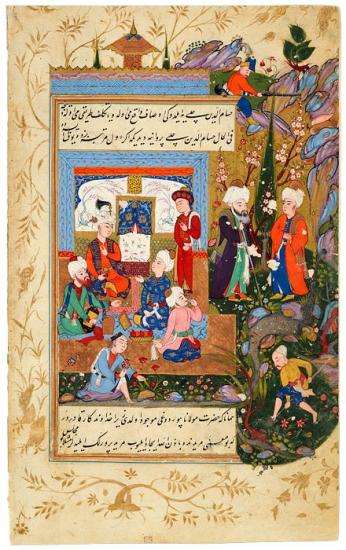
Ḥusām Al-Dīn Chelebi is Brought to a Reception Given for Rūmī by Mucīn Al-Dīn Parvāna, a Minister of Konya
Tarjuma-i Thawāqib-i manāqib (A Translation of Stars of the Legend), in Turkish
The translation was ordered in 1590 by Sultan Murād III (r. 1574–95) from the Persian abridgement of Aflākī.
Purchased by Pierpont Morgan, 1911
Rūmī and Ḥusām Chelebi (d. 1284) are shown in the garden at the right. Rūmī's deep love and yearning for his young disciple and designated successor is indicated by well-known metaphors: the entwined cypress and blossoming fruit tree, the young gardener below, and the youth picking flowers. In the text, Rūmī is described as a nightingale and Ḥusām as a rose. Within the palace the young minister, wearing a white turban with flowers and a black feather, awaits the arrival of Rūmī and his beloved. It was Ḥusām who asked Rūmī to compose a didactic poem for his disciples. Rūmī responded with the "Song of the Reed," the first eighteen verses of the Masnavī, his six-volume poetic work in rhyming couplets. Ḥusām assisted Rūmī by transcribing his 24,660 couplets.
This miniature is part of a sixteenth-century manuscript account of the life and miracles of the Persian poet and mystic known as Rūmī. It is a Turkish translation of an abridged version of the original fourteenth-century Persian account by the dervish known as Aflākī.
Rūmī, Persian Mystic And Poet
The sixteenth-century miniatures presented here concern the life and miracles of Jalāl al-Dīn Rūmī, called Mē vlāna (Our Master), the most famous member of the Mevlevī order and Persia's greatest Sufi mystic and poet. He was born in Balkh in 1207, but his family emigrated after his father foresaw the Mongol conquest. They eventually resettled in Konya, Turkey, then the capital of Anatolian Rūm (thus Rūmī), where the poet died on 17 December 1273.
Several Persian accounts of Rūmī's life have been written, the first by his son, Sultan Walad. The third, laden with moralizing miracle stories, was ordered by Rūmī's grandson Ulu ˓Ārif Chelebi. It was written by the dervish Shams al-Dīn Aḥmad, called Aflākī (d. 1360). Aflākī also incorporated verses from Rūmī's works, notably his six-volume Masnavī (a poetical form of rhyming couplets) and the Dīvān-i-Shams al-Dīn Tabrīzī, named after Shams of Tabriz, the mystic who changed Rūmī's life and transformed him into a poet when they met in 1244.
In 1590—three and a half centuries after Aflākī wrote his life of Rūmī—the Ottoman sultan Mūrad III ordered a Turkish translation of a 1540 abridged version of Aflākī's text entitled Tarjuma-i Thawāqib-i manāqib (Stars of the Legend). The translator was Darvīsh Mahmud Mesnevī Khān of Konya. Two illustrated copies of the Murād translation, both made in Baghdad, survive. One, dated 1599, is held by Topkapi Palace, Istanbul, and has twenty-two miniatures. The other, richer manuscript is held by the Morgan. It dates to the 1590s and includes twenty-nine miniatures. They are all featured here, along with two folios from other collections that are believed to have once been part of the Morgan manuscript.
Husam Al-Din Chelebi, in a Dream
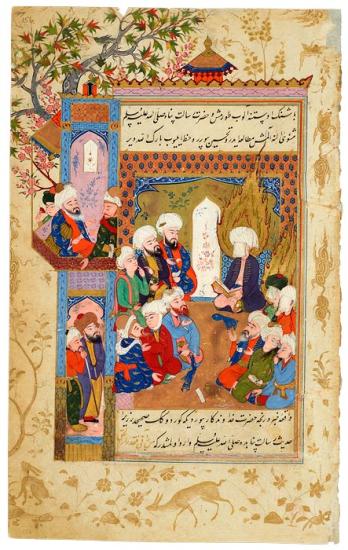
ḤusĀm Al-Dīn Chelebi, in a Dream, Sees the Prophet MuḤammad Reading Rūmī's Masnavī
Tarjuma-i Thawāqib-i manāqib (A Translation of Stars of the Legend), in Turkish
The translation was ordered in 1590 by Sultan Murād III (r. 1574–95) from the Persian abridgement of Aflākī.
Purchased by Pierpont Morgan, 1911
According to Aflākī's biography, Ḥusām Chelebi (d. 1284), Rūmī's beloved successor, dreamed that he not only saw Muḥammad holding and reading from Rūmī's Masnavī, but the prophet also praised the author. Jami, a fifteenth-century poet, went so far as to write that Rūmī's spiritual couplets are the Qur˒an in the Persian tongue. Here, Muḥammad, with a flaming halo and a veil over his face, reads to a group of men, including the young Ḥasan and Ḥusain, sons of ˓Alī and Fāṭima, Muḥammad's daughter. An old man with a Mevlevī turban (Rūmī?) and a young man holding a rose (Ḥusām, Rūmī's beloved disciple?) are seated on the balcony.
This miniature is part of a sixteenth-century manuscript account of the life and miracles of the Persian poet and mystic known as Rūmī. It is a Turkish translation of an abridged version of the original fourteenth-century Persian account by the dervish known as Aflākī.
Rūmī, Persian Mystic And Poet
The sixteenth-century miniatures presented here concern the life and miracles of Jalāl al-Dīn Rūmī, called Mē vlāna (Our Master), the most famous member of the Mevlevī order and Persia's greatest Sufi mystic and poet. He was born in Balkh in 1207, but his family emigrated after his father foresaw the Mongol conquest. They eventually resettled in Konya, Turkey, then the capital of Anatolian Rūm (thus Rūmī), where the poet died on 17 December 1273.
Several Persian accounts of Rūmī's life have been written, the first by his son, Sultan Walad. The third, laden with moralizing miracle stories, was ordered by Rūmī's grandson Ulu ˓Ārif Chelebi. It was written by the dervish Shams al-Dīn Aḥmad, called Aflākī (d. 1360). Aflākī also incorporated verses from Rūmī's works, notably his six-volume Masnavī (a poetical form of rhyming couplets) and the Dīvān-i-Shams al-Dīn Tabrīzī, named after Shams of Tabriz, the mystic who changed Rūmī's life and transformed him into a poet when they met in 1244.
In 1590—three and a half centuries after Aflākī wrote his life of Rūmī—the Ottoman sultan Mūrad III ordered a Turkish translation of a 1540 abridged version of Aflākī's text entitled Tarjuma-i Thawāqib-i manāqib (Stars of the Legend). The translator was Darvīsh Mahmud Mesnevī Khān of Konya. Two illustrated copies of the Murād translation, both made in Baghdad, survive. One, dated 1599, is held by Topkapi Palace, Istanbul, and has twenty-two miniatures. The other, richer manuscript is held by the Morgan. It dates to the 1590s and includes twenty-nine miniatures. They are all featured here, along with two folios from other collections that are believed to have once been part of the Morgan manuscript.
A Samac During the Leadership of Rumi's Successor
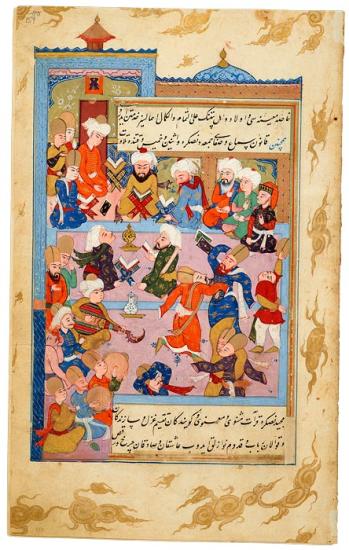
A Samāc During the Leadership of Rūmī's Successor, Ḥusām Al-Dīn Chelebi
Tarjuma-i Thawāqib-i manāqib (A Translation of Stars of the Legend), in Turkish
The translation was ordered in 1590 by Sultan Murād III (r. 1574–95) from the Persian abridgement of Aflākī.
Purchased by Pierpont Morgan, 1911
Although the accompanying text describes the successful leadership of Ḥusām Chelebi (d. 1284), Rūmī's successor, he is not singled out in this image. Rather, the painting seems to depict the various activities taking place in the Mevlevī madrasa: at the top are meditation and theological studies, while at the bottom a samā˓, a mystical ceremony where musical instruments are played and dervishes are whirling, takes place.
This miniature is part of a sixteenth-century manuscript account of the life and miracles of the Persian poet and mystic known as Rūmī. It is a Turkish translation of an abridged version of the original fourteenth-century Persian account by the dervish known as Aflākī.
Rūmī, Persian Mystic And Poet
The sixteenth-century miniatures presented here concern the life and miracles of Jalāl al-Dīn Rūmī, called Mē vlāna (Our Master), the most famous member of the Mevlevī order and Persia's greatest Sufi mystic and poet. He was born in Balkh in 1207, but his family emigrated after his father foresaw the Mongol conquest. They eventually resettled in Konya, Turkey, then the capital of Anatolian Rūm (thus Rūmī), where the poet died on 17 December 1273.
Several Persian accounts of Rūmī's life have been written, the first by his son, Sultan Walad. The third, laden with moralizing miracle stories, was ordered by Rūmī's grandson Ulu ˓Ārif Chelebi. It was written by the dervish Shams al-Dīn Aḥmad, called Aflākī (d. 1360). Aflākī also incorporated verses from Rūmī's works, notably his six-volume Masnavī (a poetical form of rhyming couplets) and the Dīvān-i-Shams al-Dīn Tabrīzī, named after Shams of Tabriz, the mystic who changed Rūmī's life and transformed him into a poet when they met in 1244.
In 1590—three and a half centuries after Aflākī wrote his life of Rūmī—the Ottoman sultan Mūrad III ordered a Turkish translation of a 1540 abridged version of Aflākī's text entitled Tarjuma-i Thawāqib-i manāqib (Stars of the Legend). The translator was Darvīsh Mahmud Mesnevī Khān of Konya. Two illustrated copies of the Murād translation, both made in Baghdad, survive. One, dated 1599, is held by Topkapi Palace, Istanbul, and has twenty-two miniatures. The other, richer manuscript is held by the Morgan. It dates to the 1590s and includes twenty-nine miniatures. They are all featured here, along with two folios from other collections that are believed to have once been part of the Morgan manuscript.
A Confrontation of Akhi Mustafa
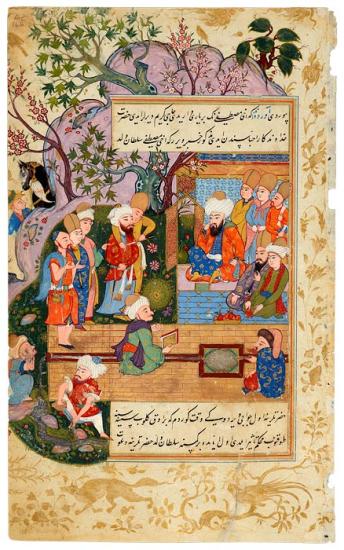
A Confrontation of Akhī Mustafā, a Childhood Friend of Rūmī's Family, and Cārif, Rūmī's Grandson and Head of the Mevlevī Order
Tarjuma-i Thawāqib-i manāqib (A Translation of Stars of the Legend), in Turkish
The translation was ordered in 1590 by Sultan Murād III (r. 1574–95) from the Persian abridgement of Aflākī.
Purchased by Pierpont Morgan, 1911
The confrontation takes place in a garden. ˓Ārif, the legitimate Sufi leader, is seated, and behind him are several young dervishes. Akhī Mustafā and his group approach from the left, when an arrow, though no bowman is present, mysteriously penetrates his heart, as one of the dervishes had imagined. (In the picture it appears that a young dervish is pushing the arrow into Akhī's chest.) A few days later Akhī was killed. The story offers a warning against denying God and his messengers.
This miniature is part of a sixteenth-century manuscript account of the life and miracles of the Persian poet and mystic known as Rūmī. It is a Turkish translation of an abridged version of the original fourteenth-century Persian account by the dervish known as Aflākī.
Rūmī, Persian Mystic And Poet
The sixteenth-century miniatures presented here concern the life and miracles of Jalāl al-Dīn Rūmī, called Mē vlāna (Our Master), the most famous member of the Mevlevī order and Persia's greatest Sufi mystic and poet. He was born in Balkh in 1207, but his family emigrated after his father foresaw the Mongol conquest. They eventually resettled in Konya, Turkey, then the capital of Anatolian Rūm (thus Rūmī), where the poet died on 17 December 1273.
Several Persian accounts of Rūmī's life have been written, the first by his son, Sultan Walad. The third, laden with moralizing miracle stories, was ordered by Rūmī's grandson Ulu ˓Ārif Chelebi. It was written by the dervish Shams al-Dīn Aḥmad, called Aflākī (d. 1360). Aflākī also incorporated verses from Rūmī's works, notably his six-volume Masnavī (a poetical form of rhyming couplets) and the Dīvān-i-Shams al-Dīn Tabrīzī, named after Shams of Tabriz, the mystic who changed Rūmī's life and transformed him into a poet when they met in 1244.
In 1590—three and a half centuries after Aflākī wrote his life of Rūmī—the Ottoman sultan Mūrad III ordered a Turkish translation of a 1540 abridged version of Aflākī's text entitled Tarjuma-i Thawāqib-i manāqib (Stars of the Legend). The translator was Darvīsh Mahmud Mesnevī Khān of Konya. Two illustrated copies of the Murād translation, both made in Baghdad, survive. One, dated 1599, is held by Topkapi Palace, Istanbul, and has twenty-two miniatures. The other, richer manuscript is held by the Morgan. It dates to the 1590s and includes twenty-nine miniatures. They are all featured here, along with two folios from other collections that are believed to have once been part of the Morgan manuscript.
Death of the Mongol Ruler Ghazan Khan
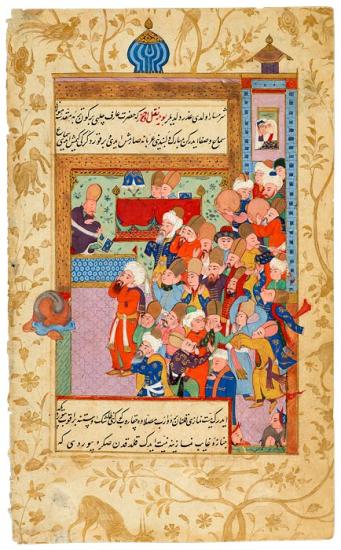
Ulu Cārif Chelebi has an Apparition of the Death of the Mongol Ruler Ghazan Khan
Tarjuma-i Thawāqib-i manāqib (A Translation of Stars of the Legend), in Turkish
The translation was ordered in 1590 by Sultan Murād III (r. 1574–95) from the Persian abridgement of Aflākī.
Purchased by Pierpont Morgan, 1911
Ulu ˓Ārif Chelebi has just left the mausoleum of his ancestors, followed by ecstatic dervishes and musicians, when he senses, from afar, the hour of death of the Mongol ruler Ghazan Khan. ˓Ārif immediately stops dancing to pray for the dead instead. (It was Ghazan Khan who ordered the Persian translation of the Manāfi˓–i ḥayavān, the Morgan's earliest and most important illustrated Islamic manuscript.) On the upper left a seated dervish near a tomb uses a meditation strap to secure his legs to his body.
This miniature is part of a sixteenth-century manuscript account of the life and miracles of the Persian poet and mystic known as Rūmī. It is a Turkish translation of an abridged version of the original fourteenth-century Persian account by the dervish known as Aflākī.
Rūmī, Persian Mystic And Poet
The sixteenth-century miniatures presented here concern the life and miracles of Jalāl al-Dīn Rūmī, called Mē vlāna (Our Master), the most famous member of the Mevlevī order and Persia's greatest Sufi mystic and poet. He was born in Balkh in 1207, but his family emigrated after his father foresaw the Mongol conquest. They eventually resettled in Konya, Turkey, then the capital of Anatolian Rūm (thus Rūmī), where the poet died on 17 December 1273.
Several Persian accounts of Rūmī's life have been written, the first by his son, Sultan Walad. The third, laden with moralizing miracle stories, was ordered by Rūmī's grandson Ulu ˓Ārif Chelebi. It was written by the dervish Shams al-Dīn Aḥmad, called Aflākī (d. 1360). Aflākī also incorporated verses from Rūmī's works, notably his six-volume Masnavī (a poetical form of rhyming couplets) and the Dīvān-i-Shams al-Dīn Tabrīzī, named after Shams of Tabriz, the mystic who changed Rūmī's life and transformed him into a poet when they met in 1244.
In 1590—three and a half centuries after Aflākī wrote his life of Rūmī—the Ottoman sultan Mūrad III ordered a Turkish translation of a 1540 abridged version of Aflākī's text entitled Tarjuma-i Thawāqib-i manāqib (Stars of the Legend). The translator was Darvīsh Mahmud Mesnevī Khān of Konya. Two illustrated copies of the Murād translation, both made in Baghdad, survive. One, dated 1599, is held by Topkapi Palace, Istanbul, and has twenty-two miniatures. The other, richer manuscript is held by the Morgan. It dates to the 1590s and includes twenty-nine miniatures. They are all featured here, along with two folios from other collections that are believed to have once been part of the Morgan manuscript.
Rumi Dancing in the Presence of Three Disciples
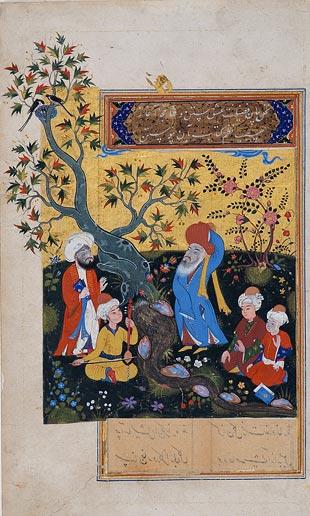
Rūmī Dacing in the Presence of Three Disciples
Tarjuma-i Thawāqib-i manāqib (A Translation of Stars of the Legend), in Turkish
The translation was ordered in 1590 by Sultan Murād III (r. 1574–95) from the Persian abridgement of Aflākī.
Courtesy of the L. A. Mayer Museum for Islamic Art, Jerusalem
To judge from offsets of pigments on text pages, as many as a dozen miniatures are missing from the Morgan manuscript of Tarjuma-i Thawāqib-i manāqib (A Translation of Stars of the Legend). This miniature, now in the collection of the L. A. Mayer Museum for Islamic Art in Jerusalem, may be one of them. Unfortunately the text at the top of the miniature has been cut away and replaced by another heading. Here Rūmī, holding prayer beads in his right hand, dances to music in the company of three seated young disciples while an older man looks on.
Rūmī, Persian Mystic And Poet
The sixteenth-century miniatures presented here concern the life and miracles of Jalāl al-Dīn Rūmī, called Mē vlāna (Our Master), the most famous member of the Mevlevī order and Persia's greatest Sufi mystic and poet. He was born in Balkh in 1207, but his family emigrated after his father foresaw the Mongol conquest. They eventually resettled in Konya, Turkey, then the capital of Anatolian Rūm (thus Rūmī), where the poet died on 17 December 1273.
Several Persian accounts of Rūmī's life have been written, the first by his son, Sultan Walad. The third, laden with moralizing miracle stories, was ordered by Rūmī's grandson Ulu ˓Ārif Chelebi. It was written by the dervish Shams al-Dīn Aḥmad, called Aflākī (d. 1360). Aflākī also incorporated verses from Rūmī's works, notably his six-volume Masnavī (a poetical form of rhyming couplets) and the Dīvān-i-Shams al-Dīn Tabrīzī, named after Shams of Tabriz, the mystic who changed Rūmī's life and transformed him into a poet when they met in 1244.
In 1590—three and a half centuries after Aflākī wrote his life of Rūmī—the Ottoman sultan Mūrad III ordered a Turkish translation of a 1540 abridged version of Aflākī's text entitled Tarjuma-i Thawāqib-i manāqib (Stars of the Legend). The translator was Darvīsh Mahmud Mesnevī Khān of Konya. Two illustrated copies of the Murād translation, both made in Baghdad, survive. One, dated 1599, is held by Topkapi Palace, Istanbul, and has twenty-two miniatures. The other, richer manuscript is held by the Morgan. It dates to the 1590s and includes twenty-nine miniatures. They are all featured here, along with two folios from other collections that are believed to have once been part of the Morgan manuscript.
Rumi Distributing Sweetmeats
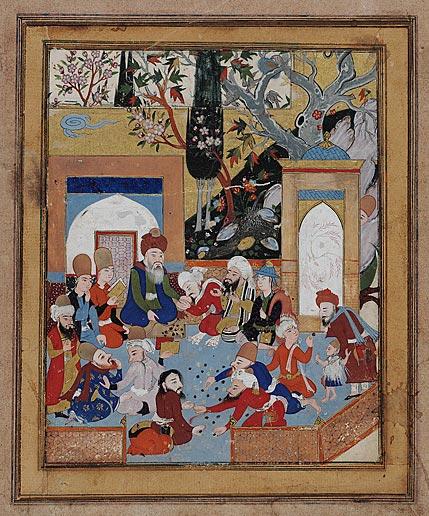
Rūmī Distributing Sweetmeats
Tarjuma-i Thawāqib-i manāqib (A Translation of Stars of the Legend), in Turkish
The translation was ordered in 1590 by Sultan Murād III (r. 1574–95) from the Persian abridgement of Aflākī.
Courtesy of the Museum of Fine Arts, Boston
This miniature, now in the collection of Boston's Museum of Fine Arts, may have once been part of Morgan manuscript of Tarjuma-i Thawāqib-i manāqib (A Translation of Stars of the Legend), though no others have rectangular frames. According to Aflākī, who wrote the original Persian text, Rūmī was given a china bowl of sweetmeats by a lady who wished him to pray for and bless her husband, who was on a pilgrimage to Mecca. Rūmī then distributed the sweetmeats to his disciples, yet the bowl miraculously remained full. He then took the bowl to the roof, returning empty-handed, explaining that he had given it to the lady's husband. When the husband returned from Mecca, his wife found the bowl in his luggage. He then said that an arm inexplicably projected itself into his tent and handed him the bowl. After realizing what happened they went to Rūmī, who said that "God had merely made use of his hand as the instrument wherewith to make manifest His power."
Rūmī, Persian Mystic And Poet
The sixteenth-century miniatures presented here concern the life and miracles of Jalāl al-Dīn Rūmī, called Mē vlāna (Our Master), the most famous member of the Mevlevī order and Persia's greatest Sufi mystic and poet. He was born in Balkh in 1207, but his family emigrated after his father foresaw the Mongol conquest. They eventually resettled in Konya, Turkey, then the capital of Anatolian Rūm (thus Rūmī), where the poet died on 17 December 1273.
Several Persian accounts of Rūmī's life have been written, the first by his son, Sultan Walad. The third, laden with moralizing miracle stories, was ordered by Rūmī's grandson Ulu ˓Ārif Chelebi. It was written by the dervish Shams al-Dīn Aḥmad, called Aflākī (d. 1360). Aflākī also incorporated verses from Rūmī's works, notably his six-volume Masnavī (a poetical form of rhyming couplets) and the Dīvān-i-Shams al-Dīn Tabrīzī, named after Shams of Tabriz, the mystic who changed Rūmī's life and transformed him into a poet when they met in 1244.
In 1590—three and a half centuries after Aflākī wrote his life of Rūmī—the Ottoman sultan Mūrad III ordered a Turkish translation of a 1540 abridged version of Aflākī's text entitled Tarjuma-i Thawāqib-i manāqib (Stars of the Legend). The translator was Darvīsh Mahmud Mesnevī Khān of Konya. Two illustrated copies of the Murād translation, both made in Baghdad, survive. One, dated 1599, is held by Topkapi Palace, Istanbul, and has twenty-two miniatures. The other, richer manuscript is held by the Morgan. It dates to the 1590s and includes twenty-nine miniatures. They are all featured here, along with two folios from other collections that are believed to have once been part of the Morgan manuscript.
The Read Persian Album
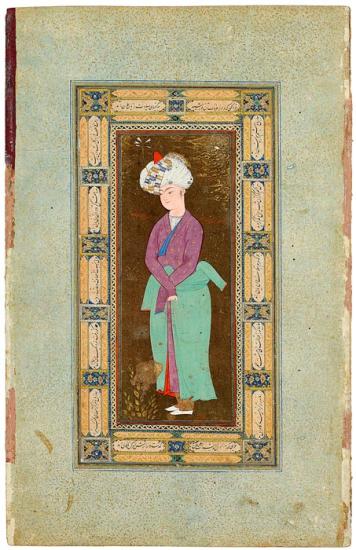
Standing Uzbek Youth
Leaf from the Read Persian Album, signed Muḥammad Mu˒min
Purchased by Pierpont Morgan, 1911
The crossed arms of the standing youth are echoed in the empty coat sleeves tied around his waist. His large turban surrounds a conical orange kulāh of Uzbek type and is crossed diagonally with a richly colored plaid scarf. The leaf is important because the inscription flanking the youth's shoulders is the basis for Ḥusain Shāmlū's ownership of the album: In the library of his successful excellency [whose] watchword is justice/ Ḥusain Khān Shāmlū the governor of Herat. Other leaves are also connected with Herat. Indeed, an inscription near the youth's feet ascribes this work to the painter Muḥammad Mu˒min, whose style derived from his teacher, Muḥammadī of Herat (fl. 1575–83).
The Read Persian Album
Pierpont Morgan's 1911 purchase of two albums (one Persian, one Mughal) from Sir Charles Hercules Read, Keeper of British and Medieval Antiquities at the British Museum, London, proved to be an important turning point in the history of the Morgan Islamic collection. Belle da Costa Greene, Morgan's librarian, accompanied by art historian and collector Bernard Berenson, first saw paintings from the albums at the great exhibition of Islamic art in Munich the previous year. She wrote to Read that they were among the finest works exhibited there and that this important school should be represented in Morgan's collection, asking him to give Morgan the right of first refusal. The Persian album was begun by Husain Khān Shāmlū, governor of Herat (r. 1598–1618), and possibly continued by his son and successor, Hasān Shāmlū (d. 1646). Fifteen of its twenty-seven sheets, once bound accordion style, are presented here. Many of the paintings were made in Herat itself.
Youth Pulling on a Falconer's Glove
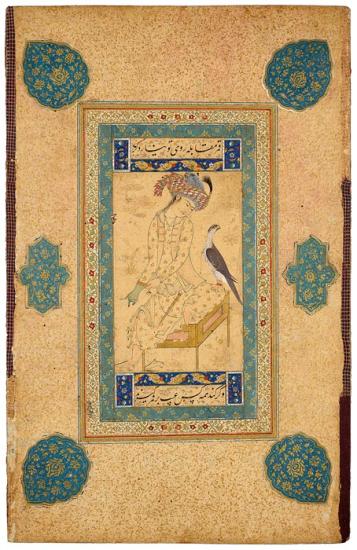
Youth Pulling on a Falconer's Glove
Leaf from the Read Persian Album
Purchased by Pierpont Morgan, 1911
Paintings of young nobleman with their falcons became especially popular during the late sixteenth century. Here a young nobleman, pulling on a leather falconer's glove, gazes at his pet falcon perched on his knee. An elaborate scarf is wrapped around his turban, and a knife hangs from his waist. The bird's red halsband is secured by a gold clasp and red leg bands with bells. This work is after Ḥabīb-Allāh al-Mashhadī, who worked at Ḥusain Shāmlū's court in Herat.
The Read Persian Album
Pierpont Morgan's 1911 purchase of two albums (one Persian, one Mughal) from Sir Charles Hercules Read, Keeper of British and Medieval Antiquities at the British Museum, London, proved to be an important turning point in the history of the Morgan Islamic collection. Belle da Costa Greene, Morgan's librarian, accompanied by art historian and collector Bernard Berenson, first saw paintings from the albums at the great exhibition of Islamic art in Munich the previous year. She wrote to Read that they were among the finest works exhibited there and that this important school should be represented in Morgan's collection, asking him to give Morgan the right of first refusal. The Persian album was begun by Husain Khān Shāmlū, governor of Herat (r. 1598–1618), and possibly continued by his son and successor, Hasān Shāmlū (d. 1646). Fifteen of its twenty-seven sheets, once bound accordion style, are presented here. Many of the paintings were made in Herat itself.
Seated Courtier with His Falcon
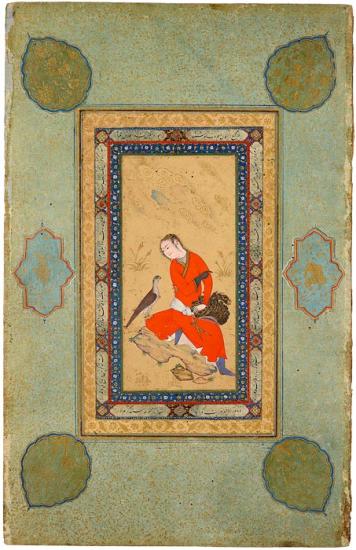
Seated Courtier with His Falcon
Leaf from the Read Persian Album, by Ḥabīb-Allāh al-Mashhadī
Purchased by Pierpont Morgan, 1911
Muslims were noted for their skill and knowledge of falconry. Frederick II, the Holy Roman Emperor (r. 1212–50) ordered Latin translations of works by the Arab falconer Moamin and the Persian Ghatrif. Here a nobleman seems to converse lovingly with his hunting falcon, which rests on his knee rather than on his gloved hand. He wears a skullcap under his turban, and two gold knives dangle from his waist. The gold and silver surfaces have been tooled. The painting is probably by Ḥabīb-Allāh al-Mashhadī (fl. 1595–1610), who worked for Ḥusain Khān Shāmlū in Qazvin and in Herat during the 1590s. He was later taken by Shah ˓Abbās to Isfahan.
The Read Persian Album
Pierpont Morgan's 1911 purchase of two albums (one Persian, one Mughal) from Sir Charles Hercules Read, Keeper of British and Medieval Antiquities at the British Museum, London, proved to be an important turning point in the history of the Morgan Islamic collection. Belle da Costa Greene, Morgan's librarian, accompanied by art historian and collector Bernard Berenson, first saw paintings from the albums at the great exhibition of Islamic art in Munich the previous year. She wrote to Read that they were among the finest works exhibited there and that this important school should be represented in Morgan's collection, asking him to give Morgan the right of first refusal. The Persian album was begun by Husain Khān Shāmlū, governor of Herat (r. 1598–1618), and possibly continued by his son and successor, Hasān Shāmlū (d. 1646). Fifteen of its twenty-seven sheets, once bound accordion style, are presented here. Many of the paintings were made in Herat itself.
Youth Flexing a Bow
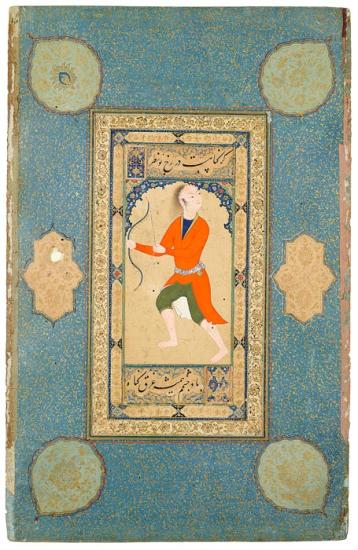
Youth Flexing a Bow
Leaf from the Read Persian Album, after Ḥabīb-Allāh al-Mashhadī.
Purchased by Pierpont Morgan, 1911
One of the exercises practiced by Persian athletes was bow flexing. Such bows, clearly not meant for hunting, were supplied with discs that produced pleasant sounds when shot. According to Sufi belief, a beautiful adolescent is seen as a mirror reflecting a ray of Allāh's beauty and was to be gazed upon. The line of accompanying poetry expands the Sufi idea of gazing at a youth (naẓar ila'l-murd): If it is a sin to gaze upon your face, Then let my eyes be ever drenched in sin. The miniature is after Ḥabīb-Allāh al-Mashhadī, a major painter at Ḥusain Shāmlū's court.
The Read Persian Album
Pierpont Morgan's 1911 purchase of two albums (one Persian, one Mughal) from Sir Charles Hercules Read, Keeper of British and Medieval Antiquities at the British Museum, London, proved to be an important turning point in the history of the Morgan Islamic collection. Belle da Costa Greene, Morgan's librarian, accompanied by art historian and collector Bernard Berenson, first saw paintings from the albums at the great exhibition of Islamic art in Munich the previous year. She wrote to Read that they were among the finest works exhibited there and that this important school should be represented in Morgan's collection, asking him to give Morgan the right of first refusal. The Persian album was begun by Husain Khān Shāmlū, governor of Herat (r. 1598–1618), and possibly continued by his son and successor, Hasān Shāmlū (d. 1646). Fifteen of its twenty-seven sheets, once bound accordion style, are presented here. Many of the paintings were made in Herat itself.
An Aristocratic Smithy
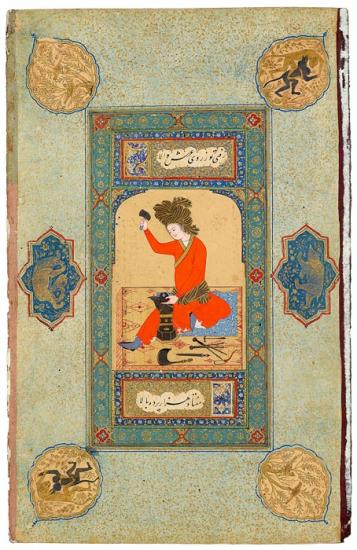
An Aristocratic Smithy
Leaf from the Read Persian, after Ḥabīb-Allāh al-Mashhadī
Purchased by Pierpont Morgan, 1911
Part of a Persian prince's education included gaining proficiency in a craft. For example, Ibrāhīm Mīrzā, the nephew of Shah Tahmāsp (r. 1524–76), excelled in carpentry and made musical instruments. Here a youth in a bright orange robe and henna-stained fingernails is making a horseshoe. This painting and three others in the Read Persian album appear to be copies of lost works by Ḥabīb-Allāh al-Mashhadī, an important painter at Governor Shāmlū's court.
The Read Persian Album
Pierpont Morgan's 1911 purchase of two albums (one Persian, one Mughal) from Sir Charles Hercules Read, Keeper of British and Medieval Antiquities at the British Museum, London, proved to be an important turning point in the history of the Morgan Islamic collection. Belle da Costa Greene, Morgan's librarian, accompanied by art historian and collector Bernard Berenson, first saw paintings from the albums at the great exhibition of Islamic art in Munich the previous year. She wrote to Read that they were among the finest works exhibited there and that this important school should be represented in Morgan's collection, asking him to give Morgan the right of first refusal. The Persian album was begun by Husain Khān Shāmlū, governor of Herat (r. 1598–1618), and possibly continued by his son and successor, Hasān Shāmlū (d. 1646). Fifteen of its twenty-seven sheets, once bound accordion style, are presented here. Many of the paintings were made in Herat itself.
An Uzbek Prisoner
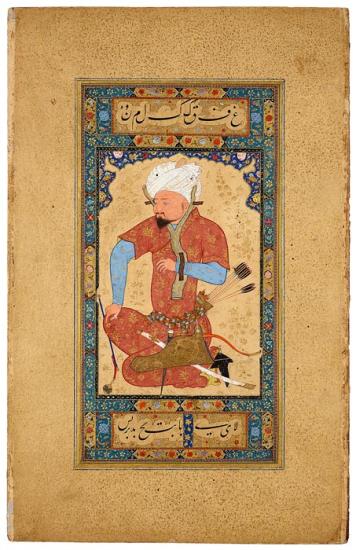
An Uzbek Prisoner
Leaf from the Read Persian Album
Purchased by Pierpont Morgan, 1911
Although the kneeling prisoner is secured by a wooden yoke, he still has his bow (in a case decorated with a simurgh, a mythical phoenix-like bird, chasing a rabbit), quiver, dagger, sword, and a red riding crop (whip). His large white turban features the typical Uzbek striated cone support with a dimpled tip. Although such representations of Uzbek prisoners date back to about 1550, they remained popular until the late sixteenth century, when Uzbek rule came to an end in Herat.
The Read Persian Album
Pierpont Morgan's 1911 purchase of two albums (one Persian, one Mughal) from Sir Charles Hercules Read, Keeper of British and Medieval Antiquities at the British Museum, London, proved to be an important turning point in the history of the Morgan Islamic collection. Belle da Costa Greene, Morgan's librarian, accompanied by art historian and collector Bernard Berenson, first saw paintings from the albums at the great exhibition of Islamic art in Munich the previous year. She wrote to Read that they were among the finest works exhibited there and that this important school should be represented in Morgan's collection, asking him to give Morgan the right of first refusal. The Persian album was begun by Husain Khān Shāmlū, governor of Herat (r. 1598–1618), and possibly continued by his son and successor, Hasān Shāmlū (d. 1646). Fifteen of its twenty-seven sheets, once bound accordion style, are presented here. Many of the paintings were made in Herat itself.
A Young Lady Reclining After a Bath
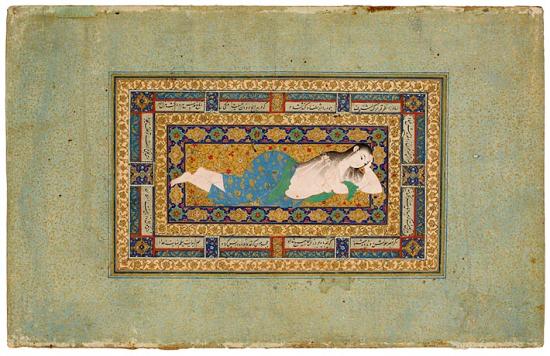
A Young Lady Reclining After a Bath
Leaf from the Read Persian Album, by Muḥammad Mu˒min
Purchased by Pierpont Morgan, 1911
There are depictions of women bathing in Islamic painting. (For example, they appear regularly in Niẓāmī's Khamsa, in which Khusrau sees Shīrīn bathing.) This painting by Muḥammad Mu˒min, however, is not part of a story: it simply depicts a woman daydreaming after her bath. Although ancient statues of Ariadne sleeping and recumbent Venuses by Venetian masters come to mind, no direct influence can be demonstrated. The subject's hips are covered by a blue cloth with rows of golden ducks, which symbolize purity and were used to decorate coverlets for marriage beds. It is doubtless that the young woman thinks only of her beloved.
The Read Persian Album
Pierpont Morgan's 1911 purchase of two albums (one Persian, one Mughal) from Sir Charles Hercules Read, Keeper of British and Medieval Antiquities at the British Museum, London, proved to be an important turning point in the history of the Morgan Islamic collection. Belle da Costa Greene, Morgan's librarian, accompanied by art historian and collector Bernard Berenson, first saw paintings from the albums at the great exhibition of Islamic art in Munich the previous year. She wrote to Read that they were among the finest works exhibited there and that this important school should be represented in Morgan's collection, asking him to give Morgan the right of first refusal. The Persian album was begun by Husain Khān Shāmlū, governor of Herat (r. 1598–1618), and possibly continued by his son and successor, Hasān Shāmlū (d. 1646). Fifteen of its twenty-seven sheets, once bound accordion style, are presented here. Many of the paintings were made in Herat itself.
A Seated Dandy in a Fur-lined Coat
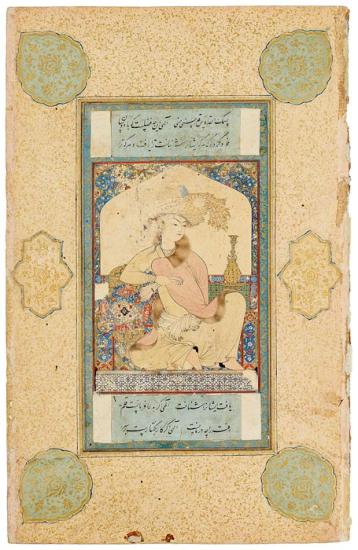
A Seated Dandy in a Fur-lined Coat
Leaf from the Read Persian Album
Purchased by Pierpont Morgan, 1911
The youth pictured here sports an enormous plaid turban, worn over a mottled blue cap. The brown fur lining of his coat is convincingly represented, as are his handkerchief and sash. His right arm is supported with a square pillow decorated with geometric designs around a star and a gold bolster. Behind him is a large golden bottle with matching tray, both studded with precious stones. Although this painting recalls similar works by the contemporaneous Riżā ˓Abbāsī, it cannot be attributed to him.
The Read Persian Album
Pierpont Morgan's 1911 purchase of two albums (one Persian, one Mughal) from Sir Charles Hercules Read, Keeper of British and Medieval Antiquities at the British Museum, London, proved to be an important turning point in the history of the Morgan Islamic collection. Belle da Costa Greene, Morgan's librarian, accompanied by art historian and collector Bernard Berenson, first saw paintings from the albums at the great exhibition of Islamic art in Munich the previous year. She wrote to Read that they were among the finest works exhibited there and that this important school should be represented in Morgan's collection, asking him to give Morgan the right of first refusal. The Persian album was begun by Husain Khān Shāmlū, governor of Herat (r. 1598–1618), and possibly continued by his son and successor, Hasān Shāmlū (d. 1646). Fifteen of its twenty-seven sheets, once bound accordion style, are presented here. Many of the paintings were made in Herat itself.
Lovers Observed by a Youth
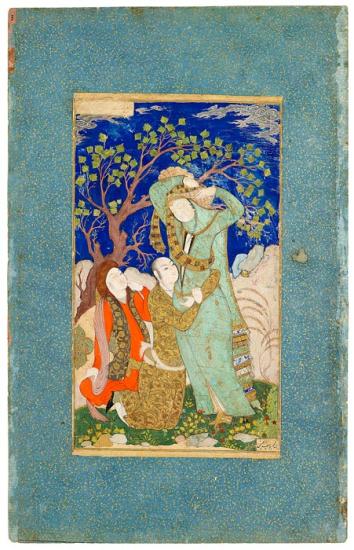
Lovers Observed by a Youth
Leaf from the Read Persian Album, by Muḥammad Yūsuf al-Ḥusainī
Several opinions have been offered regarding this enigmatic trio: has the astonished observer removed his hat because he does not approve of what he sees, or does he raise his finger to his mouth because he is next in line for the courtesan's service? The woman, however, is married, as is indicated by the triangular diadem with an oval flange that hangs over her forehead. She playfully holds her young husband's large turban above his head, its golden sash cascading over her arm and body. The observing youth may be a family member.
The artist was especially fond of depicting rich brocades. The inscription at the bottom states that it is The work of Muḥammad Yūsuf al-Ḥusainī, that at the top, in the library of Ḥasan Shāmlū, Ḥusain's son and successor as governor of Herat. Ḥasan added this work, along with others, to his father's album.
The Read Persian Album
Pierpont Morgan's 1911 purchase of two albums (one Persian, one Mughal) from Sir Charles Hercules Read, Keeper of British and Medieval Antiquities at the British Museum, London, proved to be an important turning point in the history of the Morgan Islamic collection. Belle da Costa Greene, Morgan's librarian, accompanied by art historian and collector Bernard Berenson, first saw paintings from the albums at the great exhibition of Islamic art in Munich the previous year. She wrote to Read that they were among the finest works exhibited there and that this important school should be represented in Morgan's collection, asking him to give Morgan the right of first refusal. The Persian album was begun by Husain Khān Shāmlū, governor of Herat (r. 1598–1618), and possibly continued by his son and successor, Hasān Shāmlū (d. 1646). Fifteen of its twenty-seven sheets, once bound accordion style, are presented here. Many of the paintings were made in Herat itself.
A Man Falls from His Horse
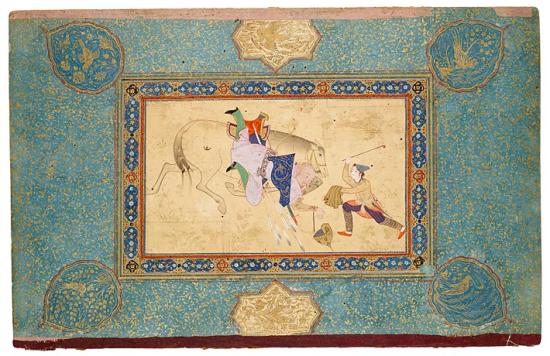
A Man Falls from His Horse
Leaf from the Read Persian Album
Purchased by Pierpont Morgan, 1911
The horse of the heavily armed warrior has stumbled, causing the rider to fall head over heels, dislodging his helmet, knives, arrows, and riding crop. But what is the explanation for the bleeding wound on the top of his head? Has he been struck by his own page? The man has central Asian features, and his horse has slit nostrils and a tail knotted in the Turkman fashion. Men are shown falling off or being pulled from horses in Firdausī's Shāhnāma; perhaps this miniature represents an enlarged detail from such a battle scene. There are some stylistic connections with other miniatures in the Read Persian album, especially those after works by Ḥabīb-Allāh.
The Read Persian Album
Pierpont Morgan's 1911 purchase of two albums (one Persian, one Mughal) from Sir Charles Hercules Read, Keeper of British and Medieval Antiquities at the British Museum, London, proved to be an important turning point in the history of the Morgan Islamic collection. Belle da Costa Greene, Morgan's librarian, accompanied by art historian and collector Bernard Berenson, first saw paintings from the albums at the great exhibition of Islamic art in Munich the previous year. She wrote to Read that they were among the finest works exhibited there and that this important school should be represented in Morgan's collection, asking him to give Morgan the right of first refusal. The Persian album was begun by Husain Khān Shāmlū, governor of Herat (r. 1598–1618), and possibly continued by his son and successor, Hasān Shāmlū (d. 1646). Fifteen of its twenty-seven sheets, once bound accordion style, are presented here. Many of the paintings were made in Herat itself.
Archer Riding an Aged Horse
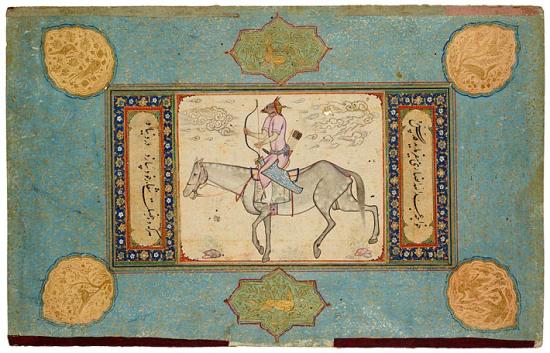
Archer Riding an Aged Horse
Leaf from the Read Persian Album, after Muḥammad Calī Ibn Malik Ḥusain
Purchased by Pierpont Morgan, 1911
The central Asian rider and the exhausted, if not lame, horse find parallels in the works of the Safavid painter Muḥammad ˓Alī Ibn Malik Ḥusain (fl. ca. 1630–60). Recently such images have been seen as a symbol of humility—the necessary suppression of a man's ego (nafs)—one of the main tasks of a Sufi on his spiritual journey. The prose text, from Anṣārī's Munājāt reads: Whoever makes the ten qualities (of the Prophet) his watchword has completed his labor in this world and the next. The leaf was added to the album by Ḥasan Shāmlū, Ḥusain's son and successor as governor of Herat.
The Read Persian Album
Pierpont Morgan's 1911 purchase of two albums (one Persian, one Mughal) from Sir Charles Hercules Read, Keeper of British and Medieval Antiquities at the British Museum, London, proved to be an important turning point in the history of the Morgan Islamic collection. Belle da Costa Greene, Morgan's librarian, accompanied by art historian and collector Bernard Berenson, first saw paintings from the albums at the great exhibition of Islamic art in Munich the previous year. She wrote to Read that they were among the finest works exhibited there and that this important school should be represented in Morgan's collection, asking him to give Morgan the right of first refusal. The Persian album was begun by Husain Khān Shāmlū, governor of Herat (r. 1598–1618), and possibly continued by his son and successor, Hasān Shāmlū (d. 1646). Fifteen of its twenty-seven sheets, once bound accordion style, are presented here. Many of the paintings were made in Herat itself.
Emaciated Horse and Rider
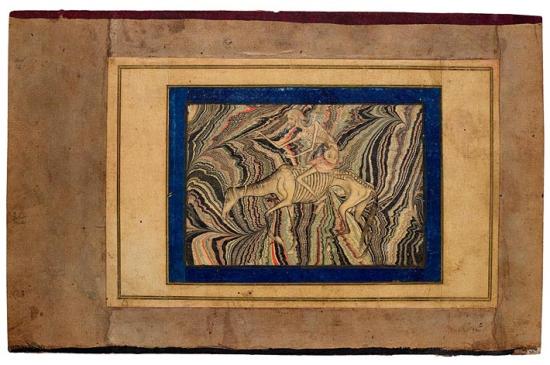
Emaciated Horse and Rider
From the Read Persian Album, first half of the seventeenth century
Purchased by Pierpont Morgan, 1911
Set against a marbled background, a nearly skeletal rider crosses his ankles to stay astride an emaciated horse with no saddle. Other marbled representations of emaciated horses are known, and the motif remained popular in Persian and Mughal painting. For some, the emaciated rider recalls Majnūn, the ill-fated lover of Lailā; while others see connections with European prints of the personification of death on a pale horse. There have also been mystical interpretations. For Rūmī, the starved horse denoted lust (nafs), which faith and reason had to reign in. In India emaciation was associated with ascetics and holy men.
The Read Persian Album
Pierpont Morgan's 1911 purchase of two albums (one Persian, one Mughal) from Sir Charles Hercules Read, Keeper of British and Medieval Antiquities at the British Museum, London, proved to be an important turning point in the history of the Morgan Islamic collection. Belle da Costa Greene, Morgan's librarian, accompanied by art historian and collector Bernard Berenson, first saw paintings from the albums at the great exhibition of Islamic art in Munich the previous year. She wrote to Read that they were among the finest works exhibited there and that this important school should be represented in Morgan's collection, asking him to give Morgan the right of first refusal. The Persian album was begun by Husain Khān Shāmlū, governor of Herat (r. 1598–1618), and possibly continued by his son and successor, Hasān Shāmlū (d. 1646). Fifteen of its twenty-seven sheets, once bound accordion style, are presented here. Many of the paintings were made in Herat itself.
Inhabited Exotic Foliage
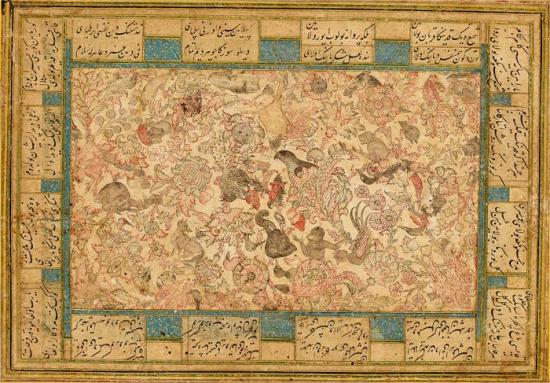
Inhabited Exotic Foliage
Leaf from the Read Persian Album, probably by Riżā Cabbāsī
Purchased by Pierpont Morgan, 1911
Saz, or "enchanted forest" drawings, inhabited with all kinds of creatures, were popular during the sixteenth and seventeenth centuries. This black and red ink drawing contains sixty-two representations—mostly heads of humans, animals, and birds, interspersed among Chinese-style blossoms and leaves. A small hand near the head of the large bird in the upper center points to the date 1625–26, while a second hand above the sitting fox points to an inscription stating that the work is one conferring a gift of Herat.
The drawing is probably by the Persian artist Riżā ˓Abbāsī, who depicted humans and animals in a similar style. The love poem in the border begins and ends with references to the garden where the beloved displays her loveliness and her face.
The Read Persian Album
Pierpont Morgan's 1911 purchase of two albums (one Persian, one Mughal) from Sir Charles Hercules Read, Keeper of British and Medieval Antiquities at the British Museum, London, proved to be an important turning point in the history of the Morgan Islamic collection. Belle da Costa Greene, Morgan's librarian, accompanied by art historian and collector Bernard Berenson, first saw paintings from the albums at the great exhibition of Islamic art in Munich the previous year. She wrote to Read that they were among the finest works exhibited there and that this important school should be represented in Morgan's collection, asking him to give Morgan the right of first refusal. The Persian album was begun by Husain Khān Shāmlū, governor of Herat (r. 1598–1618), and possibly continued by his son and successor, Hasān Shāmlū (d. 1646). Fifteen of its twenty-seven sheets, once bound accordion style, are presented here. Many of the paintings were made in Herat itself.
A Qizilbash and His Horse Entangles by a Dragon
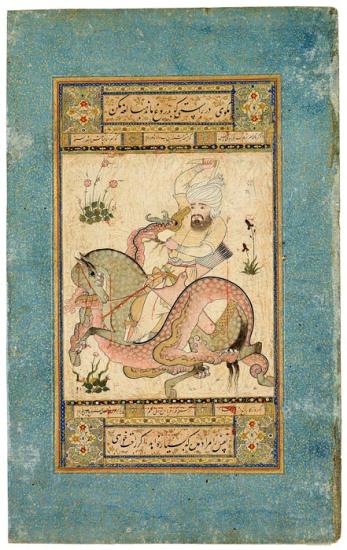
A Qizilbash and His Horse Entangles by a Dragon
Leaf from the Read Persian Album
Purchased by Pierpont Morgan, 1911
The Qizilbash were a group of Shi˓ite Islamic militant groups that flourished from the thirteenth century onward. In 1510 they supported the Timurid ruler Bābur in his war against the Uzbeks and won Samarqand for him. The turbans of the Qizilbash were supported by a high baton. Since such batons were worn in Persia only during the rule of Shah Tahmāsp (r. 1524–76), the painting has been dated to about the middle of the century. Although the hero has a sword and bow, he attacks the dragon with his small dagger. Both the marvelously intertwined horse and dragon are spotted.
The Read Persian Album
Pierpont Morgan's 1911 purchase of two albums (one Persian, one Mughal) from Sir Charles Hercules Read, Keeper of British and Medieval Antiquities at the British Museum, London, proved to be an important turning point in the history of the Morgan Islamic collection. Belle da Costa Greene, Morgan's librarian, accompanied by art historian and collector Bernard Berenson, first saw paintings from the albums at the great exhibition of Islamic art in Munich the previous year. She wrote to Read that they were among the finest works exhibited there and that this important school should be represented in Morgan's collection, asking him to give Morgan the right of first refusal. The Persian album was begun by Husain Khān Shāmlū, governor of Herat (r. 1598–1618), and possibly continued by his son and successor, Hasān Shāmlū (d. 1646). Fifteen of its twenty-seven sheets, once bound accordion style, are presented here. Many of the paintings were made in Herat itself.
Imaginary Fern

Imaginary Fern
From the Read Persian Album
Purchased by Pierpont Morgan, 1911
This apparently imaginary fern is set against a gold background filled with ink drawings of various plants and animals, including the mythical simurgh (phoenix-like bird). The border, containing twelve verses of ˓Urfī's poetry, also includes busts of youths, female-faced suns, and animals by the hand responsible for the ink drawings surrounding the fern. The mount itself is marbled paper, an innovation connected with the court of Sulṭān Ḥusain (d.1506) in Herat. The Frits Lugt Collection, Paris, has a nearly identical fern.
The Read Persian Album
Pierpont Morgan's 1911 purchase of two albums (one Persian, one Mughal) from Sir Charles Hercules Read, Keeper of British and Medieval Antiquities at the British Museum, London, proved to be an important turning point in the history of the Morgan Islamic collection. Belle da Costa Greene, Morgan's librarian, accompanied by art historian and collector Bernard Berenson, first saw paintings from the albums at the great exhibition of Islamic art in Munich the previous year. She wrote to Read that they were among the finest works exhibited there and that this important school should be represented in Morgan's collection, asking him to give Morgan the right of first refusal. The Persian album was begun by Husain Khān Shāmlū, governor of Herat (r. 1598–1618), and possibly continued by his son and successor, Hasān Shāmlū (d. 1646). Fifteen of its twenty-seven sheets, once bound accordion style, are presented here. Many of the paintings were made in Herat itself.
The Read Mughal Album
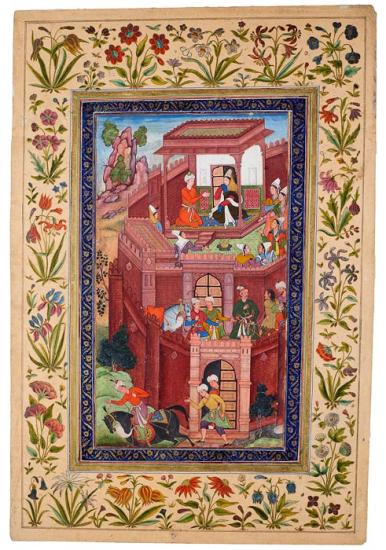
Bābur Seeks His Grandmother's Advice
Leaf from the Read Mughal Album, but formerly fol. 86 in the British Library's Bāburnāma, probably by Sānvalah
Purchasedby Pierpont Morgan, 1911
Bābur was the founder of the Mughal dynasty in India (r. 1526–1530). Although no artworks can be connected with his patronage, he completed the Bāburnāma (Memoirs of Bābur) shortly before his death. His grandson Akbar ordered a Persian translation, completed in 1589. In the 1590s, six illustrated copies were made, including the one in the British Library, London, from which this leaf comes.
According to Bābur, his grandmother, Esän Dawlat Begim, was very intelligent. In October 1494 he sought her counsel regarding the rebellious Ḥasan Ya˓qūb. They decided to depose Ya˓qūb, who, while hunting, learned of the plan and fled to Samarqand. The meeting took place in a rooftop red-stone pavilion. The miniature is probably by the artist Sānvalah (fl. 1580s–1590s).
The Read Mughal Album
Pierpont Morgan purchased the Read Mughal album, along with a Persian album, from Sir Charles Hercules Read, Keeper of British and Medieval Antiquities at the British Museum, in 1911. The Morgan purchase consisted of thirty folios (including both Indian miniatures and the Mughal portraits presented here), but Read owned at least forty-eight others, now widely dispersed. The leaves were probably once bound in several lacquered bindings. The identity of their compiler has not been established, but many borders date from the eighteenth and nineteenth centuries. The Mughal emperors of India commissioned biographies and were frequently portrayed by artists. Here the paintings are presented in the order of the emperor's reigns rather than the dates of the miniatures, starting with Bābur (r. 1526–30), the Muslim founder of the dynasty, and ending with Shāh Jahān (r. 1628–58), builder of the Taj Mahal.
Bābur and Two Companions Racing
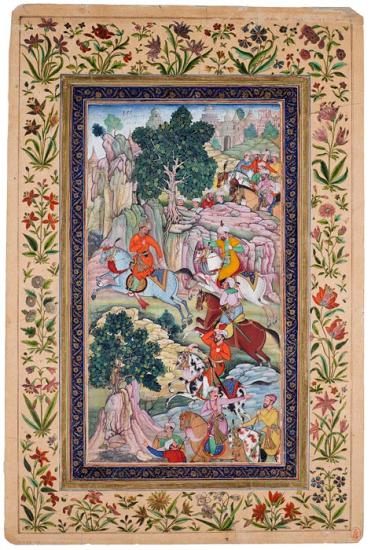
Bābur and Two Companions Racing During Their 1501-2 Flight from Samarqand
Leaf from the Read Mughal Album, but formerly fol. 121 of the British Library's Bāburnāma, probably by Sānvalah
Purchased by Pierpont Morgan, 1911
This is the second of two miniatures in the Read Mughal Album that were formerly part of the British Library's Bāburnāma (Memoirs of Bābur). According to Bābur, when he looked back to see how far Qambar-˓Alī and Qasim Beg were behind him, his girth strap snapped, causing him to fall on his head. "Although I stood up immediately and got back on," he wrote, "my brain did not return to normal until that evening." This miniature is probably by the artist Parasa, to whom four others in the British Library's manuscript have been attributed.
The Read Mughal Album
Pierpont Morgan purchased the Read Mughal album, along with a Persian album, from Sir Charles Hercules Read, Keeper of British and Medieval Antiquities at the British Museum, in 1911. The Morgan purchase consisted of thirty folios (including both Indian miniatures and the Mughal portraits presented here), but Read owned at least forty-eight others, now widely dispersed. The leaves were probably once bound in several lacquered bindings. The identity of their compiler has not been established, but many borders date from the eighteenth and nineteenth centuries. The Mughal emperors of India commissioned biographies and were frequently portrayed by artists. Here the paintings are presented in the order of the emperor's reigns rather than the dates of the miniatures, starting with Bābur (r. 1526–30), the Muslim founder of the dynasty, and ending with Shāh Jahān (r. 1628–58), builder of the Taj Mahal.
The Young Akbar
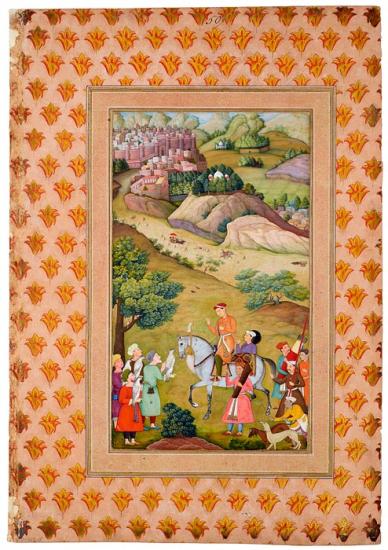
The Young Akbar with a Hunting Party
Leaf from the Read Mughal Album, probably by Manohar
Purchased by Pierpont Morgan, 1911
In 1589 the Mughal Emperor Akbar (r. 1556–1605) commissioned Abū al-Fażl to begin an account of his life. The result—the three-volume Akbarnāma, completed some seven years later—exists in at least three copies. This leaf was once part of the manuscript in the Chester Beatty Library, Dublin, which has paintings covering the period from the 1556 accession of the thirteen-year-old Akbar to the throne to 1579. According to Abū al-Fażl, Akbar's beard appeared when he was twenty-one, so the episode shown here probably occurred when, at age seventeen or eighteen, he left the army and headed to Lahore, hunting along the way. Akbar greets four men with falcons and is attended by men bearing a fan, sword, spear, quiver of arrows, and what appears to be a bow. A dog handler with two salukis occupies the lower right corner.
The Read Mughal Album
Pierpont Morgan purchased the Read Mughal album, along with a Persian album, from Sir Charles Hercules Read, Keeper of British and Medieval Antiquities at the British Museum, in 1911. The Morgan purchase consisted of thirty folios (including both Indian miniatures and the Mughal portraits presented here), but Read owned at least forty-eight others, now widely dispersed. The leaves were probably once bound in several lacquered bindings. The identity of their compiler has not been established, but many borders date from the eighteenth and nineteenth centuries. The Mughal emperors of India commissioned biographies and were frequently portrayed by artists. Here the paintings are presented in the order of the emperor's reigns rather than the dates of the miniatures, starting with Bābur (r. 1526–30), the Muslim founder of the dynasty, and ending with Shāh Jahān (r. 1628–58), builder of the Taj Mahal.
Prince Salīm at an Audience Window
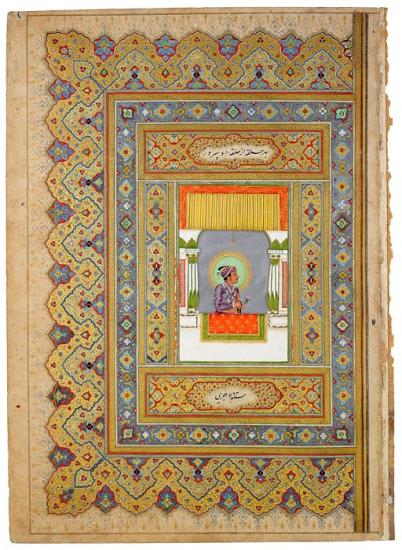
Prince Salīm at an Audience Window
Leaf from the Read Mughal Album
Purchased by Pierpont Morgan, 1911
This portrait of the Mughal emperor Salīm, who took the name Jahāngir (World-Seizer) when he ascended the throne (r. 1605–27), originally faced that of his father, Emperor Akbar (r. 1556–1605), shown on the right, when it was mounted in the album (see MS M.458.24). The rhyming couplet in the cartouche above Salīm, which ends with a date (1749–50), continues the one below Akbar. Both men have haloes, are shown at audience windows (jharokas), and were painted by the same artist. The portraits are applied to a type of elaborate border used for the opening pages of a manuscript (sarlauḥ). Indeed, as the leaf is numbered 1, these facing pages originally formed the opening of the Read Mughal album.
The Read Mughal Album
Pierpont Morgan purchased the Read Mughal album, along with a Persian album, from Sir Charles Hercules Read, Keeper of British and Medieval Antiquities at the British Museum, in 1911. The Morgan purchase consisted of thirty folios (including both Indian miniatures and the Mughal portraits presented here), but Read owned at least forty-eight others, now widely dispersed. The leaves were probably once bound in several lacquered bindings. The identity of their compiler has not been established, but many borders date from the eighteenth and nineteenth centuries. The Mughal emperors of India commissioned biographies and were frequently portrayed by artists. Here the paintings are presented in the order of the emperor's reigns rather than the dates of the miniatures, starting with Bābur (r. 1526–30), the Muslim founder of the dynasty, and ending with Shāh Jahān (r. 1628–58), builder of the Taj Mahal.
Akbar at an Audience Window
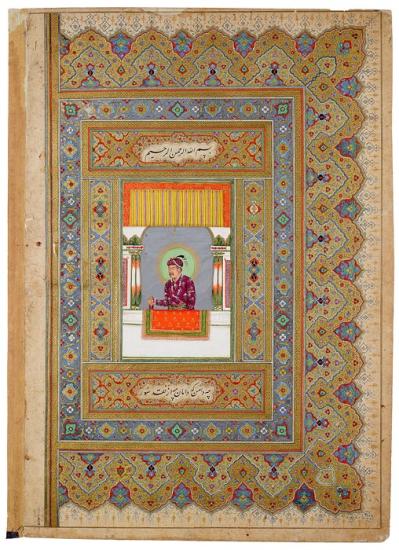
Akbar at an Audience Window
Leaf from the Read Mughal Album
Purchased by Pierpont Morgan, 1911
Akbar (r. 1556–1605) was one of the wisest and most important of the Mughal rulers. Although he preferred hunting to reading (he was illiterate) he sought out the learned. He employed over a hundred painters, and said he disliked men who hated painting. When it was mounted in the Read Mughal album, this portrait originally faced that of his son Salīm (see MS M.458.12), who was impatient to succeed him, even though his two brothers died early of alcoholism.
Below Akbar: In the name of God, the Merciful, the Compassionate / What skirt? It is a lap full of cash.
Above Salīm: In every ring, [of servitude] to him is happiness. / The year A.H. 1163 [A.D. 1749–50]
The Read Mughal Album
Pierpont Morgan purchased the Read Mughal album, along with a Persian album, from Sir Charles Hercules Read, Keeper of British and Medieval Antiquities at the British Museum, in 1911. The Morgan purchase consisted of thirty folios (including both Indian miniatures and the Mughal portraits presented here), but Read owned at least forty-eight others, now widely dispersed. The leaves were probably once bound in several lacquered bindings. The identity of their compiler has not been established, but many borders date from the eighteenth and nineteenth centuries. The Mughal emperors of India commissioned biographies and were frequently portrayed by artists. Here the paintings are presented in the order of the emperor's reigns rather than the dates of the miniatures, starting with Bābur (r. 1526–30), the Muslim founder of the dynasty, and ending with Shāh Jahān (r. 1628–58), builder of the Taj Mahal.
Hakīm Mu˒mina
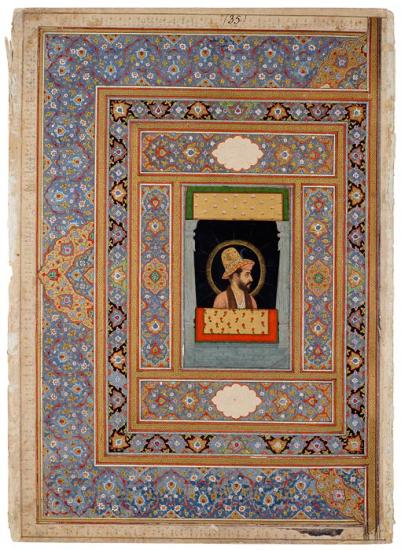
Bust Portrait of Hakīm Mu˒mina
Leaf from the Read Mughal Album
Purchased by Pierpont Morgan, 1911
Although such small portraits ended up in albums, they probably served as artist's models for larger works. Although the portrait head is a Mughal work of about 1620, it became part of the Read Mughal album in the second half of the eighteenth century, when the portrait was extended to become a bust, and the black background, halo, and elaborate borders were added. Mu˒mina, who served as the Mughal emperor Jahāngīr's physician, is shown at a jharoka (audience window). His European-style hat—popular in India—is embroidered with a lion battling a dragon. The page is numbered 35.
The Read Mughal Album
Pierpont Morgan purchased the Read Mughal album, along with a Persian album, from Sir Charles Hercules Read, Keeper of British and Medieval Antiquities at the British Museum, in 1911. The Morgan purchase consisted of thirty folios (including both Indian miniatures and the Mughal portraits presented here), but Read owned at least forty-eight others, now widely dispersed. The leaves were probably once bound in several lacquered bindings. The identity of their compiler has not been established, but many borders date from the eighteenth and nineteenth centuries. The Mughal emperors of India commissioned biographies and were frequently portrayed by artists. Here the paintings are presented in the order of the emperor's reigns rather than the dates of the miniatures, starting with Bābur (r. 1526–30), the Muslim founder of the dynasty, and ending with Shāh Jahān (r. 1628–58), builder of the Taj Mahal.
Young Dārā Shikoh
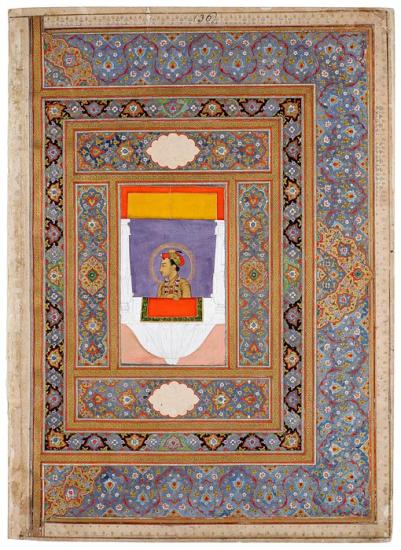
Bust Portrait of the Young Dārā Shikoh
Leaf from the Read Mughal Album, probably by Hāshim
Purchased by Pierpont Morgan, 1911
Dārā Shikoh, the eldest son of the Mughal emperor Shāh Jahān, was born in 1615. Since here he appears to be in his late teens, this portrait was probably painted in the early 1630s. The extremely fine facial depiction has been attributed to the painter Hāshim, but the background, marble window frame, halo, and elaborate border were added during the second half of the eighteenth century, when the album was assembled. The page, numbered 36, originally faced the portrait of Hakīm Mu˒mina (see MS M.458.5) in the Read Mughal album. The numeration, however, is in Western style, going from front to back.
The Read Mughal Album
Pierpont Morgan purchased the Read Mughal album, along with a Persian album, from Sir Charles Hercules Read, Keeper of British and Medieval Antiquities at the British Museum, in 1911. The Morgan purchase consisted of thirty folios (including both Indian miniatures and the Mughal portraits presented here), but Read owned at least forty-eight others, now widely dispersed. The leaves were probably once bound in several lacquered bindings. The identity of their compiler has not been established, but many borders date from the eighteenth and nineteenth centuries. The Mughal emperors of India commissioned biographies and were frequently portrayed by artists. Here the paintings are presented in the order of the emperor's reigns rather than the dates of the miniatures, starting with Bābur (r. 1526–30), the Muslim founder of the dynasty, and ending with Shāh Jahān (r. 1628–58), builder of the Taj Mahal.
Prince Dārā Shikoh
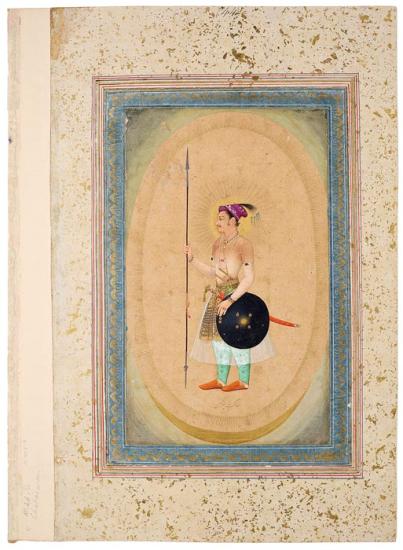
Prince Dārā Shikoh
Leaf from the Read Mughal Album, by Chitarman
Purchased by Pierpont Morgan, 1911
Dārā Shikoh (1615–1659) shared with his father, the Mughal emperor Shāh Jahān, an interest in calligraphy and art, becoming a great patron himself. His brother Aurangzeb had him killed in 1659, appropriated his art collection, and usurped Jahān's throne. Since the portrait is dated 1639–40, Dārā Shikoh was about twenty-four years old. He is shown fully armed, with the cosmic symbols of Mughal kingship; the sun (mandorla and halo) and moon beneath his feet. The artist's signature, He, who is dust under his feet, Chitarman, is written in gold beneath the shoes of his patron. Chitarman (active 1628–ca.1670) signed at least three other portraits of Dārā Shikoh, whose atelier he entered early in his career.
The Read Mughal Album
Pierpont Morgan purchased the Read Mughal album, along with a Persian album, from Sir Charles Hercules Read, Keeper of British and Medieval Antiquities at the British Museum, in 1911. The Morgan purchase consisted of thirty folios (including both Indian miniatures and the Mughal portraits presented here), but Read owned at least forty-eight others, now widely dispersed. The leaves were probably once bound in several lacquered bindings. The identity of their compiler has not been established, but many borders date from the eighteenth and nineteenth centuries. The Mughal emperors of India commissioned biographies and were frequently portrayed by artists. Here the paintings are presented in the order of the emperor's reigns rather than the dates of the miniatures, starting with Bābur (r. 1526–30), the Muslim founder of the dynasty, and ending with Shāh Jahān (r. 1628–58), builder of the Taj Mahal.
Khiżr Presents a Globe to Shāh Jahān
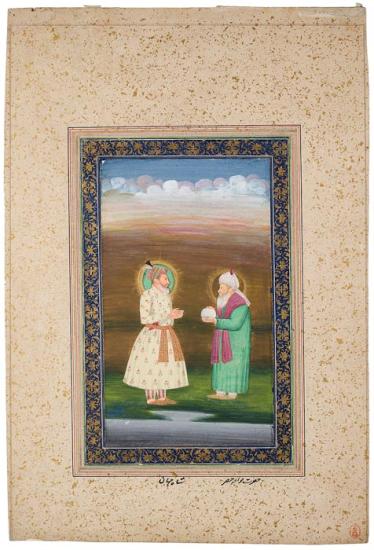
Khiżr Presents a Globe to Shāh Jahān
Leaf from the Read Mughal Album
Purchased by Pierpont Morgan, 1911
On a 6 November 1654 trip to Ajmer, the Mughal emperor Shāh Jahān had a vision of the prophet Khiżr as he approached the city walls. Khiżr, who set off with Iskandar (Alexander the Great) to search for the water of eternal life, was regarded as the spiritual founder of the Chishtī order of Sufis centered at Ajmer. A seventeenth-century miniature in St. Petersburg shows Khiżr presenting a globe upon which a glass of water rests. The globe suggests peaceful dominion, and the water may refer to eternal life. In this miniature, however, a body of water in the foreground replaces the glass. Khiżr wears his customary green (his name means "the green one"). Both men have haloes and are identified by inscriptions.
The Read Mughal Album
Pierpont Morgan purchased the Read Mughal album, along with a Persian album, from Sir Charles Hercules Read, Keeper of British and Medieval Antiquities at the British Museum, in 1911. The Morgan purchase consisted of thirty folios (including both Indian miniatures and the Mughal portraits presented here), but Read owned at least forty-eight others, now widely dispersed. The leaves were probably once bound in several lacquered bindings. The identity of their compiler has not been established, but many borders date from the eighteenth and nineteenth centuries. The Mughal emperors of India commissioned biographies and were frequently portrayed by artists. Here the paintings are presented in the order of the emperor's reigns rather than the dates of the miniatures, starting with Bābur (r. 1526–30), the Muslim founder of the dynasty, and ending with Shāh Jahān (r. 1628–58), builder of the Taj Mahal.
Bahādur Shāh
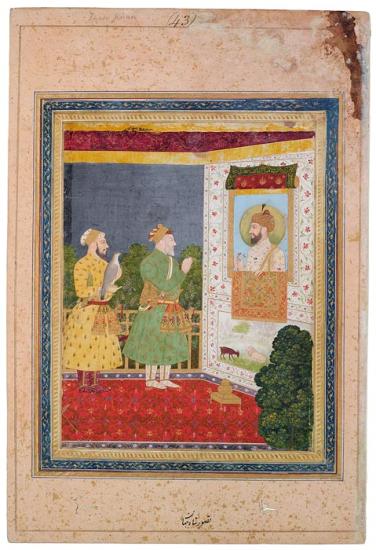
Bahādur Shāh Pays Homage to His Ancestors
Leaf from the Read Mughal Album
Purchased by Pierpont Morgan, 1911
The Mughal rulers adopted the Hindu custom of appearing to their subjects in a special audience window called the jharoka. In this rare version of the theme, however, it is not the reigning monarch who appears in the window but his ancestor. In a similar miniature in the Victoria and Albert Museum, London, the man before the window is identified as Bahādur Shāh (r. 1707–12), son and successor of Aurangzeb (r. 1658–1707), likely the figure depicted in the window. The dynastic link goes even further back, as the latter's turban is of central Asian origin and thus associated with his primogenitor, Bābur, founder of the dynasty. The goat and reclining lion depicted below the window suggest a reign of peace and justice as well as the enduring majesty of Mughal rule from Bābur to Bahādur Shāh.
The Read Mughal Album
Pierpont Morgan purchased the Read Mughal album, along with a Persian album, from Sir Charles Hercules Read, Keeper of British and Medieval Antiquities at the British Museum, in 1911. The Morgan purchase consisted of thirty folios (including both Indian miniatures and the Mughal portraits presented here), but Read owned at least forty-eight others, now widely dispersed. The leaves were probably once bound in several lacquered bindings. The identity of their compiler has not been established, but many borders date from the eighteenth and nineteenth centuries. The Mughal emperors of India commissioned biographies and were frequently portrayed by artists. Here the paintings are presented in the order of the emperor's reigns rather than the dates of the miniatures, starting with Bābur (r. 1526–30), the Muslim founder of the dynasty, and ending with Shāh Jahān (r. 1628–58), builder of the Taj Mahal.
Ibrāhīm Ibn Adham of Balkh
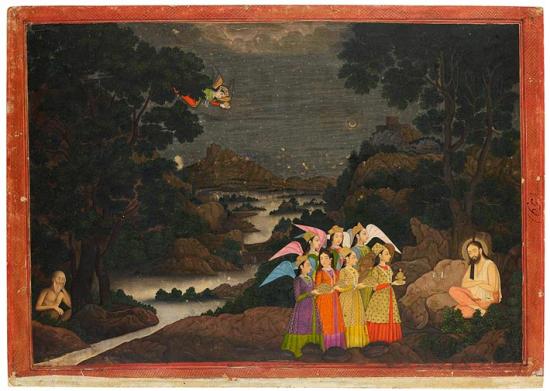
Ibrāhīm Ibn Adham of Balkh Served by Angels
From the Read Mughal Album, attributed to Mīr Kalān Khān
Purchased by Pierpont Morgan, 1911
After a spiritual awakening, Ibrāhīm Ibn Adham (d. 798), an eighth-century ruler of Balkh, renounced his kingdom and wealth to become a wandering dervish. Part of his spiritual awakening happened one night when he heard people on the roof of his palace. When he made inquiry, a man told him they were looking for a lost camel. Ibrāhīm then replied it was ridiculous to expect that the camel would be on the roof of his palace. The man then said it was equally crazy to expect to find Allah in the lap of luxury. Ibrāhīm then realized that his hope of finding Allah in his present surroundings was as futile as searching for a camel on his roof.
Rūmī (1207–1273), a later Sufi mystic, also born in Balkh, recounted Ibrāhīm's story in his six-volume poetic work, the Masnavī. Legend has it that Khiżr, the immortal guide of the Sufi, played a role and that Ibrāhīm, regarded as a spiritual ancestor of the Chrishtī Sufi order, was fed by angels. Here the haloed Sufi shaikh (spiritual master) sits at the right, with eyes closed and supported by a staff. Seven angels have already arrived, and an eighth is en route. A pensive man, at the far left, echoes the figure of Ibrāhīm.
The subject may have been inspired by engravings of Christ fed by angels in the wilderness. The painting is probably by Mīr Kalān Khān, who was active in Oudh and Delhi during the 1760s.
The Read Mughal Album
Pierpont Morgan purchased the Read Mughal album, along with a Persian album, from Sir Charles Hercules Read, Keeper of British and Medieval Antiquities at the British Museum, in 1911. The Morgan purchase consisted of thirty folios (including both Indian miniatures and the Mughal portraits presented here), but Read owned at least forty-eight others, now widely dispersed. The leaves were probably once bound in several lacquered bindings. The identity of their compiler has not been established, but many borders date from the eighteenth and nineteenth centuries. The Mughal emperors of India commissioned biographies and were frequently portrayed by artists. Here the paintings are presented in the order of the emperor's reigns rather than the dates of the miniatures, starting with Bābur (r. 1526–30), the Muslim founder of the dynasty, and ending with Shāh Jahān (r. 1628–58), builder of the Taj Mahal.
Peri Riding a Composite Horse
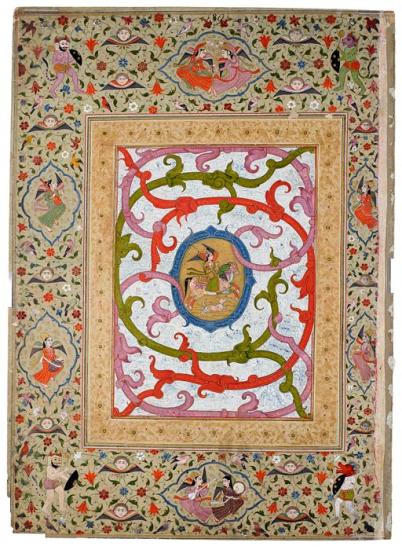
Peri Riding a Composite Horse
From the Read Mughal Album
Purchased by Pierpont Morgan, 1911
Composite drawing, or symplegma (intertwined), is documented in Islamic painting in Persia and Mughal India as early as the sixteenth century. Here, within an oval surrounded by acanthus scrolls, a peri (a supernatural being thought to have descended from a fallen angel) rides a horse made up of many smaller intertwined animals. The horse's tail, for instance, is actually a woman's flowing black hair. Between the vines are tiny blue drawings of animals—many in pairs—cherubs, men fighting monsters or served by angels, and Rustam killing a div (demon). This and the facing page (MS M.458.15 in the Read Mughal album) were made possibly in Kashmir during the second half of the eighteenth century.
The Read Mughal Album
Pierpont Morgan purchased the Read Mughal album, along with a Persian album, from Sir Charles Hercules Read, Keeper of British and Medieval Antiquities at the British Museum, in 1911. The Morgan purchase consisted of thirty folios (including both Indian miniatures and the Mughal portraits presented here), but Read owned at least forty-eight others, now widely dispersed. The leaves were probably once bound in several lacquered bindings. The identity of their compiler has not been established, but many borders date from the eighteenth and nineteenth centuries. The Mughal emperors of India commissioned biographies and were frequently portrayed by artists. Here the paintings are presented in the order of the emperor's reigns rather than the dates of the miniatures, starting with Bābur (r. 1526–30), the Muslim founder of the dynasty, and ending with Shāh Jahān (r. 1628–58), builder of the Taj Mahal.
Three Peris Riding a Composite Elephant
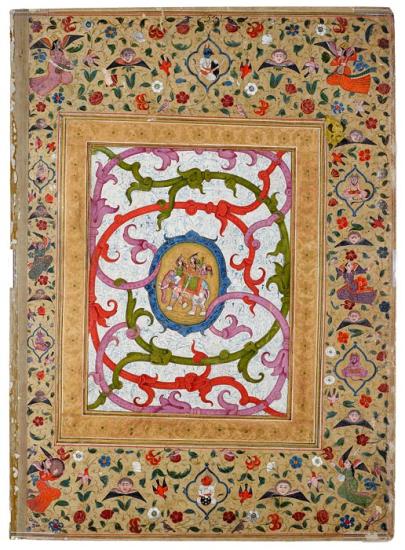
Three Peris Riding a Composite Elephant
From the Read Mughal Album
Purchased by Pierpont Morgan, 1911
Originally this page must have faced the miniature Peri riding the composite horse (see MS M.458.14 in the Read Mughal album), though they were later numbered 52 and 39. The composition of the elephant—especially the rabbit feet—is remarkable. Here, too, some of the tiny blue drawings can be identified, such as Lailā and Majnūn with animals, a hero borne by divs (demons), and Ibrāhīm Ibn Adham of Balkh (an eighth-century ruler) served by angels, the subject of another page in the album (see MS M.458.32). The matching borders contain an assortment of angels, some making music, along with birds, flowers, and armed horned demons.
The Read Mughal Album
Pierpont Morgan purchased the Read Mughal album, along with a Persian album, from Sir Charles Hercules Read, Keeper of British and Medieval Antiquities at the British Museum, in 1911. The Morgan purchase consisted of thirty folios (including both Indian miniatures and the Mughal portraits presented here), but Read owned at least forty-eight others, now widely dispersed. The leaves were probably once bound in several lacquered bindings. The identity of their compiler has not been established, but many borders date from the eighteenth and nineteenth centuries. The Mughal emperors of India commissioned biographies and were frequently portrayed by artists. Here the paintings are presented in the order of the emperor's reigns rather than the dates of the miniatures, starting with Bābur (r. 1526–30), the Muslim founder of the dynasty, and ending with Shāh Jahān (r. 1628–58), builder of the Taj Mahal.
A Sun-bearing Peri Rides a Composite Lion
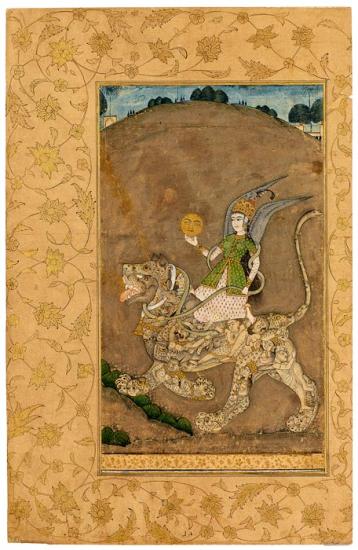
A Sun-bearing Peri Rides a Composite Lion
Purchased in 1935
Astrology was an important part of Islamic culture; this miniature actually represents Sol in Leo, the conjunction of the sun with the constellation Leo. What is unusual, however, is that the lion is a composite drawing, or symplegma, made up of many intertwined animals, human beings, and monsters. Sol in Leo also appears in MS M.788, an astrological treatise purchased with the leaf, but in that image the lion is not composite.
Sol in Leo.
Persian poetry
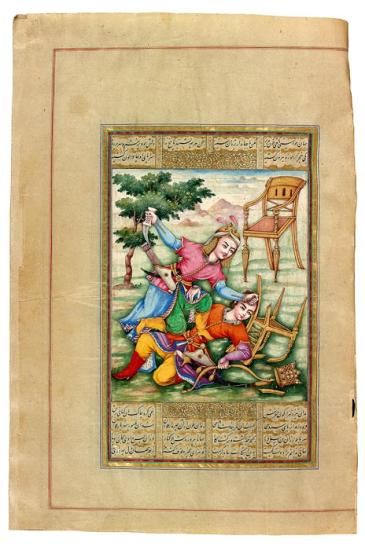
Tur Murders Iraj, His Brother
Shāhnāma (Book of Kings), in Persian
Written between 1852 and 1856 by Calī Ibn al-Ḥusain al-Kātib al-Shīrāzī, with miniatures by Luṭf Calī Khān al-Shīrāzī.
The Dannie and Hettie Heineman Collection, gift of the Heineman Foundation, 1977
This miniature appears in a nineteenth-century manuscript of Firdausī's Shāhnāma (Book of Kings), the Persian national epic. Firdausī wrote the epic—in some 50,000 couplets—between 980 and 1010. He tells the story of the mythical Persian king Feraydun, who had three sons, Salm, Tur, and Iraj. He divided the world into three parts, prudently giving Persia and the lands of the Arabs to Iraj, his youngest and wisest son. Tur and Salm were displeased that Iraj should have received the crown, sword, seal, and ivory throne of Persia and plotted against him. Iraj visited them, willing to hand over the crown, but the enraged Tur broke his throne over Iraj's head, pulled a dagger from his boot and killed him. Iraj's head was sent to the king. Years later his death was avenged by his grandson Manuchehr.
Persian poetry
The Persians loved their poetry and their poets, though the Qur˒an warned against believing their words (sura 69.41) and "those straying in evil who follow them" (sura 26.224). While Arabic was the first language of Islam and the language of the Qur˒an, Persian was favored by poets. Even Firdausī's (940–1020) celebrated Shāhnāma (Book of Kings), the national epic of Persian, was written in verse—some 50,000 couplets! Rūmī (1207–1273), the best known of the Sufi poets, put poetry in perspective when he wrote, "A hundred thousand books of poetry existed / Before the word of the illiterate [Prophet] they were put to shame!" (Masnavī I, 529). Presented here are illustrations of Firdausī's Shāhnāma as well as works by Sa˓ dī (ca.1184–1292), Hāfiz (ca. 1320–1389), and Jāmī (1414–1492), regarded as the last of the great Sufi poets. Also featured are illustrations from each of the five poems of the Khamsa (Quintet), by Niẓāmī (ca. 1141–1209), especially Lailā and Majnūn (The Persian Romeo and Juliet) and Bahrām Gūr's Seven Princesses.
King Shaput Zu˒l Aktaf
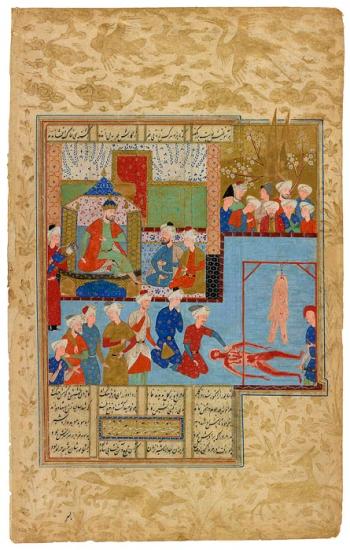
King Shaput Zu˒l Aktaf Observes Mani's Flayed Body
Shāhnāma (Book of Kings), in Persian
Promised gift of William M. Voelkle.; voelkle leaf
This miniature appears in a sixteenth-century manuscript of Firdausī's Shāhnāma (Book of Kings), the Persian national epic, written between 980 and 1010. He tells the story of Mani (ca. 216–276), a painter and prophet from China, who sought an audience with the king, Shapur, to seek his support as a prophet of a new religion. Shapur had doubts about his creed, however, and Mani was unable to address Shapur's remarks concerning the faith of Zoroaster. The enraged king had Mani flayed and his skin stuffed with straw so that no one would be tempted to follow his teachings. Representations of the subject are extremely rare. Mani was the founder of Manichaeanism, but he actually died in prison during the reign of Bahrām I, Shapur's second successor.
Persian poetry
The Persians loved their poetry and their poets, though the Qur˒an warned against believing their words (sura 69.41) and "those straying in evil who follow them" (sura 26.224). While Arabic was the first language of Islam and the language of the Qur˒an, Persian was favored by poets. Even Firdausī's (940–1020) celebrated Shāhnāma (Book of Kings), the national epic of Persian, was written in verse—some 50,000 couplets! Rūmī (1207–1273), the best known of the Sufi poets, put poetry in perspective when he wrote, "A hundred thousand books of poetry existed / Before the word of the illiterate [Prophet] they were put to shame!" (Masnavī I, 529). Presented here are illustrations of Firdausī's Shāhnāma as well as works by Sa˓ dī (ca.1184–1292), Hāfiz (ca. 1320–1389), and Jāmī (1414–1492), regarded as the last of the great Sufi poets. Also featured are illustrations from each of the five poems of the Khamsa (Quintet), by Niẓāmī (ca. 1141–1209), especially Lailā and Majnūn (The Persian Romeo and Juliet) and Bahrām Gūr's Seven Princesses.
Iskandar and Dārā
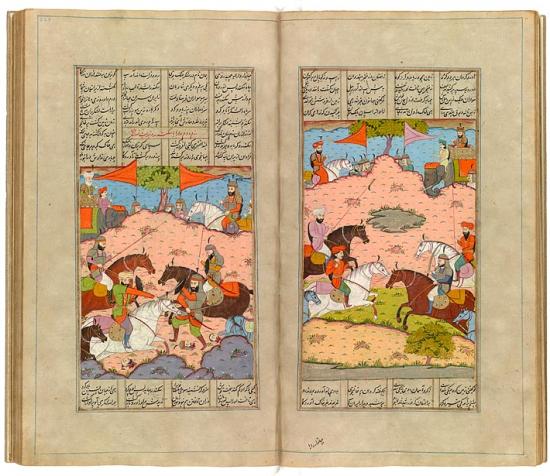
The Armies of Iskandar and Dārā Battle
Shāhnāma (Book of Kings), in Persian
Purchased by Pierpont Morgan, 1909
Iskandar (Alexander the Great) was regarded as a great hero; his stories appear in several works, such as Firdausī's Shāhnāma (Book of Kings), the Persian national epic, and Niẓāmī's Khamsa. Firdausī wrote the epic—in some 50,000 couplets—between 980 and 1010. Shown here are the first two battles between the armies of Iskandar and Dārā (Darius), those at Issus (333 B.C.) and Gaugamela (331 B.C.) Both were won by Iskandar. Lahore flourished under the Mughals, but when this manuscript was made it was the capital city of the Sikhs, who were much indebted to Mughal culture.
Persian poetry
The Persians loved their poetry and their poets, though the Qur˒an warned against believing their words (sura 69.41) and "those straying in evil who follow them" (sura 26.224). While Arabic was the first language of Islam and the language of the Qur˒an, Persian was favored by poets. Even Firdausī's (940–1020) celebrated Shāhnāma (Book of Kings), the national epic of Persian, was written in verse—some 50,000 couplets! Rūmī (1207–1273), the best known of the Sufi poets, put poetry in perspective when he wrote, "A hundred thousand books of poetry existed / Before the word of the illiterate [Prophet] they were put to shame!" (Masnavī I, 529). Presented here are illustrations of Firdausī's Shāhnāma as well as works by Sa˓ dī (ca.1184–1292), Hāfiz (ca. 1320–1389), and Jāmī (1414–1492), regarded as the last of the great Sufi poets. Also featured are illustrations from each of the five poems of the Khamsa (Quintet), by Niẓāmī (ca. 1141–1209), especially Lailā and Majnūn (The Persian Romeo and Juliet) and Bahrām Gūr's Seven Princesses.
Bones Before Iskandar
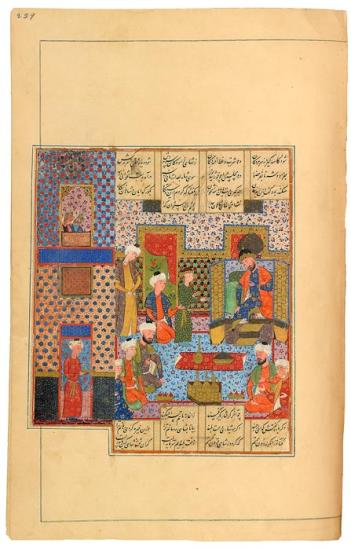
A Young Prince Holds His Father's Bones Before Iskandar
Haft aurang (Seven Thrones), in Persian, written by Ḥasan al-Ḥusainī
Purchased by Pierpont Morgan, 1911
The poet Jāmī's Haft aurang consists of seven romantic and didactic masnavīs (narrative poems in rhyming couplets), the last treating stories about the wisdom of Iskandar (Alexander the Great). Here Iskandar converses with a young prince whose region he recently conquered. The youth, the only surviving member of his royal family, shows Iskandar the bones of his father, the dead king, He hopes to demonstrate that the bones look no different than those of commoners and that conflict among men is senseless. Jāmī was one of the last great Sufi scholars and poets. The term Haft aurang also refers to the seven stars comprised by the Big Dipper (Ursa Major).
Persian poetry
The Persians loved their poetry and their poets, though the Qur˒an warned against believing their words (sura 69.41) and "those straying in evil who follow them" (sura 26.224). While Arabic was the first language of Islam and the language of the Qur˒an, Persian was favored by poets. Even Firdausī's (940–1020) celebrated Shāhnāma (Book of Kings), the national epic of Persian, was written in verse—some 50,000 couplets! Rūmī (1207–1273), the best known of the Sufi poets, put poetry in perspective when he wrote, "A hundred thousand books of poetry existed / Before the word of the illiterate [Prophet] they were put to shame!" (Masnavī I, 529). Presented here are illustrations of Firdausī's Shāhnāma as well as works by Sa˓ dī (ca.1184–1292), Hāfiz (ca. 1320–1389), and Jāmī (1414–1492), regarded as the last of the great Sufi poets. Also featured are illustrations from each of the five poems of the Khamsa (Quintet), by Niẓāmī (ca. 1141–1209), especially Lailā and Majnūn (The Persian Romeo and Juliet) and Bahrām Gūr's Seven Princesses.
Maḥmūd of Ghanzi
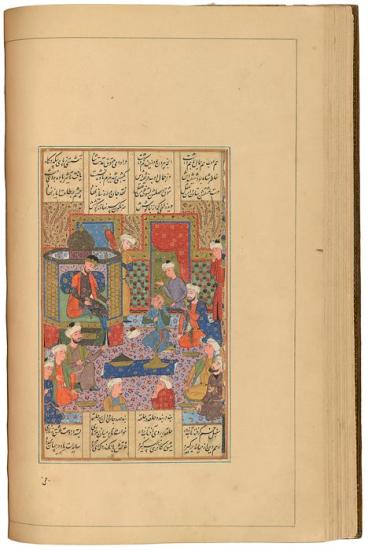
Maḥmūd of Ghanzi Orders His Favorite Page, Ayāz, to Cut off Half of His Beautiful Curly Locks
Haft aurang (Seven Thrones), in Persian, written by Ḥasan al-Ḥusainī
Purchased by Pierpont Morgan, 1911
Maḥmūd of Ghazni (r. 997–1030) was the greatest ruler of the Ghaznavid dynasty, controlling Iran, Afghanistan, Pakistan, and northwest India. He was the first to bear the title Sultan (authority), was a patron of the arts and of poetry, and commissioned Firdausī to write his famous Shāhnāma, the Persian national epic. But he became even more celebrated, by such poets as Jāmī and Sa˓dī, because of his love for Malik Ayāz, his young male slave. When the king asked him if he knew of a greater and more powerful king, he said yes, explaining that even though Maḥmūd was king, he was ruled by his heart, and that Ayāz was the king of his heart. Thus, the power of Maḥmūd's love made him a slave to his slave.
Jāmī's Haft aurang (Seven Thrones or Constellations of the Great Bear), was written from 1468 to 1485, and consists of seven poems in masnavī form (rhyming couplets); some are allegorical, others are didactic. In his discourse on beauty he tells the story of Maḥmūd and his love for Ayāz, who had many good points, but was not remarkably handsome. One night, under the influence of wine and Ayāz's beautiful curls, love and desire began to stir in him, and he feared that he might verge from the Path of Law and the Way of Chivalry. He then gave Ayāz his knife, ordering him to cut off half the length of his curls, which he did. His ready obedience provided a new rush of love, causing him to bestow upon Ayāz even more gold and jewels, after which Maḥmūd fell into a drunken sleep. In the morning, realizing what he had done, called for Ayāz and saw the clipped tresses. He was somewhat cheered by the poet Unsuri's quatrain.
Though shame it be a fair one's curls to shear,
Why rise in wrath or sit in sorrow here?
Rather rejoice, make merry, call for wine:
When clipped the cypress doth most trim appear.
In 1021 Maḥmūd gave Ayāz the throne of Lahore. Maḥmūd himself died at fifty-nine, had nine wives, and nearly fifty-six children with almost three dozen women.
Persian poetry
The Persians loved their poetry and their poets, though the Qur˒an warned against believing their words (sura 69.41) and "those straying in evil who follow them" (sura 26.224). While Arabic was the first language of Islam and the language of the Qur˒an, Persian was favored by poets. Even Firdausī's (940–1020) celebrated Shāhnāma (Book of Kings), the national epic of Persian, was written in verse—some 50,000 couplets! Rūmī (1207–1273), the best known of the Sufi poets, put poetry in perspective when he wrote, "A hundred thousand books of poetry existed / Before the word of the illiterate [Prophet] they were put to shame!" (Masnavī I, 529). Presented here are illustrations of Firdausī's Shāhnāma as well as works by Sa˓ dī (ca.1184–1292), Hāfiz (ca. 1320–1389), and Jāmī (1414–1492), regarded as the last of the great Sufi poets. Also featured are illustrations from each of the five poems of the Khamsa (Quintet), by Niẓāmī (ca. 1141–1209), especially Lailā and Majnūn (The Persian Romeo and Juliet) and Bahrām Gūr's Seven Princesses.
Classroom Scene
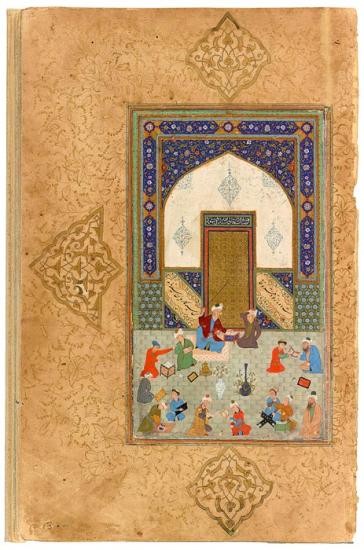
Classroom Scene
Shāh va darvish (The King and the Dervish), in Persian
Finished 19 January 1540, written by Mīr Calī al-Kātib al-Sulṭānī, probably for Cabd al-caziz Sulṭān.
Purchased by Pierpont Morgan before 1913
Hilālī, a Persian poet of Turkish origin, wrote three masnavīs (narrative poems in rhyming couplets), including a Lailā and Majnūn story with a happy ending and the present work, which was criticized in the memoirs of Bābur, the future Mughal emperor. Hilālī had made the dervish the lover and the king the beloved, making him a shameless strumpet.
School scenes were especially popular in Bukhara, reflecting the current emphasis on public education, and were derived from those depicted in the story of Lailā and Majnūn. The headmaster is about to strike a student, who catches his turban. Other students read, misbehave, write, or polish paper (left corner). ˓Abd al-˓Aziz Sulṭān (d.1549), for whom this manuscript is believed to have been commissioned, established a library that was supposedly without equal.
Persian poetry
The Persians loved their poetry and their poets, though the Qur˒an warned against believing their words (sura 69.41) and "those straying in evil who follow them" (sura 26.224). While Arabic was the first language of Islam and the language of the Qur˒an, Persian was favored by poets. Even Firdausī's (940–1020) celebrated Shāhnāma (Book of Kings), the national epic of Persian, was written in verse—some 50,000 couplets! Rūmī (1207–1273), the best known of the Sufi poets, put poetry in perspective when he wrote, "A hundred thousand books of poetry existed / Before the word of the illiterate [Prophet] they were put to shame!" (Masnavī I, 529). Presented here are illustrations of Firdausī's Shāhnāma as well as works by Sa˓ dī (ca.1184–1292), Hāfiz (ca. 1320–1389), and Jāmī (1414–1492), regarded as the last of the great Sufi poets. Also featured are illustrations from each of the five poems of the Khamsa (Quintet), by Niẓāmī (ca. 1141–1209), especially Lailā and Majnūn (The Persian Romeo and Juliet) and Bahrām Gūr's Seven Princesses.
Sa˓dī Shīrāzī's Būstān
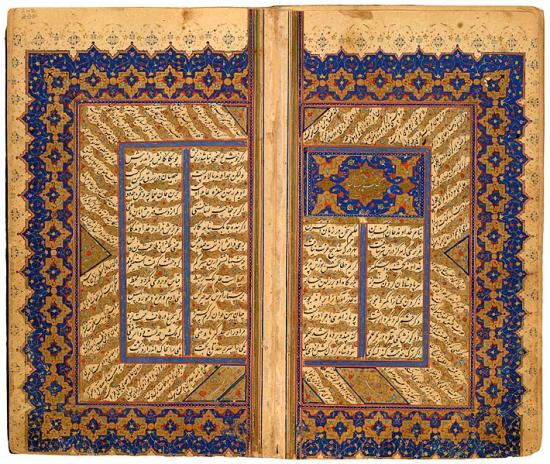
Double-Page Opening for Sa˓dī Shīrāzī's Būstān
Kulliyyat (Collected Works), in Persian, written by Hidayāt al-Kātib al-Shīrāzī
Purchased by Pierpont Morgan before 1913
Sa˓dī Shīrāzī, Anwari, and Firdausī were regarded as the three Persian Prophets of Poetry. There are no integral miniatures in this copy of Sa˓dī's Kulliyyat, but some of its major textual divisions are marked with ornate double-page headings (sarlauḥs). Such is the case with his two most famous works, the Būstān (The Orchard) and the Gulistān (The Rose Garden). In the latter, Sa˓dī wrote that "The children of Adam are limbs to each other, having been created of one essence." This was quoted by President Obama in an address to the Iranian people in 2009, when he argued that differences should not define us.
Persian poetry
The Persians loved their poetry and their poets, though the Qur˒an warned against believing their words (sura 69.41) and "those straying in evil who follow them" (sura 26.224). While Arabic was the first language of Islam and the language of the Qur˒an, Persian was favored by poets. Even Firdausī's (940–1020) celebrated Shāhnāma (Book of Kings), the national epic of Persian, was written in verse—some 50,000 couplets! Rūmī (1207–1273), the best known of the Sufi poets, put poetry in perspective when he wrote, "A hundred thousand books of poetry existed / Before the word of the illiterate [Prophet] they were put to shame!" (Masnavī I, 529). Presented here are illustrations of Firdausī's Shāhnāma as well as works by Sa˓ dī (ca.1184–1292), Hāfiz (ca. 1320–1389), and Jāmī (1414–1492), regarded as the last of the great Sufi poets. Also featured are illustrations from each of the five poems of the Khamsa (Quintet), by Niẓāmī (ca. 1141–1209), especially Lailā and Majnūn (The Persian Romeo and Juliet) and Bahrām Gūr's Seven Princesses.
Gathering in a Graveyard
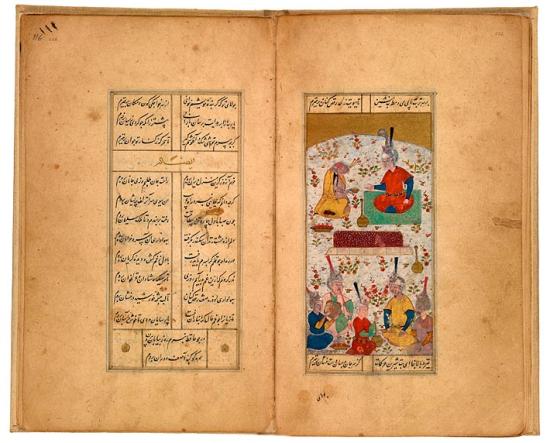
Gathering in a Graveyard
Dīvān (Poems), in Persian
Purchased by Pierpont Morgan before 1913
The author of his poem was known simply as Ḥāfiẓ, a name designating "one who knew the Qur˒an by heart." He was regarded as the greatest master of the Persian ghazal (love lyric) and his Dīvān remains popular to this day. Because of the sweetness of his poetry he was called Chagarlab (Sugar Lip). Here a convivial gathering, complete with wine and music, takes place in a cemetery. The low wooden cenotaph rests on a base of white marble. At the top of the page is the famous couplet:
Sit not at our tomb without wine and minstrel
That I may rise dancing from the grave at your aroma.
Persian poetry
The Persians loved their poetry and their poets, though the Qur˒an warned against believing their words (sura 69.41) and "those straying in evil who follow them" (sura 26.224). While Arabic was the first language of Islam and the language of the Qur˒an, Persian was favored by poets. Even Firdausī's (940–1020) celebrated Shāhnāma (Book of Kings), the national epic of Persian, was written in verse—some 50,000 couplets! Rūmī (1207–1273), the best known of the Sufi poets, put poetry in perspective when he wrote, "A hundred thousand books of poetry existed / Before the word of the illiterate [Prophet] they were put to shame!" (Masnavī I, 529). Presented here are illustrations of Firdausī's Shāhnāma as well as works by Sa˓ dī (ca.1184–1292), Hāfiz (ca. 1320–1389), and Jāmī (1414–1492), regarded as the last of the great Sufi poets. Also featured are illustrations from each of the five poems of the Khamsa (Quintet), by Niẓāmī (ca. 1141–1209), especially Lailā and Majnūn (The Persian Romeo and Juliet) and Bahrām Gūr's Seven Princesses.
Cisa (Jesus) and the Dead Dog
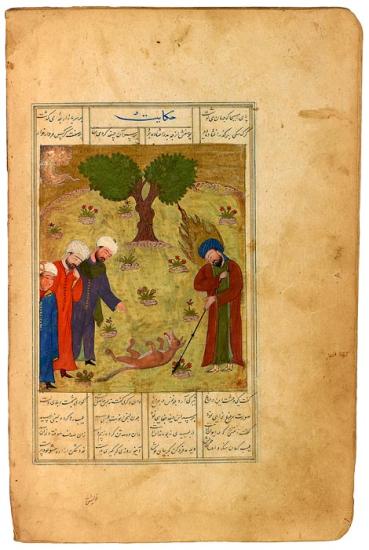
Cisa (Jesus) and the Dead Dog
Khamsa (Quintet), in Persian
Purchased by Pierpont Morgan, 1911
The Makhzan al-asrār (Treasury of Secrets) is the first (ca. 1175) of five long narrative poems making up Niẓāmī's Khamsa (Quintet). Through example, its twenty discourses deal with religious and ethical topics. Here, in an illustration of the tenth discourse, Jesus encounters a dead dog, about which three men make cruel remarks. But Jesus, disregarding faults and finding virtue, tells them that pearls are not as white as the dog's teeth. The moral: do not seek the faults of others and your own merit, but turn your eyes to yourself. The flaming halo denotes Christ as a prophet and saint.
Persian poetry
The Persians loved their poetry and their poets, though the Qur˒an warned against believing their words (sura 69.41) and "those straying in evil who follow them" (sura 26.224). While Arabic was the first language of Islam and the language of the Qur˒an, Persian was favored by poets. Even Firdausī's (940–1020) celebrated Shāhnāma (Book of Kings), the national epic of Persian, was written in verse—some 50,000 couplets! Rūmī (1207–1273), the best known of the Sufi poets, put poetry in perspective when he wrote, "A hundred thousand books of poetry existed / Before the word of the illiterate [Prophet] they were put to shame!" (Masnavī I, 529). Presented here are illustrations of Firdausī's Shāhnāma as well as works by Sa˓ dī (ca.1184–1292), Hāfiz (ca. 1320–1389), and Jāmī (1414–1492), regarded as the last of the great Sufi poets. Also featured are illustrations from each of the five poems of the Khamsa (Quintet), by Niẓāmī (ca. 1141–1209), especially Lailā and Majnūn (The Persian Romeo and Juliet) and Bahrām Gūr's Seven Princesses.
Sultan Sanjar and the Old Woman
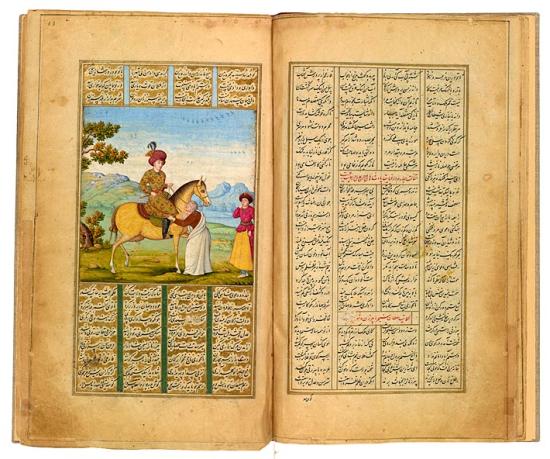
Sultan Sanjar and the Old Woman
Khamsa (Quintet), in Persian, written 1674–75 by Ghiyās al-Dīn Maḥmūd Ibn Salīm Lātī, with miniatures ca. 1700–1715 inscribed (probably erroneously) to Muḥammad Zamān and his brother Ḥājī Muḥammad.
Purchased by Pierpont Morgan, 1911
Here, to the amazement of an aide, an old woman grasps the hem of the coat of Sultan Sanjar (r. 1117–57) as he is about to go out hunting. She has come to complain of her mistreatment by the sultan's soldiers, but the Seljuq ruler tells her that the complaint is laughable when compared with his many successful conquests. "What good is it to conquer territories," she answers, "if you do not control your soldiers?"
The story is told in the fourth discourse of Niẓāmī's moralizing Makhzan al-asrār (Treasury of Secrets), the first (ca. 1175) of five long narrative poems that make up his Khamsa (Quintet). The name of the artist, Muḥammad Zamān, and the date 1086 (1675) below the old woman were probably added in error.
Persian poetry
The Persians loved their poetry and their poets, though the Qur˒an warned against believing their words (sura 69.41) and "those straying in evil who follow them" (sura 26.224). While Arabic was the first language of Islam and the language of the Qur˒an, Persian was favored by poets. Even Firdausī's (940–1020) celebrated Shāhnāma (Book of Kings), the national epic of Persian, was written in verse—some 50,000 couplets! Rūmī (1207–1273), the best known of the Sufi poets, put poetry in perspective when he wrote, "A hundred thousand books of poetry existed / Before the word of the illiterate [Prophet] they were put to shame!" (Masnavī I, 529). Presented here are illustrations of Firdausī's Shāhnāma as well as works by Sa˓ dī (ca.1184–1292), Hāfiz (ca. 1320–1389), and Jāmī (1414–1492), regarded as the last of the great Sufi poets. Also featured are illustrations from each of the five poems of the Khamsa (Quintet), by Niẓāmī (ca. 1141–1209), especially Lailā and Majnūn (The Persian Romeo and Juliet) and Bahrām Gūr's Seven Princesses.
Khusrau Seels Pardon from His Father
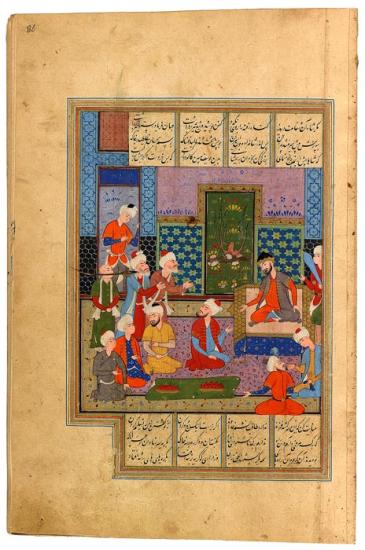
Khusrau Seels Pardon from His Father
Khamsa (Quintet), in Persian
Purchased by Pierpont Morgan, 1911
After a hunt, Prince Khusrau and his companions descend on a peasant's house, where drunken revelry ensues. Even the prince's horse breaks loose, trampling new crops. The punishment is severe: the horse's hooves are cut, and the prince's throne is given to the peasant. Khusrau, who begs two elders to plead for his pardon, exhibits strong remorse. Dressed in a shroud and weeping, he offers his sword and his head, saying that he could endure any sorrow but the anger of his father. Here, curiously, Khusrau holds the sword with his teeth! Hurmuzd is moved, kisses his son, forgives all, and restores him as crown prince. Khusrau (Chosroes II) was king of Persia from 590 until 628.)
This episode appears in Khusrau va Shīrīn (1180), the second story in Niẓāmī's Khamsa (Quintet).
Persian poetry
The Persians loved their poetry and their poets, though the Qur˒an warned against believing their words (sura 69.41) and "those straying in evil who follow them" (sura 26.224). While Arabic was the first language of Islam and the language of the Qur˒an, Persian was favored by poets. Even Firdausī's (940–1020) celebrated Shāhnāma (Book of Kings), the national epic of Persian, was written in verse—some 50,000 couplets! Rūmī (1207–1273), the best known of the Sufi poets, put poetry in perspective when he wrote, "A hundred thousand books of poetry existed / Before the word of the illiterate [Prophet] they were put to shame!" (Masnavī I, 529). Presented here are illustrations of Firdausī's Shāhnāma as well as works by Sa˓ dī (ca.1184–1292), Hāfiz (ca. 1320–1389), and Jāmī (1414–1492), regarded as the last of the great Sufi poets. Also featured are illustrations from each of the five poems of the Khamsa (Quintet), by Niẓāmī (ca. 1141–1209), especially Lailā and Majnūn (The Persian Romeo and Juliet) and Bahrām Gūr's Seven Princesses.
Shīrīn
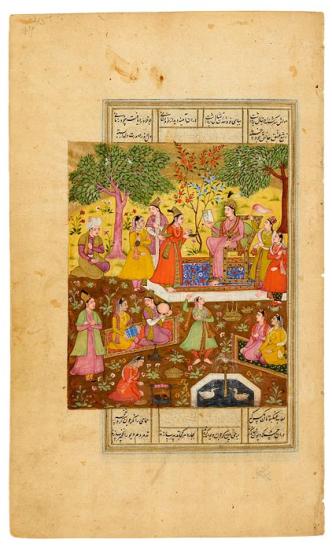
Shīrīn, an Armenian Princess, Looks at a Portrait of Khusrau
Khamsa (Quintet), in Persian, written by Mullā Fatḥ Muḥammad
Purchased by Pierpont Morgan, 1910
Khusrau, in a dream, learned from his grandfather that he was destined to have Shabdīz, the world's swiftest steed, and Shīrīn, an Armenian princess whose sweetness and beauty would sustain him for as long as he lived. Khusrau's dearest friend was Shāpūr, a painter whose portraits captured both the likeness and the soul of the subject. As it happened, Shāpūr had seen Shīrīn on a trip to Armenia, and he was now sent to find her on Khusrau's behalf. In Armenia, Shāpūr sketched a portrait of Khusrau and hung it on a tree in a meadow frequented by Shīrīn, hoping she would discover it. Shīrīn had a handmaiden bring the portrait of the handsome man to her, but fearing it was the work of evil spirits, had it destroyed. The next morning Shāpūr hung a second portrait on a tree, but Shīrīn's maid refused to fetch it. The third morning, in another meadow, Shāpūr hung a third portrait. This time, overcome with love, Shīrīn herself took it from the branch. In the miniature Shīrīn holds the magic portrait in her hands and is transfixed by the handsome prince, wondering who he was. Eventually Shāpūr, seated at the far left, tells her about Khusrau's dream of their destined love.
This episode appears in Khusrau va Shīrīn (1180), the second story in Niẓāmī's Khamsa (Quintet).
Persian poetry
The Persians loved their poetry and their poets, though the Qur˒an warned against believing their words (sura 69.41) and "those straying in evil who follow them" (sura 26.224). While Arabic was the first language of Islam and the language of the Qur˒an, Persian was favored by poets. Even Firdausī's (940–1020) celebrated Shāhnāma (Book of Kings), the national epic of Persian, was written in verse—some 50,000 couplets! Rūmī (1207–1273), the best known of the Sufi poets, put poetry in perspective when he wrote, "A hundred thousand books of poetry existed / Before the word of the illiterate [Prophet] they were put to shame!" (Masnavī I, 529). Presented here are illustrations of Firdausī's Shāhnāma as well as works by Sa˓ dī (ca.1184–1292), Hāfiz (ca. 1320–1389), and Jāmī (1414–1492), regarded as the last of the great Sufi poets. Also featured are illustrations from each of the five poems of the Khamsa (Quintet), by Niẓāmī (ca. 1141–1209), especially Lailā and Majnūn (The Persian Romeo and Juliet) and Bahrām Gūr's Seven Princesses.
Khusrau Encounters Shīrīn Bathing
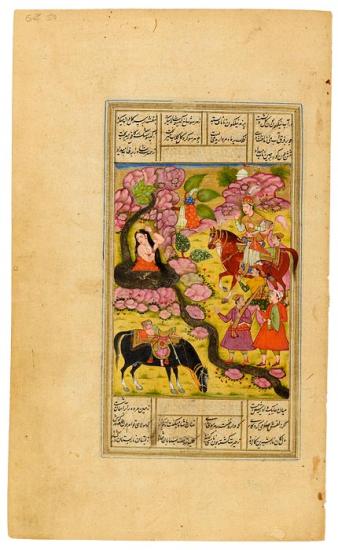
Khusrau Encounters Shīrīn Bathing
Khamsa (Quintet), in Persian, written by Mullā Fatḥ Muḥammad
Purchased by Pierpont Morgan, 1910
Khusrau, in a dream, learns that one day he will wed Shīrīn, an Armenian princess, and own her mother's horse, Shabdīz, the world's fastest steed. He entrusts his friend Shāpūr to arrange her flight to Persia on Shabdīz. Meanwhile Khusrau heads for Armenia and comes upon Shīrīn bathing in a pool. As he nears, his finger raised to his mouth in astonishment, he tells himself he would like to have such a beautiful maiden and horse, little knowing that one day both will be his. As Shīrīn rides away, she wonders if the stranger who startled her might have been Khusrau, though he was not in the anticipated red garb.
This episode appears in Khusrau va Shīrīn (1180) is the second story in Niẓāmī's Khamsa.
Persian poetry
The Persians loved their poetry and their poets, though the Qur˒an warned against believing their words (sura 69.41) and "those straying in evil who follow them" (sura 26.224). While Arabic was the first language of Islam and the language of the Qur˒an, Persian was favored by poets. Even Firdausī's (940–1020) celebrated Shāhnāma (Book of Kings), the national epic of Persian, was written in verse—some 50,000 couplets! Rūmī (1207–1273), the best known of the Sufi poets, put poetry in perspective when he wrote, "A hundred thousand books of poetry existed / Before the word of the illiterate [Prophet] they were put to shame!" (Masnavī I, 529). Presented here are illustrations of Firdausī's Shāhnāma as well as works by Sa˓ dī (ca.1184–1292), Hāfiz (ca. 1320–1389), and Jāmī (1414–1492), regarded as the last of the great Sufi poets. Also featured are illustrations from each of the five poems of the Khamsa (Quintet), by Niẓāmī (ca. 1141–1209), especially Lailā and Majnūn (The Persian Romeo and Juliet) and Bahrām Gūr's Seven Princesses.
Shīrīn
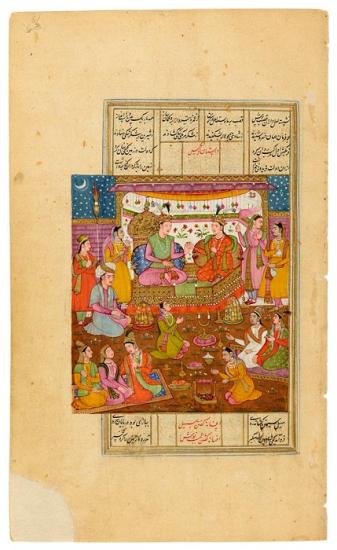
Shīrīn Entertains Khusrau in a Walled Garden
Khamsa (Quintet), in Persian, written by Mullā Fatḥ Muḥammad.
Purchased by Pierpont Morgan, 1910
Khusrau and Shīrīn went to Armenia, and visited her aunt, Queen Mihin Banu, who prepared many festivities and celebrations worthy of the king. Here, in a walled garden, on a moonlit night with many candles, the couple is seated on a low platform. Shīrīn offers Khusrau a cup of wine. The, queen, however, only permitted them to sit side by side in public after Shīrīn promised her that she would not be his before they were married. Nor did the queen permit them to be alone.
This episode appears in Khusrau va Shīrīn (1180), the second story in Niẓāmī's Khamsa (Quintet), a long poem that addresses religious and ethical topics.
Persian poetry
The Persians loved their poetry and their poets, though the Qur˒an warned against believing their words (sura 69.41) and "those straying in evil who follow them" (sura 26.224). While Arabic was the first language of Islam and the language of the Qur˒an, Persian was favored by poets. Even Firdausī's (940–1020) celebrated Shāhnāma (Book of Kings), the national epic of Persian, was written in verse—some 50,000 couplets! Rūmī (1207–1273), the best known of the Sufi poets, put poetry in perspective when he wrote, "A hundred thousand books of poetry existed / Before the word of the illiterate [Prophet] they were put to shame!" (Masnavī I, 529). Presented here are illustrations of Firdausī's Shāhnāma as well as works by Sa˓ dī (ca.1184–1292), Hāfiz (ca. 1320–1389), and Jāmī (1414–1492), regarded as the last of the great Sufi poets. Also featured are illustrations from each of the five poems of the Khamsa (Quintet), by Niẓāmī (ca. 1141–1209), especially Lailā and Majnūn (The Persian Romeo and Juliet) and Bahrām Gūr's Seven Princesses.
Farhād Carries Shīrīn
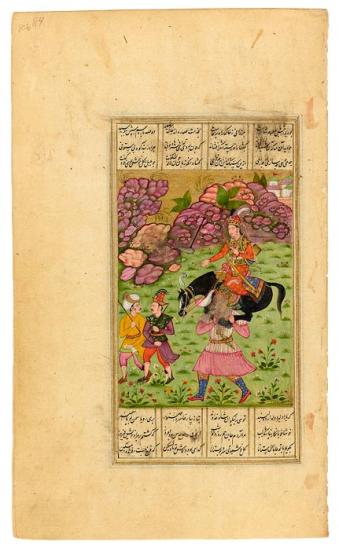
Farhād Carries Shīrīn and Her Black Horse, Shabdīz, Down Mount Bisutum
Khamsa (Quintet), in Persian, written by Mullā Fatḥ Muḥammad
Purchased by Pierpont Morgan, 1910
Khusrau, in order to seek peace between Persia and Byzantium, had to marry the king's daughter, Maryam, promising to take no other wife. Meanwhile, Shīrīn's aunt died, became the ruler of Armenia, and eventually heard of Khusrau's marriage. But they were still loyal to each other and wanted to meet. Shīrīn, who did not have access to milk, commissioned Farhād (a friend recommended by Shāpūr) to build a channel connecting her pasture to the palace. Farhād fell madly in love with Shīrīn. When Khusrau learned of his devotion, Khusrau asked him to cut a road through Mount Bisutum. After he arrived there he sculpted images of Shīrīn and Khusau Riding Shabdīz. When Shīrīn learned of Farhād's sculptures she went to visit him on Mount Bisutum, stirring his passions all the more. When she left, her horse stumbled, doubtless tired from the ascent up the mountain. Farhād, who was exceedingly strong, then picked up both Shīrīn and her horse, carried them down the mountain, and to the gate of her palace.
This episode appears in Khusrau va Shīrīn (1180), the second story in Niẓāmī's Khamsa (Quintet).
Persian poetry
The Persians loved their poetry and their poets, though the Qur˒an warned against believing their words (sura 69.41) and "those straying in evil who follow them" (sura 26.224). While Arabic was the first language of Islam and the language of the Qur˒an, Persian was favored by poets. Even Firdausī's (940–1020) celebrated Shāhnāma (Book of Kings), the national epic of Persian, was written in verse—some 50,000 couplets! Rūmī (1207–1273), the best known of the Sufi poets, put poetry in perspective when he wrote, "A hundred thousand books of poetry existed / Before the word of the illiterate [Prophet] they were put to shame!" (Masnavī I, 529). Presented here are illustrations of Firdausī's Shāhnāma as well as works by Sa˓ dī (ca.1184–1292), Hāfiz (ca. 1320–1389), and Jāmī (1414–1492), regarded as the last of the great Sufi poets. Also featured are illustrations from each of the five poems of the Khamsa (Quintet), by Niẓāmī (ca. 1141–1209), especially Lailā and Majnūn (The Persian Romeo and Juliet) and Bahrām Gūr's Seven Princesses.
Shīrīn Lectures Khusrau
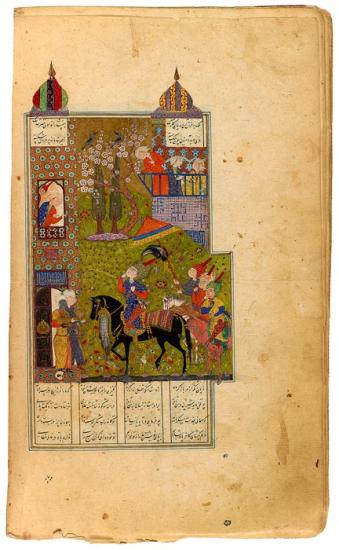
Shīrīn Lectures Khusrau
Khamsa (Quintet), in Persian, written by Mun˓im al-Din al-Auḥadī
Purchased by Pierpont Morgan, 1911
Deeply pained to learn that Khusrau was responsible for his rival Farhad's death as well as of the prince's affair with Shekar of Isfahan, Shīrīn will speak to him only from the roof when he comes to her palace to beg forgiveness. She reproaches him for causing her to suffer and for being merry from wine. If he is seeking love, he must be sober and marry her. They are then united in perfect love.
Many years later, Khusrau's son, lusting after his throne and wife, imprisoned him in a dungeon, where he was assassinated. After the splendid burial, Shīrīn, who had agreed to marry him, asked to be left alone for a final farewell, locked the vault door, and fatally stabbed herself.
This episode appears in Khusrau va Shīrīn (1180), the second story in Niẓāmī's Khamsa (Quintet).
Persian poetry
The Persians loved their poetry and their poets, though the Qur˒an warned against believing their words (sura 69.41) and "those straying in evil who follow them" (sura 26.224). While Arabic was the first language of Islam and the language of the Qur˒an, Persian was favored by poets. Even Firdausī's (940–1020) celebrated Shāhnāma (Book of Kings), the national epic of Persian, was written in verse—some 50,000 couplets! Rūmī (1207–1273), the best known of the Sufi poets, put poetry in perspective when he wrote, "A hundred thousand books of poetry existed / Before the word of the illiterate [Prophet] they were put to shame!" (Masnavī I, 529). Presented here are illustrations of Firdausī's Shāhnāma as well as works by Sa˓ dī (ca.1184–1292), Hāfiz (ca. 1320–1389), and Jāmī (1414–1492), regarded as the last of the great Sufi poets. Also featured are illustrations from each of the five poems of the Khamsa (Quintet), by Niẓāmī (ca. 1141–1209), especially Lailā and Majnūn (The Persian Romeo and Juliet) and Bahrām Gūr's Seven Princesses.
Lailā and Qais in School
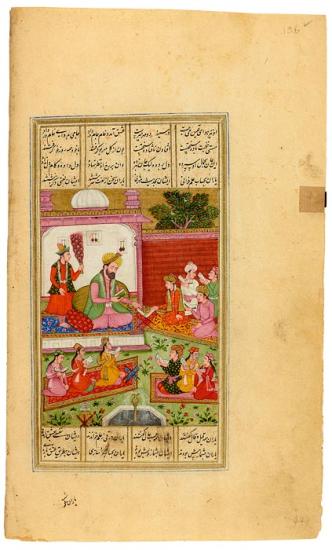
Lailā and Qais in School
Khamsa (Quintet), in Persian, written by Mullā Fatḥ Muḥammad
Purchased by Pierpont Morgan, 1910
The children of two great chieftains, Lailā and Qais were sent to study under a learned teacher. When Lailā entered the schoolroom, love awakened in Qais's heart, and he vowed to love her all his life. Thereafter he was able to do little else but stare at her, continually repeating her name. Others said he behaved like a madman, losing his heart and soul. People called him a madman, or majnūn, and henceforth he was known as Majnūn. Forbidden to see Lailā, he withdrew to the desert and befriended beasts. In the miniature, a youth, perhaps meant to be Qais, sits among the girls in the foreground.
Lailā va Majnūn (1188), a Persian Romeo and Juliet, is the third poem of the Khamsa (Quintet), a multi-part work by the poet Niẓāmī. The story is based on two real-life seventh-century lovers.
Persian poetry
The Persians loved their poetry and their poets, though the Qur˒an warned against believing their words (sura 69.41) and "those straying in evil who follow them" (sura 26.224). While Arabic was the first language of Islam and the language of the Qur˒an, Persian was favored by poets. Even Firdausī's (940–1020) celebrated Shāhnāma (Book of Kings), the national epic of Persian, was written in verse—some 50,000 couplets! Rūmī (1207–1273), the best known of the Sufi poets, put poetry in perspective when he wrote, "A hundred thousand books of poetry existed / Before the word of the illiterate [Prophet] they were put to shame!" (Masnavī I, 529). Presented here are illustrations of Firdausī's Shāhnāma as well as works by Sa˓ dī (ca.1184–1292), Hāfiz (ca. 1320–1389), and Jāmī (1414–1492), regarded as the last of the great Sufi poets. Also featured are illustrations from each of the five poems of the Khamsa (Quintet), by Niẓāmī (ca. 1141–1209), especially Lailā and Majnūn (The Persian Romeo and Juliet) and Bahrām Gūr's Seven Princesses.
Majnūn Surrounded by Pairs of Animals
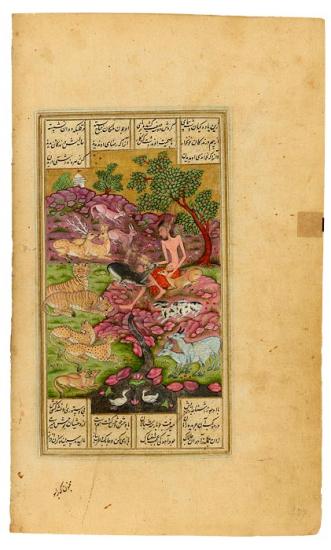
Majnūn Surrounded by Pairs of Animals in the Wilderness
Khamsa (Quintet), in Persian, written by Mullā Fatḥ Muḥammad
Purchased by Pierpont Morgan, 1910
Because of his love for Lailā, Majnūn not only became a madman but also a poet. A father had lost a son, and he was a prisoner in the land of love. He became increasingly separated from his friends, taking refuge in the wilderness. The wild animals did not attack him, or each other, becoming tame and friendly with the stranger in their midst. He became their friend and master, and they protected him. Although he withdrew from public society, the intensity of his love for Lailā never diminished.
Lailā va Majnūn (1188), a Persian Romeo and Juliet, is the third poem of the Khamsa (Quintet), a multi-part work by the poet Niẓāmī. The story is based on two real-life seventh-century lovers.
Persian poetry
The Persians loved their poetry and their poets, though the Qur˒an warned against believing their words (sura 69.41) and "those straying in evil who follow them" (sura 26.224). While Arabic was the first language of Islam and the language of the Qur˒an, Persian was favored by poets. Even Firdausī's (940–1020) celebrated Shāhnāma (Book of Kings), the national epic of Persian, was written in verse—some 50,000 couplets! Rūmī (1207–1273), the best known of the Sufi poets, put poetry in perspective when he wrote, "A hundred thousand books of poetry existed / Before the word of the illiterate [Prophet] they were put to shame!" (Masnavī I, 529). Presented here are illustrations of Firdausī's Shāhnāma as well as works by Sa˓ dī (ca.1184–1292), Hāfiz (ca. 1320–1389), and Jāmī (1414–1492), regarded as the last of the great Sufi poets. Also featured are illustrations from each of the five poems of the Khamsa (Quintet), by Niẓāmī (ca. 1141–1209), especially Lailā and Majnūn (The Persian Romeo and Juliet) and Bahrām Gūr's Seven Princesses.
Majnūn Grasps the Door Knocker
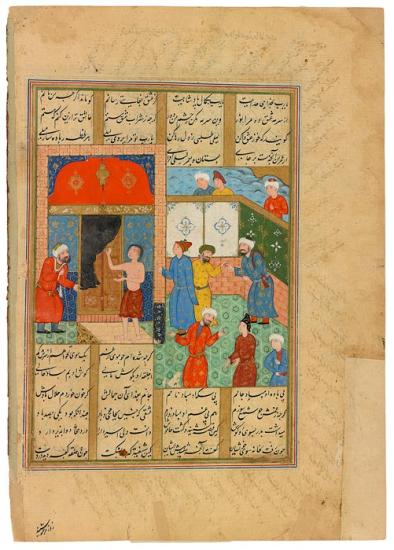
Majnūn Grasps the Door Knocker of the Kaaba
Khamsa (Quintet), in Persian, illustrated ca. 1579 by Siyāvush the Georgian and his workshop for ˓Alī Khān (Beg Turkman).
Bequest of Belle da Costa Greene, 1950
In order to cure Majnūn, his father takes him on a pilgrimage to Mecca, where he hopes that his son will ask to be saved from his passion. Instead, Majnūn grasps the door knocker of the Kaaba and cries, "I pray to You, let me not be cured of love, but let my passion grow! Make my love a hundred times as great as it is this very day!" Nothing further can be done, for Majnūn can never be cured, having blessed Lailā and cursed himself before the Holy Shrine. His father, full of grief, returns home, and Majnūn, whose life is threatened by Lailā's father, again retreats into the desert.
Lailā va Majnūn (1188), a Persian Romeo and Juliet, is the third poem of the Khamsa (Quintet), a multi-part work by the poet Niẓāmī. The story is based on two real-life seventh-century lovers.
Persian poetry
The Persians loved their poetry and their poets, though the Qur˒an warned against believing their words (sura 69.41) and "those straying in evil who follow them" (sura 26.224). While Arabic was the first language of Islam and the language of the Qur˒an, Persian was favored by poets. Even Firdausī's (940–1020) celebrated Shāhnāma (Book of Kings), the national epic of Persian, was written in verse—some 50,000 couplets! Rūmī (1207–1273), the best known of the Sufi poets, put poetry in perspective when he wrote, "A hundred thousand books of poetry existed / Before the word of the illiterate [Prophet] they were put to shame!" (Masnavī I, 529). Presented here are illustrations of Firdausī's Shāhnāma as well as works by Sa˓ dī (ca.1184–1292), Hāfiz (ca. 1320–1389), and Jāmī (1414–1492), regarded as the last of the great Sufi poets. Also featured are illustrations from each of the five poems of the Khamsa (Quintet), by Niẓāmī (ca. 1141–1209), especially Lailā and Majnūn (The Persian Romeo and Juliet) and Bahrām Gūr's Seven Princesses.
Lailā Visits Majnūn
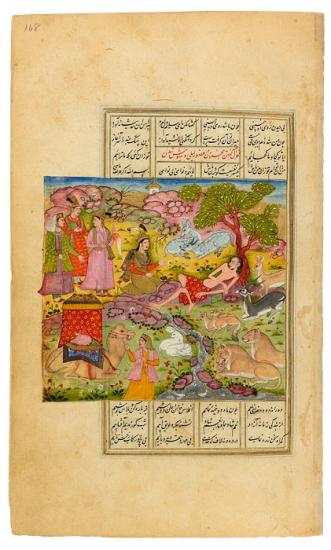
Lailā Visits Majnūn in the Wilderness
Khamsa (Quintet), in Persian, written by Mullā Fatḥ Muḥammad
Purchased by Pierpont Morgan, 1910
Lailā, with four companions, visits Majnūn in the wilderness. Majnūn, reclining beneath a tree, is surrounded by tame animals.
Lailā va Majnūn (1188), a Persian Romeo and Juliet, is the third poem of the Khamsa (Quintet), a multi-part work by the poet Niẓāmī. The story is based on two real-life seventh-century lovers.
Persian poetry
The Persians loved their poetry and their poets, though the Qur˒an warned against believing their words (sura 69.41) and "those straying in evil who follow them" (sura 26.224). While Arabic was the first language of Islam and the language of the Qur˒an, Persian was favored by poets. Even Firdausī's (940–1020) celebrated Shāhnāma (Book of Kings), the national epic of Persian, was written in verse—some 50,000 couplets! Rūmī (1207–1273), the best known of the Sufi poets, put poetry in perspective when he wrote, "A hundred thousand books of poetry existed / Before the word of the illiterate [Prophet] they were put to shame!" (Masnavī I, 529). Presented here are illustrations of Firdausī's Shāhnāma as well as works by Sa˓ dī (ca.1184–1292), Hāfiz (ca. 1320–1389), and Jāmī (1414–1492), regarded as the last of the great Sufi poets. Also featured are illustrations from each of the five poems of the Khamsa (Quintet), by Niẓāmī (ca. 1141–1209), especially Lailā and Majnūn (The Persian Romeo and Juliet) and Bahrām Gūr's Seven Princesses.
Lailā Summons Majnūn

Lailā Summons Majnūn to Her Camp
Khamsa (Quintet), in Persian, illustrated ca. 1579 by Siyāvush the Georgian and his workshop for ˓Alī Khān (Beg Turkman)
Bequest of Belle da Costa Greene, 1950
Although Lailā had been forced to marry Ibn Salam, he resigned himself to simply beholding her beauty, as she refused to submit to him. Lailā's thoughts were always about Majnūn, and she wanted to see how he was. Through the aid of an old man, they found a way to exchange messages. At the upper left, a messenger informs Majnūn of the plan to meet in a thicket near Lailā's camp, shown on the lower right. He holds a book of his poems, which he plans to read to her.
Lailā va Majnūn (1188), a Persian Romeo and Juliet, is the third poem of the Khamsa (Quintet), a multi-part work by the poet Niẓāmī. The story is based on two real-life seventh-century lovers.
Persian poetry
The Persians loved their poetry and their poets, though the Qur˒an warned against believing their words (sura 69.41) and "those straying in evil who follow them" (sura 26.224). While Arabic was the first language of Islam and the language of the Qur˒an, Persian was favored by poets. Even Firdausī's (940–1020) celebrated Shāhnāma (Book of Kings), the national epic of Persian, was written in verse—some 50,000 couplets! Rūmī (1207–1273), the best known of the Sufi poets, put poetry in perspective when he wrote, "A hundred thousand books of poetry existed / Before the word of the illiterate [Prophet] they were put to shame!" (Masnavī I, 529). Presented here are illustrations of Firdausī's Shāhnāma as well as works by Sa˓ dī (ca.1184–1292), Hāfiz (ca. 1320–1389), and Jāmī (1414–1492), regarded as the last of the great Sufi poets. Also featured are illustrations from each of the five poems of the Khamsa (Quintet), by Niẓāmī (ca. 1141–1209), especially Lailā and Majnūn (The Persian Romeo and Juliet) and Bahrām Gūr's Seven Princesses.
Majnūn Visits Lailā's
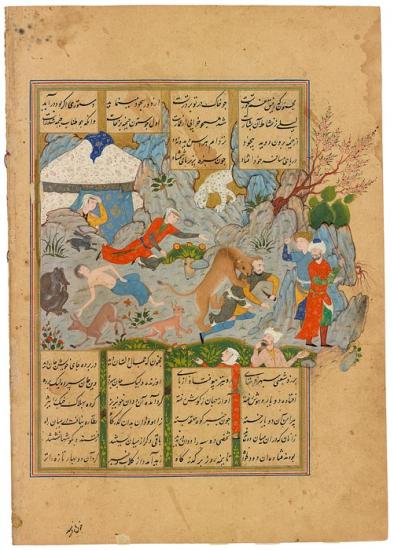
Majnūn Visits Lailā's Camp for the Last Time
Khamsa (Quintet), in Persian, illustrated ca. 1579 by Siyāvush the Georgian and his workshop for ˓Alī Khān (Beg Turkman)
Bequest of Belle da Costa Greene, 1950
Finally the two ill-fated lovers are to meet; however, overcome by emotions, they faint. They are, however, protected by Majnūn's animal entourage, and a lion attacks a man who attempted to approach them. A man at the lower right raises he finger to his mouth in astonishment. (After the tears of the old man who arranged the meeting revive Majnūn, the most beautiful verses he has ever composed flow from his lips. But after reciting a few, he suddenly rises and flees into the desert.)
Lailā va Majnūn (1188), a Persian Romeo and Juliet, is the third poem of the Khamsa (Quintet), a multi-part work by the poet Niẓāmī. The story is based on two real-life seventh-century lovers.
Persian poetry
The Persians loved their poetry and their poets, though the Qur˒an warned against believing their words (sura 69.41) and "those straying in evil who follow them" (sura 26.224). While Arabic was the first language of Islam and the language of the Qur˒an, Persian was favored by poets. Even Firdausī's (940–1020) celebrated Shāhnāma (Book of Kings), the national epic of Persian, was written in verse—some 50,000 couplets! Rūmī (1207–1273), the best known of the Sufi poets, put poetry in perspective when he wrote, "A hundred thousand books of poetry existed / Before the word of the illiterate [Prophet] they were put to shame!" (Masnavī I, 529). Presented here are illustrations of Firdausī's Shāhnāma as well as works by Sa˓ dī (ca.1184–1292), Hāfiz (ca. 1320–1389), and Jāmī (1414–1492), regarded as the last of the great Sufi poets. Also featured are illustrations from each of the five poems of the Khamsa (Quintet), by Niẓāmī (ca. 1141–1209), especially Lailā and Majnūn (The Persian Romeo and Juliet) and Bahrām Gūr's Seven Princesses.
Majnūn Mourns at Lailā's Tomb
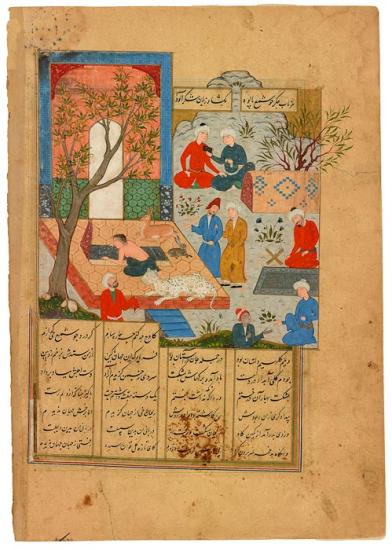
Majnūn Mourns at Lailā's Tomb
Khamsa (Quintet), in Persian, illustrated ca. 1579 by Siyāvush the Georgian and his workshop for ˓Alī Khān (Beg Turkman)
Bequest of Belle da Costa Greene, 1950
Lailā knew that Majnūn would come to mourn her, and had asked her mother to tell him that she had always remained true, and that she should be buried in bridal clothes. Majnūn comes repeatedly to mourn, watched over by his animals. On his last visit, he embraces the gravestone with both hands, and when he utters the words You, my love... , his soul leaves his body. The animals remain until nothing is left but his bones. Members of both tribes weep, and Majnūn is buried at Lailā's side. Some see Majnūn's love for Lailā as a metaphor for his all-consuming love of God.
Faithful in separation, true in love,
One tent will hold them in the world above.
Lailā va Majnūn (1188), a Persian Romeo and Juliet, is the third poem of the Khamsa (Quintet), a multi-part work by the poet Niẓāmī. The story is based on two real-life seventh-century lovers.
Persian poetry
The Persians loved their poetry and their poets, though the Qur˒an warned against believing their words (sura 69.41) and "those straying in evil who follow them" (sura 26.224). While Arabic was the first language of Islam and the language of the Qur˒an, Persian was favored by poets. Even Firdausī's (940–1020) celebrated Shāhnāma (Book of Kings), the national epic of Persian, was written in verse—some 50,000 couplets! Rūmī (1207–1273), the best known of the Sufi poets, put poetry in perspective when he wrote, "A hundred thousand books of poetry existed / Before the word of the illiterate [Prophet] they were put to shame!" (Masnavī I, 529). Presented here are illustrations of Firdausī's Shāhnāma as well as works by Sa˓ dī (ca.1184–1292), Hāfiz (ca. 1320–1389), and Jāmī (1414–1492), regarded as the last of the great Sufi poets. Also featured are illustrations from each of the five poems of the Khamsa (Quintet), by Niẓāmī (ca. 1141–1209), especially Lailā and Majnūn (The Persian Romeo and Juliet) and Bahrām Gūr's Seven Princesses.
Iskandar Battles the Zangīs
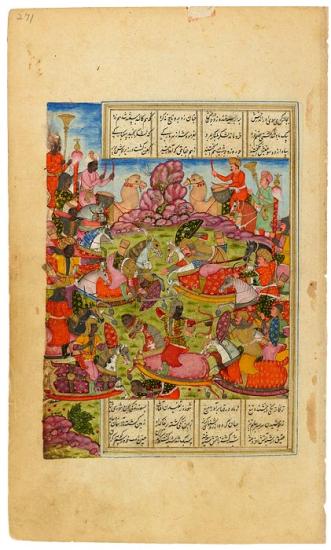
Iskandar Battles the Zangīs
Khamsa (Quintet), in Persian, written by Mullā Fatḥ Muḥammad
Purchased by Pierpont Morgan, 1910
The fourth poem in the Persian poet Niẓāmī's Khamsa (Quintet) is the Iskandarnāma (1194), consisting of stories about Iskandar (Alexander the Great). Iskander, the king of Rūm, had sent his messenger/orator Tūtiyā-Nosh to the African king of Zang, who, out of rage, killed the beautiful messenger, decapitated him, and drank his blood. The miniature depicts the defeat of the African army of Zang by Iskandar's army. The drummers for each side are on camels at the top, while the defeat is shown in the middle ground. In the foreground the Zangīs flee. After his return from victory Iskandar laid the foundations of Alexandria.
Persian poetry
The Persians loved their poetry and their poets, though the Qur˒an warned against believing their words (sura 69.41) and "those straying in evil who follow them" (sura 26.224). While Arabic was the first language of Islam and the language of the Qur˒an, Persian was favored by poets. Even Firdausī's (940–1020) celebrated Shāhnāma (Book of Kings), the national epic of Persian, was written in verse—some 50,000 couplets! Rūmī (1207–1273), the best known of the Sufi poets, put poetry in perspective when he wrote, "A hundred thousand books of poetry existed / Before the word of the illiterate [Prophet] they were put to shame!" (Masnavī I, 529). Presented here are illustrations of Firdausī's Shāhnāma as well as works by Sa˓ dī (ca.1184–1292), Hāfiz (ca. 1320–1389), and Jāmī (1414–1492), regarded as the last of the great Sufi poets. Also featured are illustrations from each of the five poems of the Khamsa (Quintet), by Niẓāmī (ca. 1141–1209), especially Lailā and Majnūn (The Persian Romeo and Juliet) and Bahrām Gūr's Seven Princesses.
Iskandar Comforts the Dying Dārā
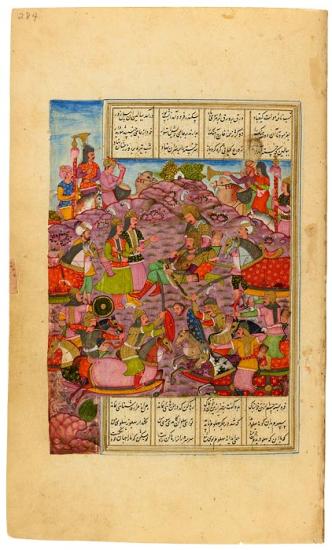
Iskandar Comforts the Dying Dārā
Khamsa (Quintet), in Persian, written by Mullā Fatḥ Muḥammad
Purchased by Pierpont Morgan, 1910
Stories about Iskandar (Alexander the Great) were very popular and appear in Firdausī's epic Shāhnāma (Book of Kings) and, as here, in the fourth poem of Niẓāmī's Khamsa (Quintet), the Iskandarnāma (1194). In his quest to conquer Persia, Iskandar twice defeated Dārā (Darius III, r. 336–330 B.C.): in the battles at Issus (333 B.C.) and Gaugamela (331 B.C.) Before he could capture Dārā in another battle, two of Dārā's closest advisors conspired to stab him. Iskandar weeps as Dārā dies in his arms, asking Iskandar to care for his family and seek the hand of his daughter Roshanak in marriage. He then honors the deceased monarch with a royal burial. The two advisors, who stand before Dārā, thought their deed would be rewarded, but they were hanged instead.
Persian poetry
The Persians loved their poetry and their poets, though the Qur˒an warned against believing their words (sura 69.41) and "those straying in evil who follow them" (sura 26.224). While Arabic was the first language of Islam and the language of the Qur˒an, Persian was favored by poets. Even Firdausī's (940–1020) celebrated Shāhnāma (Book of Kings), the national epic of Persian, was written in verse—some 50,000 couplets! Rūmī (1207–1273), the best known of the Sufi poets, put poetry in perspective when he wrote, "A hundred thousand books of poetry existed / Before the word of the illiterate [Prophet] they were put to shame!" (Masnavī I, 529). Presented here are illustrations of Firdausī's Shāhnāma as well as works by Sa˓ dī (ca.1184–1292), Hāfiz (ca. 1320–1389), and Jāmī (1414–1492), regarded as the last of the great Sufi poets. Also featured are illustrations from each of the five poems of the Khamsa (Quintet), by Niẓāmī (ca. 1141–1209), especially Lailā and Majnūn (The Persian Romeo and Juliet) and Bahrām Gūr's Seven Princesses.
Khiżr żand Ilyās
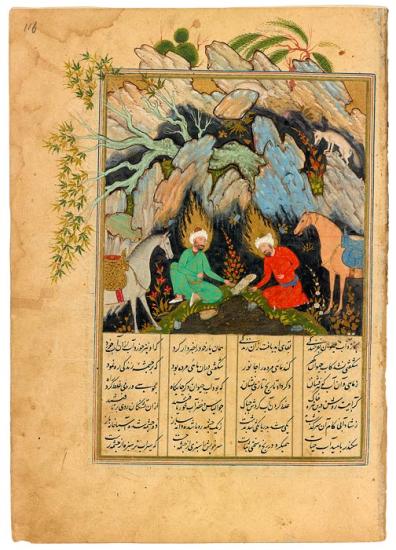
Khiżr żand Ilyās at the Fountain of Life
Khamsa (Quintet), in Persian, illustrated ca. 1579 by Siyāvush the Georgian and his workshop for ˓Alī Khān (Beg Turkman)
Bequest of Belle da Costa Greene, 1950
Iskandar (Alexander the Great) and Khiżr, his vizier, set out to reach the end of the world in order to find the Water of Life. They took different paths, however, and only Khiżr found it, achieving immortality. Here he is shown with Ilyās (Elijah). Their dried fish, which accidentally fell into the water, has been miraculously revived. Witnessing the miracle, they achieve prophethood, symbolized by their flaming gold halos. The Prophet Muḥammad reportedly said that Khiżr and Ilyās spend every month of Ramadan in Jerusalem. Khiżr may be the figure on the left, as his name in Arabic means "the green one."
This episode appears in the Iskandarnāma (1194), the fourth poem of the Persian poet Niẓāmī's Khamsa (Quintet).
Persian poetry
The Persians loved their poetry and their poets, though the Qur˒an warned against believing their words (sura 69.41) and "those straying in evil who follow them" (sura 26.224). While Arabic was the first language of Islam and the language of the Qur˒an, Persian was favored by poets. Even Firdausī's (940–1020) celebrated Shāhnāma (Book of Kings), the national epic of Persian, was written in verse—some 50,000 couplets! Rūmī (1207–1273), the best known of the Sufi poets, put poetry in perspective when he wrote, "A hundred thousand books of poetry existed / Before the word of the illiterate [Prophet] they were put to shame!" (Masnavī I, 529). Presented here are illustrations of Firdausī's Shāhnāma as well as works by Sa˓ dī (ca.1184–1292), Hāfiz (ca. 1320–1389), and Jāmī (1414–1492), regarded as the last of the great Sufi poets. Also featured are illustrations from each of the five poems of the Khamsa (Quintet), by Niẓāmī (ca. 1141–1209), especially Lailā and Majnūn (The Persian Romeo and Juliet) and Bahrām Gūr's Seven Princesses.
Bahrām Gūr and His Court
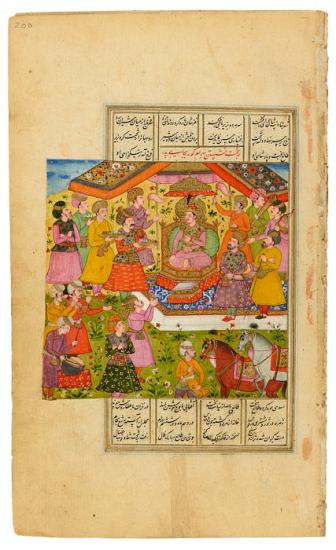
Bahrām Gūr and His Court
Khamsa (Quintet), in Persian, written by Mullā Fatḥ Muḥammad
Purchased by Pierpont Morgan, 1910
This episode appears in the Haft Paikar (Seven Princesses), the last part (1197) of the Persian poet Niẓāmī's Khamsa (Quintet). It is essentially a romanticized biography of Bahrām Gūr, a Persian king (r. 421–438) and a renowned hunter and lover.
In the miniature, Bahrām Gūr is enthroned, surrounded by sixteen members of his court. Some of them offer gifts in bowls and two hold fly whisks. There is also a military band, as well as a groom with two horses.
Persian poetry
The Persians loved their poetry and their poets, though the Qur˒an warned against believing their words (sura 69.41) and "those straying in evil who follow them" (sura 26.224). While Arabic was the first language of Islam and the language of the Qur˒an, Persian was favored by poets. Even Firdausī's (940–1020) celebrated Shāhnāma (Book of Kings), the national epic of Persian, was written in verse—some 50,000 couplets! Rūmī (1207–1273), the best known of the Sufi poets, put poetry in perspective when he wrote, "A hundred thousand books of poetry existed / Before the word of the illiterate [Prophet] they were put to shame!" (Masnavī I, 529). Presented here are illustrations of Firdausī's Shāhnāma as well as works by Sa˓ dī (ca.1184–1292), Hāfiz (ca. 1320–1389), and Jāmī (1414–1492), regarded as the last of the great Sufi poets. Also featured are illustrations from each of the five poems of the Khamsa (Quintet), by Niẓāmī (ca. 1141–1209), especially Lailā and Majnūn (The Persian Romeo and Juliet) and Bahrām Gūr's Seven Princesses.
Bahrām Gūr Slays a Dragon
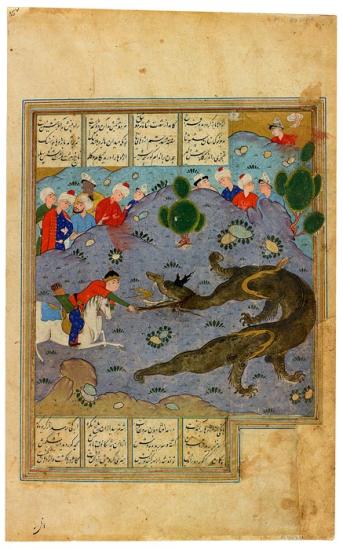
Bahrām Gūr Slays a Dragon
Khamsa (Quintet), in Persian
Bequest of Belle da Costa Greene, 1950
This episode appears in the Haft Paikar (Seven Princesses), the last part (1197) of the Persian poet Niẓāmī's Khamsa (Quintet). It is essentially a romanticized biography of Bahrām Gūr, a Persian king (r. 421–438) and a renowned hunter and lover.
One day, as he pursues a wild ass, Bahrām comes upon a dragon, which has just eaten the ass's foal. Called to do justice, he kills the dragon, cuts open its stomach, and sees the foal. Bahrām follows the avenged ass into the dragon's cave to discover great treasures. At the end of his life, Bahrām saw a wild ass enter a cave. Thinking it an omen, he followed it but was never seen again. Gūr, meaning "wild ass," had found the tomb (gūr) he sought—a play on words.
Persian poetry
The Persians loved their poetry and their poets, though the Qur˒an warned against believing their words (sura 69.41) and "those straying in evil who follow them" (sura 26.224). While Arabic was the first language of Islam and the language of the Qur˒an, Persian was favored by poets. Even Firdausī's (940–1020) celebrated Shāhnāma (Book of Kings), the national epic of Persian, was written in verse—some 50,000 couplets! Rūmī (1207–1273), the best known of the Sufi poets, put poetry in perspective when he wrote, "A hundred thousand books of poetry existed / Before the word of the illiterate [Prophet] they were put to shame!" (Masnavī I, 529). Presented here are illustrations of Firdausī's Shāhnāma as well as works by Sa˓ dī (ca.1184–1292), Hāfiz (ca. 1320–1389), and Jāmī (1414–1492), regarded as the last of the great Sufi poets. Also featured are illustrations from each of the five poems of the Khamsa (Quintet), by Niẓāmī (ca. 1141–1209), especially Lailā and Majnūn (The Persian Romeo and Juliet) and Bahrām Gūr's Seven Princesses.
Bahrām Gūr's Trick Shot
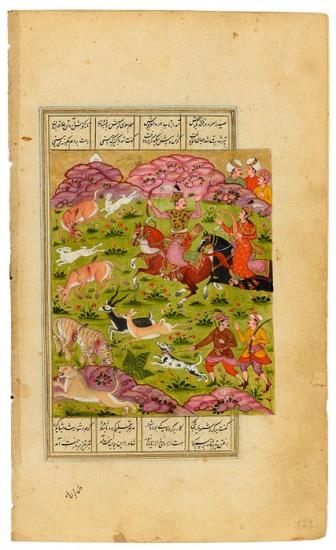
Bahrām Gūr's Trick Shot
Khamsa (Quintet), in Persian, written by Mullā Fatḥ Muḥammad
Purchased by Pierpont Morgan, 1910
This episode appears in the Haft Paikar (Seven Princesses), the last part (1197) of the Persian poet Niẓāmī's Khamsa (Quintet). It is essentially a romanticized biography of Bahrām Gūr, a Persian king (r. 421–438) and a renowned hunter and lover.
One day, while hunting with Fitna, his harpist slave girl, Bahrām Gūr slays both a tiger and a wild ass. Unimpressed, Fitna observes that hunting is a noble pastime and that he had been trained in that art as a youth. She then challenges him to pin a wild ass's hind hoof to its ear—a trick requiring two arrows. The first grazes the animal's ear, causing it to raise its hoof to scratch it, while the second immediately pins the raised hoof to the ear. Bahrām's nickname, coincidentally, is Gūr, the Persian term for "wild ass." The trick shot is depicted at the upper left, while two hunters approach the felled lion at the lower right.
Persian poetry
The Persians loved their poetry and their poets, though the Qur˒an warned against believing their words (sura 69.41) and "those straying in evil who follow them" (sura 26.224). While Arabic was the first language of Islam and the language of the Qur˒an, Persian was favored by poets. Even Firdausī's (940–1020) celebrated Shāhnāma (Book of Kings), the national epic of Persian, was written in verse—some 50,000 couplets! Rūmī (1207–1273), the best known of the Sufi poets, put poetry in perspective when he wrote, "A hundred thousand books of poetry existed / Before the word of the illiterate [Prophet] they were put to shame!" (Masnavī I, 529). Presented here are illustrations of Firdausī's Shāhnāma as well as works by Sa˓ dī (ca.1184–1292), Hāfiz (ca. 1320–1389), and Jāmī (1414–1492), regarded as the last of the great Sufi poets. Also featured are illustrations from each of the five poems of the Khamsa (Quintet), by Niẓāmī (ca. 1141–1209), especially Lailā and Majnūn (The Persian Romeo and Juliet) and Bahrām Gūr's Seven Princesses.
Bahrām Gūr and the Indian Princess
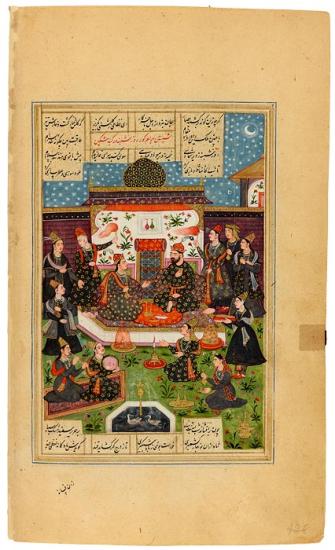
Bahrām Gūr and the Indian Princess Fūrak in the Black Pavilion
Khamsa (Quintet), in Persian, written by Mullā Fatḥ Muḥammad
Purchased by Pierpont Morgan, 1910
This episode appears in the Haft Paikar (Seven Princesses), the last part (1197) of the Persian poet Niẓāmī's Khamsa (Quintet). It is essentially a romanticized biography of Bahrām Gūr, a Persian king (r. 421–438) and a renowned hunter and lover.
On Saturday, the day of Saturn, dressed in black, Bahrām Gūr visits the Black Pavilion. During the day, in the darkness of the Black Pavilion, he enjoys the charms of Fūrak. When night falls—note the moon and stars—Fūrak tells the following story.
A king visited the City of the Stupefied, where all wore black, but nobody would tell him why. A bird transported him from the top of a tower to a garden. When night fell lovely maidens entered the garden, followed by the queen of the magical creatures, whom he tried to seduce. After thirty attempts he resorted to force, and found himself returned to the bottom of the tower. He then understood why all wore black and henceforth did as well.
The Seven Princesses
This episode appears in the Haft Paikar (Seven Princesses), the last part (1197) of the Persian poet Niẓāmī's Khamsa (Quintet). It is essentially a romanticized biography of Bahrām Gūr, a Persian king (r. 421–438) and a renowned hunter and lover.
One day, in his castle in Khavarnak, Bahrām Gūr comes across a secret room that had been overlooked by his keeper. After entering the room he sees portraits of seven princesses with whom he instantly falls in love. Among the portraits was one of a young man inscribed with his name, an omen of things to come. After receiving permission from their fathers, he marries them all, building for each a domed pavilion with a color scheme symbolizing the country from which each came. The colors also symbolize the days of the week and the planets for which they were named. Each princess is asked to tell a sensuous story matching the mood of the color. "Even as the planets move, so then shall I," says Bahrām, and "I will visit one pavilion a day from the first of the week to the last." He apparently followed the cycle for at least seven years.
Persian poetry
The Persians loved their poetry and their poets, though the Qur˒an warned against believing their words (sura 69.41) and "those straying in evil who follow them" (sura 26.224). While Arabic was the first language of Islam and the language of the Qur˒an, Persian was favored by poets. Even Firdausī's (940–1020) celebrated Shāhnāma (Book of Kings), the national epic of Persian, was written in verse—some 50,000 couplets! Rūmī (1207–1273), the best known of the Sufi poets, put poetry in perspective when he wrote, "A hundred thousand books of poetry existed / Before the word of the illiterate [Prophet] they were put to shame!" (Masnavī I, 529). Presented here are illustrations of Firdausī's Shāhnāma as well as works by Sa˓ dī (ca.1184–1292), Hāfiz (ca. 1320–1389), and Jāmī (1414–1492), regarded as the last of the great Sufi poets. Also featured are illustrations from each of the five poems of the Khamsa (Quintet), by Niẓāmī (ca. 1141–1209), especially Lailā and Majnūn (The Persian Romeo and Juliet) and Bahrām Gūr's Seven Princesses.
Bahrām Gūr and Princess Azargūn
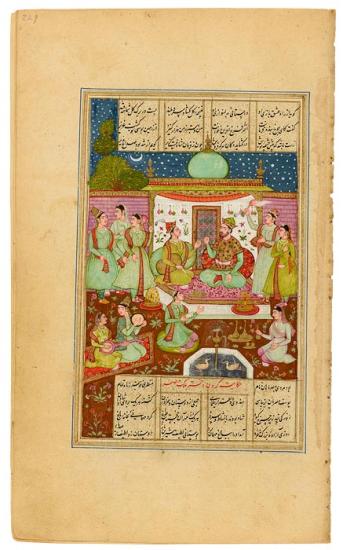
Bahrām Gūr and Princess Azargūn of Maghrib in the Turquoise Pavilion
Khamsa (Quintet), in Persian, written by Mullā Fatḥ Muḥammad
Purchased by Pierpont Morgan, 1910
This episode appears in the Haft Paikar (Seven Princesses), the last part (1197) of the Persian poet Niẓāmī's Khamsa (Quintet). It is essentially a romanticized biography of Bahrām Gūr, a Persian king (r. 421–438) and a renowned hunter and lover.
On Wednesday, the day of Mercury, dressed in turquoise, Ażargūn tells her story.
Mahan, a handsome Egyptian youth, somewhat drunk, was met by a merchant offering him a share of his treasures. Mahan ran after him and ended up in a desolate place. After meeting more demons, he found himself in a garden where he agreed to spend the night in a sandalwood tree, but descended in order to feast with a beautiful queen who turned into a beast. Mahan wept in remorse at having given in to worldly temptations. God then sent Khiżr to save him. When Mahan awoke and went home, he found his friends, who had assumed he was dead, in blue mourning clothes.
The Seven Princesses
This episode appears in the Haft Paikar (Seven Princesses), the last part (1197) of the Persian poet Niẓāmī's Khamsa (Quintet). It is essentially a romanticized biography of Bahrām Gūr, a Persian king (r. 421–438) and a renowned hunter and lover.
One day, in his castle in Khavarnak, Bahrām Gūr comes across a secret room that had been overlooked by his keeper. After entering the room he sees portraits of seven princesses with whom he instantly falls in love. Among the portraits was one of a young man inscribed with his name, an omen of things to come. After receiving permission from their fathers, he marries them all, building for each a domed pavilion with a color scheme symbolizing the country from which each came. The colors also symbolize the days of the week and the planets for which they were named. Each princess is asked to tell a sensuous story matching the mood of the color. "Even as the planets move, so then shall I," says Bahrām, and "I will visit one pavilion a day from the first of the week to the last." He apparently followed the cycle for at least seven years.
Persian poetry
The Persians loved their poetry and their poets, though the Qur˒an warned against believing their words (sura 69.41) and "those straying in evil who follow them" (sura 26.224). While Arabic was the first language of Islam and the language of the Qur˒an, Persian was favored by poets. Even Firdausī's (940–1020) celebrated Shāhnāma (Book of Kings), the national epic of Persian, was written in verse—some 50,000 couplets! Rūmī (1207–1273), the best known of the Sufi poets, put poetry in perspective when he wrote, "A hundred thousand books of poetry existed / Before the word of the illiterate [Prophet] they were put to shame!" (Masnavī I, 529). Presented here are illustrations of Firdausī's Shāhnāma as well as works by Sa˓ dī (ca.1184–1292), Hāfiz (ca. 1320–1389), and Jāmī (1414–1492), regarded as the last of the great Sufi poets. Also featured are illustrations from each of the five poems of the Khamsa (Quintet), by Niẓāmī (ca. 1141–1209), especially Lailā and Majnūn (The Persian Romeo and Juliet) and Bahrām Gūr's Seven Princesses.
Bahrām Gūr and the Byzantine Princess
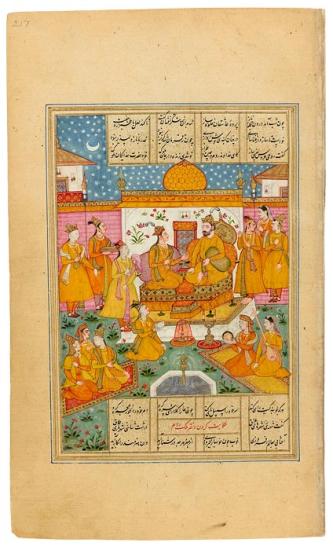
Bahrām Gūr and the Byzantine Princess Humāy in the Yellow Pavillion
Khamsa (Quintet), in Persian, written by Mullā Fatḥ Muḥammad
Purchased by Pierpont Morgan, 1910
This episode appears in the Haft Paikar (Seven Princesses), the last part (1197) of the Persian poet Niẓāmī's Khamsa (Quintet). It is essentially a romanticized biography of Bahrām Gūr, a Persian king (r. 421–438) and a renowned hunter and lover.
On Sunday, the day of the Sun, everybody is dressed in yellow. As evening approaches Humāy is asked to tell her story.
A king's horoscope told of the constant strife of marriage, so he bought slave girls instead. One day, however, he acquired a rare beauty, knowing that she refused to share her favors. Though they lived in harmony, he wished to learn why. She then explained she feared death because all her clanswomen had died during childbirth. He then loved her all the more because of her truthfulness. An evil old woman, who did not want the king to find happiness, then urged him to make her jealous, assuming the king would fall in love with the new slave girl she procured. But the evil plan failed, for his truthful slave admitted her love and yielded to a happy union.
The Seven Princesses
This episode appears in the Haft Paikar (Seven Princesses), the last part (1197) of the Persian poet Niẓāmī's Khamsa (Quintet). It is essentially a romanticized biography of Bahrām Gūr, a Persian king (r. 421–438) and a renowned hunter and lover.
One day, in his castle in Khavarnak, Bahrām Gūr comes across a secret room that had been overlooked by his keeper. After entering the room he sees portraits of seven princesses with whom he instantly falls in love. Among the portraits was one of a young man inscribed with his name, an omen of things to come. After receiving permission from their fathers, he marries them all, building for each a domed pavilion with a color scheme symbolizing the country from which each came. The colors also symbolize the days of the week and the planets for which they were named. Each princess is asked to tell a sensuous story matching the mood of the color. "Even as the planets move, so then shall I," says Bahrām, and "I will visit one pavilion a day from the first of the week to the last." He apparently followed the cycle for at least seven years.
Persian poetry
The Persians loved their poetry and their poets, though the Qur˒an warned against believing their words (sura 69.41) and "those straying in evil who follow them" (sura 26.224). While Arabic was the first language of Islam and the language of the Qur˒an, Persian was favored by poets. Even Firdausī's (940–1020) celebrated Shāhnāma (Book of Kings), the national epic of Persian, was written in verse—some 50,000 couplets! Rūmī (1207–1273), the best known of the Sufi poets, put poetry in perspective when he wrote, "A hundred thousand books of poetry existed / Before the word of the illiterate [Prophet] they were put to shame!" (Masnavī I, 529). Presented here are illustrations of Firdausī's Shāhnāma as well as works by Sa˓ dī (ca.1184–1292), Hāfiz (ca. 1320–1389), and Jāmī (1414–1492), regarded as the last of the great Sufi poets. Also featured are illustrations from each of the five poems of the Khamsa (Quintet), by Niẓāmī (ca. 1141–1209), especially Lailā and Majnūn (The Persian Romeo and Juliet) and Bahrām Gūr's Seven Princesses.
Bahrām Gūr and the Chinese Princess
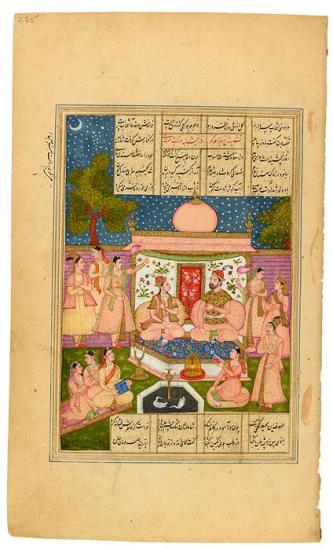
Bahrām Gūr and the Chinese Princess Yaghmānāz in the Sandalwood Pavilion
Khamsa (Quintet), in Persian, written by Mullā Fatḥ Muḥammad
Purchased by Pierpont Morgan, 1910
This episode appears in the Haft Paikar (Seven Princesses), the last part (1197) of the Persian poet Niẓāmī's Khamsa (Quintet). It is essentially a romanticized biography of Bahrām Gūr, a Persian king (r. 421–438) and a renowned hunter and lover.
On Thursday, the day of Jupiter, Bahrām visits the Chinese princess in her sandalwood pavilion and hears her story.
There were two desert travelers named Good and Evil. When Evil stole Good's water, he forced Good to give up his possessions and eyesight in order to regain it. But Good was saved by a Kurd, whose pulp from sandalwood leaves restored sight and healed epilepsy. After marrying the Kurd's daughter, Good used the leaves to cure the king's daughter of epilepsy, and she became his second wife. When he cured the vizier's blind daughter, he gained yet another wife. Good sometimes returned to the desert to savor the scent of sandalwood and always dressed in the color of its bark.
The Seven Princesses
This episode appears in the Haft Paikar (Seven Princesses), the last part (1197) of the Persian poet Niẓāmī's Khamsa (Quintet). It is essentially a romanticized biography of Bahrām Gūr, a Persian king (r. 421–438) and a renowned hunter and lover.
One day, in his castle in Khavarnak, Bahrām Gūr comes across a secret room that had been overlooked by his keeper. After entering the room he sees portraits of seven princesses with whom he instantly falls in love. Among the portraits was one of a young man inscribed with his name, an omen of things to come. After receiving permission from their fathers, he marries them all, building for each a domed pavilion with a color scheme symbolizing the country from which each came. The colors also symbolize the days of the week and the planets for which they were named. Each princess is asked to tell a sensuous story matching the mood of the color. "Even as the planets move, so then shall I," says Bahrām, and "I will visit one pavilion a day from the first of the week to the last." He apparently followed the cycle for at least seven years.
Persian poetry
The Persians loved their poetry and their poets, though the Qur˒an warned against believing their words (sura 69.41) and "those straying in evil who follow them" (sura 26.224). While Arabic was the first language of Islam and the language of the Qur˒an, Persian was favored by poets. Even Firdausī's (940–1020) celebrated Shāhnāma (Book of Kings), the national epic of Persian, was written in verse—some 50,000 couplets! Rūmī (1207–1273), the best known of the Sufi poets, put poetry in perspective when he wrote, "A hundred thousand books of poetry existed / Before the word of the illiterate [Prophet] they were put to shame!" (Masnavī I, 529). Presented here are illustrations of Firdausī's Shāhnāma as well as works by Sa˓ dī (ca.1184–1292), Hāfiz (ca. 1320–1389), and Jāmī (1414–1492), regarded as the last of the great Sufi poets. Also featured are illustrations from each of the five poems of the Khamsa (Quintet), by Niẓāmī (ca. 1141–1209), especially Lailā and Majnūn (The Persian Romeo and Juliet) and Bahrām Gūr's Seven Princesses.
Bahrām Gūr and the Persian Princess
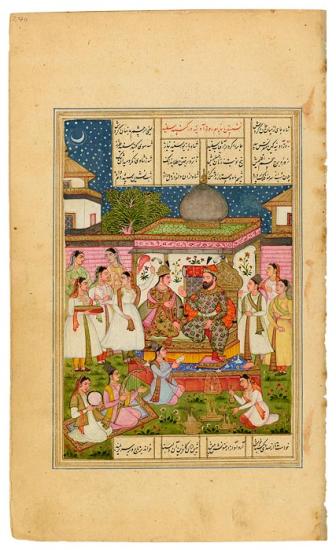
Bahrām Gūr and the Persian Princess Dursitī in the White Pavilion
Khamsa (Quintet), in Persian, written by Mullā Fatḥ Muḥammad
Purchased by Pierpont Morgan, 1910
This episode appears in the Haft Paikar (Seven Princesses), the last part (1197) of the Persian poet Niẓāmī's Khamsa (Quintet). It is essentially a romanticized biography of Bahrām Gūr, a Persian king (r. 421–438) and a renowned hunter and lover.
Since Friday is Venus's day, Bahrām wonders whether his seventh bride, having come from his own kingdom, will be the sweetest of all. Her story was passed down by her mother.
A handsome young owner of a garden surprised some women who were feasting in it. After determining that he was not a thief, they hid him, helping him to win the beauty of his choice. After his attempts at consummation were frustrated (the tree nook's floor collapsed, the tree branches broke, and a wolf chased foxes through the garden—all bad omens), he finally realized that the desired result could be obtained only through marriage.
The Seven Princesses
This episode appears in the Haft Paikar (Seven Princesses), the last part (1197) of the Persian poet Niẓāmī's Khamsa (Quintet). It is essentially a romanticized biography of Bahrām Gūr, a Persian king (r. 421–438) and a renowned hunter and lover.
One day, in his castle in Khavarnak, Bahrām Gūr comes across a secret room that had been overlooked by his keeper. After entering the room he sees portraits of seven princesses with whom he instantly falls in love. Among the portraits was one of a young man inscribed with his name, an omen of things to come. After receiving permission from their fathers, he marries them all, building for each a domed pavilion with a color scheme symbolizing the country from which each came. The colors also symbolize the days of the week and the planets for which they were named. Each princess is asked to tell a sensuous story matching the mood of the color. "Even as the planets move, so then shall I," says Bahrām, and "I will visit one pavilion a day from the first of the week to the last." He apparently followed the cycle for at least seven years.
Persian poetry
The Persians loved their poetry and their poets, though the Qur˒an warned against believing their words (sura 69.41) and "those straying in evil who follow them" (sura 26.224). While Arabic was the first language of Islam and the language of the Qur˒an, Persian was favored by poets. Even Firdausī's (940–1020) celebrated Shāhnāma (Book of Kings), the national epic of Persian, was written in verse—some 50,000 couplets! Rūmī (1207–1273), the best known of the Sufi poets, put poetry in perspective when he wrote, "A hundred thousand books of poetry existed / Before the word of the illiterate [Prophet] they were put to shame!" (Masnavī I, 529). Presented here are illustrations of Firdausī's Shāhnāma as well as works by Sa˓ dī (ca.1184–1292), Hāfiz (ca. 1320–1389), and Jāmī (1414–1492), regarded as the last of the great Sufi poets. Also featured are illustrations from each of the five poems of the Khamsa (Quintet), by Niẓāmī (ca. 1141–1209), especially Lailā and Majnūn (The Persian Romeo and Juliet) and Bahrām Gūr's Seven Princesses.
Bahrām Gūr and the Slavic Princess
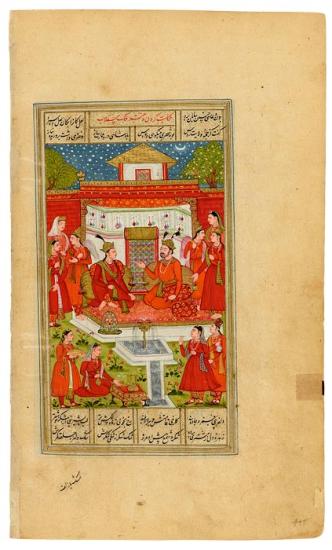
Bahrām Gūr and the Slavic and the Slavic Princess Nasrīnnosh in the Red Pavilion
Khamsa (Quintet), in Persian, written by Mullā Fatḥ Muḥammad
Purchased by Pierpont Morgan, 1910
This episode appears in the Haft Paikar (Seven Princesses), the last part (1197) of the Persian poet Niẓāmī's Khamsa (Quintet). It is essentially a romanticized biography of Bahrām Gūr, a Persian king (r. 421–438) and a renowned hunter and lover.
On Tuesday, the day of Mars, dressed in red, Bahrām Gūr visits the Red Pavilion. Bahrām, whose name is the Persian term for "Mars," is in his own domain as Nasrīnnosh tells her story.
In Russia there lived a princess so beautiful and learned that she was unable to find an equal. She agreed to accept a suitor who was of noble descent, able to disarm the talismans, find entry to her fortress, and solve four riddles. Those who failed were beheaded. One young suitor, however, with the help of an old man, won the prize and thereafter dressed in red.
The story became the prototype for Puccini's opera, Turandot, a popular name for girls in the Near East.
This episode appears in the Haft Paikar (Seven Princesses), the last part (1197) of the Persian poet Niẓāmī's Khamsa (Quintet). It is essentially a romanticized biography of Bahrām Gūr, a Persian king (r. 421–438) and a renowned hunter and lover.
On Tuesday, the day of Mars, dressed in red, Bahrām Gūr visits the Red Pavilion. Bahrām, whose name is the Persian term for "Mars," is in his own domain as Nasrīnnosh tells her story.
In Russia there lived a princess so beautiful and learned that she was unable to find an equal. She agreed to accept a suitor who was of noble descent, able to disarm the talismans, find entry to her fortress, and solve four riddles. Those who failed were beheaded. One young suitor, however, with the help of an old man, won the prize and thereafter dressed in red.
The story became the prototype for Puccini's opera, Turandot, a popular name for girls in the Near East.
Bahrām Gūr and the Tartar Princess

Bahrām Gūr and the Tartar Princess and the Tartar Princess Nāzpāri in the Green Pavilion
Khamsa (Quintet), in Persian, written by Mullā Fatḥ Muḥammad
Purchased by Pierpont Morgan, 1910
This episode appears in the Haft Paikar (Seven Princesses), the last part (1197) of the Persian poet Niẓāmī's Khamsa (Quintet). It is essentially a romanticized biography of Bahrām Gūr, a Persian king (r. 421–438) and a renowned hunter and lover.
On Monday, the day of the Moon, Bahrām Gūr, dressed in green, asks Nāzpāri for a story.
Good Bāshr, of the country of Rum, loved his books above women but was smitten by a beautiful woman whose face was revealed when a wind lifted her veil. Unable to open his books and forget her, he made a pilgrimage to Jerusalem. On the way back, he was joined by evil Malikha, a know-it-all. Not realizing a large vessel with a ceramic rim was a well, Malikha bathed in it and drowned. Bāshr buried him, gathered his valuables, and took them to Malikha's wife. When she lifted her veil, Bāshr recognized the face that had been revealed by the wind. With the wicked husband dead, the good Bāshr joyfully married his widow.
The Seven Princesses
This episode appears in the Haft Paikar (Seven Princesses), the last part (1197) of the Persian poet Niẓāmī's Khamsa (Quintet). It is essentially a romanticized biography of Bahrām Gūr, a Persian king (r. 421–438) and a renowned hunter and lover.
One day, in his castle in Khavarnak, Bahrām Gūr comes across a secret room that had been overlooked by his keeper. After entering the room he sees portraits of seven princesses with whom he instantly falls in love. Among the portraits was one of a young man inscribed with his name, an omen of things to come. After receiving permission from their fathers, he marries them all, building for each a domed pavilion with a color scheme symbolizing the country from which each came. The colors also symbolize the days of the week and the planets for which they were named. Each princess is asked to tell a sensuous story matching the mood of the color. "Even as the planets move, so then shall I," says Bahrām, and "I will visit one pavilion a day from the first of the week to the last." He apparently followed the cycle for at least seven years.
Persian poetry
The Persians loved their poetry and their poets, though the Qur˒an warned against believing their words (sura 69.41) and "those straying in evil who follow them" (sura 26.224). While Arabic was the first language of Islam and the language of the Qur˒an, Persian was favored by poets. Even Firdausī's (940–1020) celebrated Shāhnāma (Book of Kings), the national epic of Persian, was written in verse—some 50,000 couplets! Rūmī (1207–1273), the best known of the Sufi poets, put poetry in perspective when he wrote, "A hundred thousand books of poetry existed / Before the word of the illiterate [Prophet] they were put to shame!" (Masnavī I, 529). Presented here are illustrations of Firdausī's Shāhnāma as well as works by Sa˓ dī (ca.1184–1292), Hāfiz (ca. 1320–1389), and Jāmī (1414–1492), regarded as the last of the great Sufi poets. Also featured are illustrations from each of the five poems of the Khamsa (Quintet), by Niẓāmī (ca. 1141–1209), especially Lailā and Majnūn (The Persian Romeo and Juliet) and Bahrām Gūr's Seven Princesses.
The making of the Morgan's Islamic collection
 It was at the urging of his librarian, Belle da Costa Greene (1879–1950), that Pierpont Morgan purchased the core of his Islamic collection in 1911 and 1912. Greene had become Morgan's librarian in 1905 and continued working for his son, J. P. Morgan, Jr., after the senior Morgan's death in 1913. When the Pierpont Morgan Library was established in 1924, she was named its first director. Her role in developing the collection and transforming a private library into a major public institution cannot be overestimated. It could be said that the Morgan collection of Islamic manuscripts, in particular, was born of a love affair.
It was at the urging of his librarian, Belle da Costa Greene (1879–1950), that Pierpont Morgan purchased the core of his Islamic collection in 1911 and 1912. Greene had become Morgan's librarian in 1905 and continued working for his son, J. P. Morgan, Jr., after the senior Morgan's death in 1913. When the Pierpont Morgan Library was established in 1924, she was named its first director. Her role in developing the collection and transforming a private library into a major public institution cannot be overestimated. It could be said that the Morgan collection of Islamic manuscripts, in particular, was born of a love affair.
When Bernard Berenson, the eminent art historian, first met Greene at Pierpont Morgan's library in November 1908, it was love at first sight. During the summer of 1910, they saw the great exhibition of Islamic art in Munich together and were especially taken with the miniature paintings on view. This was not the first exhibition devoted to Islamic art—there were earlier ones in London, Paris, and Berlin—but it was certainly one of the most comprehensive, including carpets, weapons and armor, book arts, ceramics, jewelry, glass and crystal, works of stone, ivory, and wood, textiles, and metalwork. The catalogue listed 3278 entries, some consisting of several items. The frontispiece of the catalogue depicted Luitpold, Prince-regent of Bavaria, the exhibition's patron, and Pierpont Morgan was listed as a member of the organizing committee (no doubt owing to his friendship with Kaiser Wilhelm).
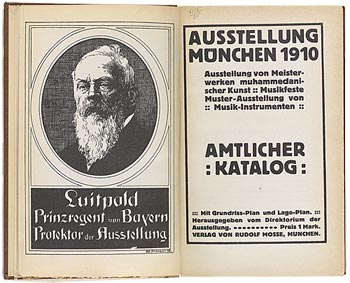 Is it any accident that Berenson formed a small collection of Islamic manuscripts between 1910 and 1913, and that Belle Greene, in early 1911, declared that she, too, wanted to assemble a fine personal collection? These were also the years during which Pierpont Morgan acquired his finest examples (guided, of course, by Belle Greene). After Morgan died in 1913, Greene wrote to Berenson that she feared that this line of collecting (Islamic manuscripts) was finished, just as she had "gotten her Mr. Morgan awakened to it." But Morgan's son, Jack, did go on to acquire a few early Qur˒ans.
Is it any accident that Berenson formed a small collection of Islamic manuscripts between 1910 and 1913, and that Belle Greene, in early 1911, declared that she, too, wanted to assemble a fine personal collection? These were also the years during which Pierpont Morgan acquired his finest examples (guided, of course, by Belle Greene). After Morgan died in 1913, Greene wrote to Berenson that she feared that this line of collecting (Islamic manuscripts) was finished, just as she had "gotten her Mr. Morgan awakened to it." But Morgan's son, Jack, did go on to acquire a few early Qur˒ans.
Many years after Berenson visited the Munich exhibition with Belle Greene, she was still on his mind. Before Greene's death, he wrote to Meta Harrsen, the Morgan's Keeper of Manuscripts, instructing her to "give my love to Belle and tell her a day seldom goes by that I do not think of her." And after Greene's death, he wrote again to Harrsen (on 29 May 1950), informing her that he wished he could have attended her funeral, saying that no one other than he could claim to be "chief mourner." Greene eventually bequeathed her own collection of Islamic manuscripts to the Morgan in 1950, thus bringing a second important group of works into the collection.
Image captions:
Laura Coombs Hills. Watercolor on ivory of Belle da Costa Greene, ca. 1910. Gift of the estate of Belle da Costa Greene, 1950.
Title page of Ausstellung Munchen 1910, the catalogue of the1910 Munich exhibition devoted to Islamic art. Gift of Belle da Costa Greene, 1935.


